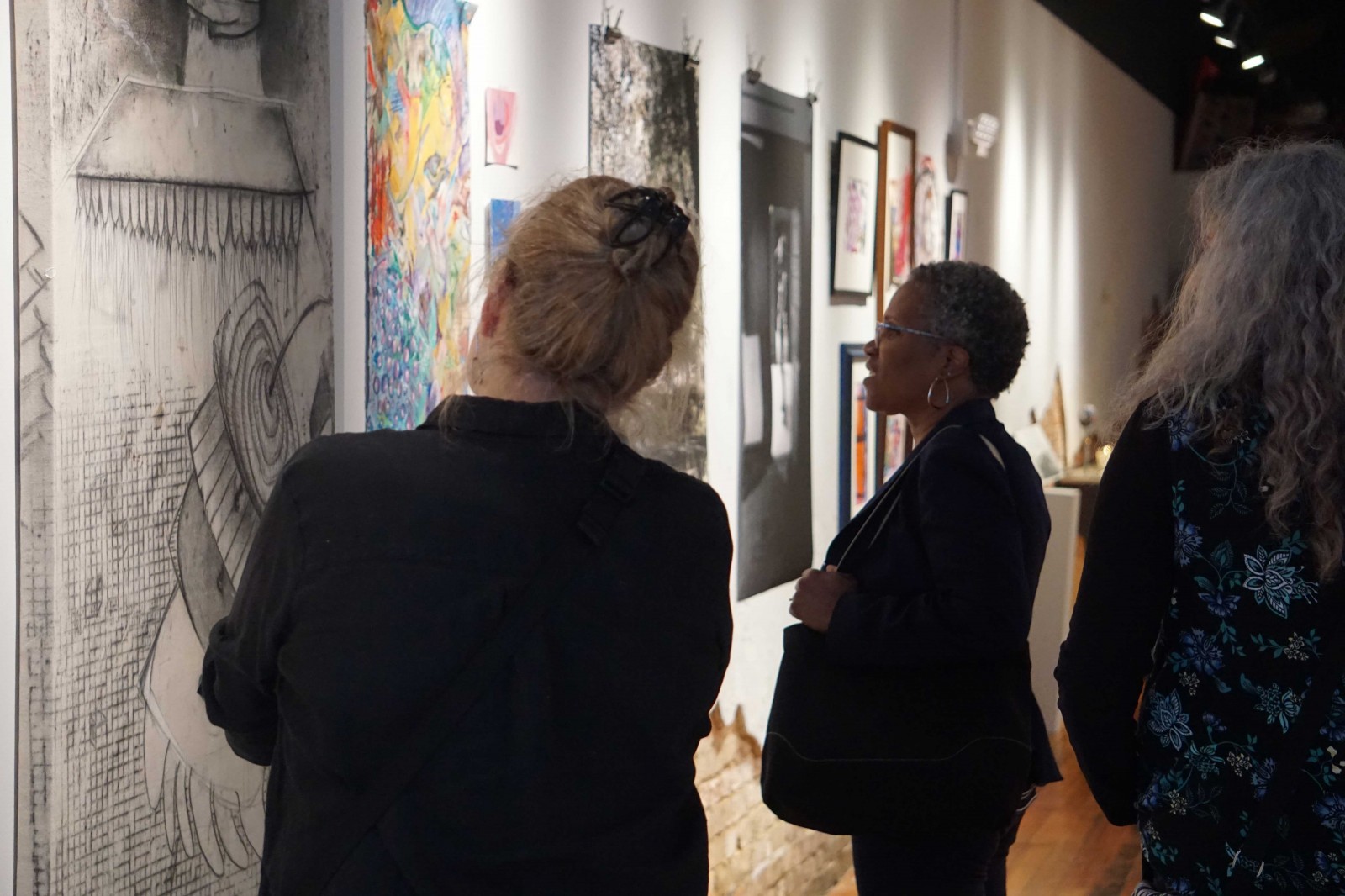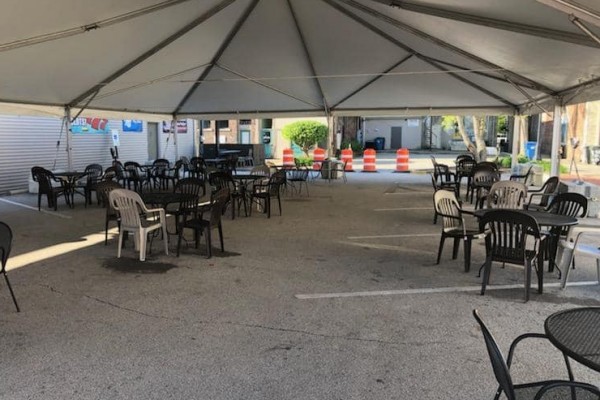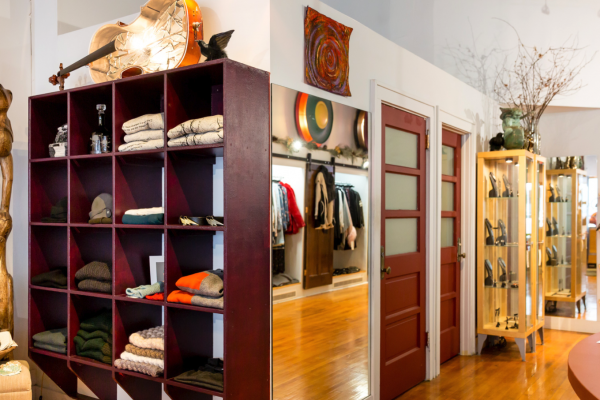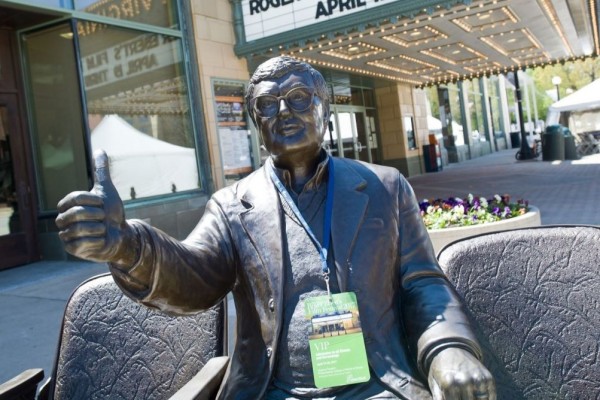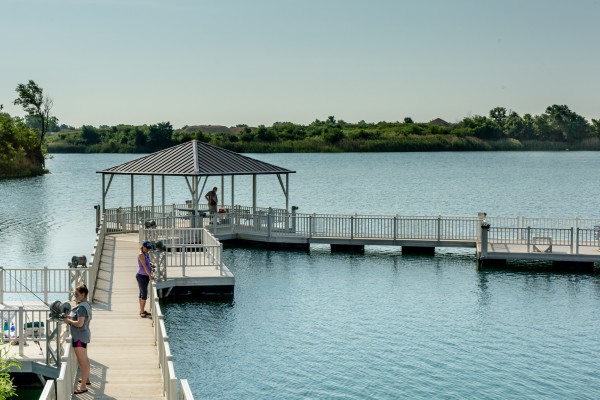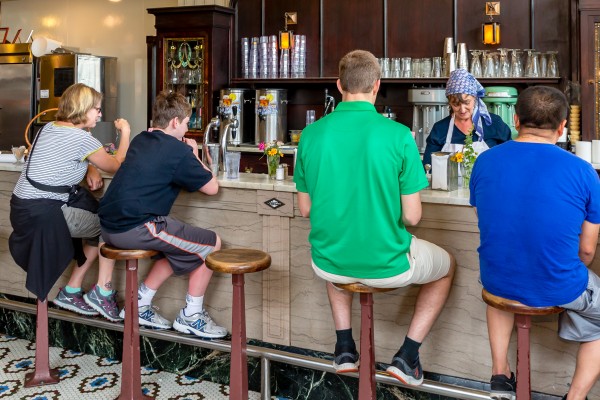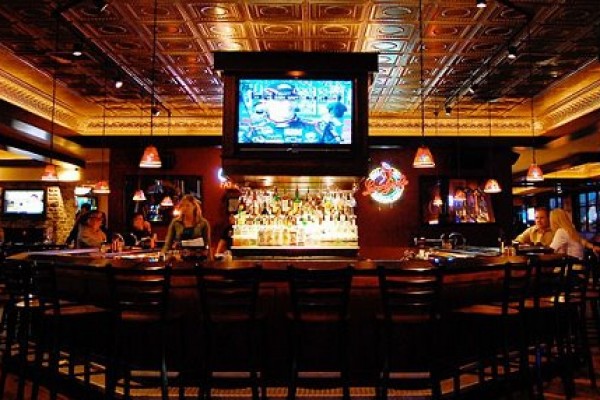
Champaign-Urbana Area Restaurants Open on Christmas
December 10, 2025
Plenty of Champaign-Urbana area restaurants are either open or offering catering—whether you’re celebrating Christmas, opting out, or just craving a great meal.
Read MoreChampaign-Urbana Area Restaurants Open on Christmas
December 10, 2025
Plenty of Champaign-Urbana area restaurants are either open or offering catering—whether you’re celebrating Christmas, opting out, or just craving a great meal.
Read More
Your Guide to Holiday Markets in the Champaign-Urbana Area
December 3, 2025
Whether we’re ready or not, the season of cocoa, twinkle lights, and handmade finds is here! From classic craft fairs to curated maker pop-ups, these area markets make it easy to shop small, discover local artists, and cross a few names off your list.
Read MoreYour Guide to Holiday Markets in the Champaign-Urbana Area
December 3, 2025
Whether we’re ready or not, the season of cocoa, twinkle lights, and handmade finds is here! From classic craft fairs to curated maker pop-ups, these area markets make it easy to shop small, discover local artists, and cross a few names off your list.
Read More
The 2025 Champaign-Urbana Area Holiday Shop Local Guide
November 24, 2025
The best gifts have a story—and around here, those stories start with local makers, indie shops, friendly faces, and those little quirks you just won’t find in the land of big boxes. When you shop small in the Champaign-Urbana area, you’re supporting families, dreams, and the creative spirit that makes this community brilliant.
Read MoreThe 2025 Champaign-Urbana Area Holiday Shop Local Guide
November 24, 2025
The best gifts have a story—and around here, those stories start with local makers, indie shops, friendly faces, and those little quirks you just won’t find in the land of big boxes. When you shop small in the Champaign-Urbana area, you’re supporting families, dreams, and the creative spirit that makes this community brilliant.
Read More
2025 Thanksgiving Day Restaurant Openings, Catering Options, & More in the Champaign-Urbana Area
November 7, 2025
Thanksgiving can be a full day—whether you’re celebrating with family, friends, neighbors, or flying solo. If you’re dining out, ordering catering, or just craving a holiday treat, here’s your guide to local spots ready to help you enjoy a delicious Thanksgiving.
Read More2025 Thanksgiving Day Restaurant Openings, Catering Options, & More in the Champaign-Urbana Area
November 7, 2025
Thanksgiving can be a full day—whether you’re celebrating with family, friends, neighbors, or flying solo. If you’re dining out, ordering catering, or just craving a holiday treat, here’s your guide to local spots ready to help you enjoy a delicious Thanksgiving.
Read More
Art Spaces, Galleries, & More in the Champaign-Urbana Area
November 6, 2025
Our community is built on a passion for arts & culture. From public art in our parks and urban districts to dedicated gallery spaces, you'll be inspired every day with these brilliant locations.
Read MoreArt Spaces, Galleries, & More in the Champaign-Urbana Area
November 6, 2025
Our community is built on a passion for arts & culture. From public art in our parks and urban districts to dedicated gallery spaces, you'll be inspired every day with these brilliant locations.
Read More
Top Outdoor Spots for Fall Around Champaign-Urbana
October 23, 2025
Discover some of the best spots for fall colors around Champaign-Urbana, whether you're downtown, on campus, in the forest preserves, or on a day trip!
Read MoreTop Outdoor Spots for Fall Around Champaign-Urbana
October 23, 2025
Discover some of the best spots for fall colors around Champaign-Urbana, whether you're downtown, on campus, in the forest preserves, or on a day trip!
Read More
Where to buy orange and blue in the Champaign-Urbana area
September 24, 2025
It wouldn’t be a CU football season without Fighting Illini gear. And with homecoming a few days away and a top-ranked team (let’s keep it that way!), you gotta stock up!
Read MoreWhere to buy orange and blue in the Champaign-Urbana area
September 24, 2025
It wouldn’t be a CU football season without Fighting Illini gear. And with homecoming a few days away and a top-ranked team (let’s keep it that way!), you gotta stock up!
Read More
A Welcoming Weekend in the Champaign-Urbana Area: Inclusive Spots Worth Traveling For
September 15, 2025
Make the most of your time in the Champaign-Urbana area, where Pride marches down the street in broad daylight, where a book-bar serves up queer poetry readings, where museums and performance spaces prioritize equity in the arts, and so much more.
Read MoreA Welcoming Weekend in the Champaign-Urbana Area: Inclusive Spots Worth Traveling For
September 15, 2025
Make the most of your time in the Champaign-Urbana area, where Pride marches down the street in broad daylight, where a book-bar serves up queer poetry readings, where museums and performance spaces prioritize equity in the arts, and so much more.
Read More
Harvest Gold: Autumn Adventures in the Champaign-Urbana Area
August 29, 2025
Take part in the Champaign-Urbana area's quintessential fall activities! Immerse yourself in our autumn agricultural experiences and animal adventures.
Read MoreHarvest Gold: Autumn Adventures in the Champaign-Urbana Area
August 29, 2025
Take part in the Champaign-Urbana area's quintessential fall activities! Immerse yourself in our autumn agricultural experiences and animal adventures.
Read More
Fall Festivals in the Champaign-Urbana Area
August 29, 2025
Autumn weekends in the Champaign-Urbana are filled with festivals and events, filling our days with music, food, art, and pride. Check out what’s coming up and make your plans to go to these must-attend events!
Read MoreFall Festivals in the Champaign-Urbana Area
August 29, 2025
Autumn weekends in the Champaign-Urbana are filled with festivals and events, filling our days with music, food, art, and pride. Check out what’s coming up and make your plans to go to these must-attend events!
Read More
Sips, Bites, & Autumn Nights: Fall Food in the Champaign-Urbana Area
August 29, 2025
When the leaves crisp up and the fields turn gold, the Champaign-Urbana area answers with warm, local comfort food. Graze your way through fall, from latte to last call.
Read MoreSips, Bites, & Autumn Nights: Fall Food in the Champaign-Urbana Area
August 29, 2025
When the leaves crisp up and the fields turn gold, the Champaign-Urbana area answers with warm, local comfort food. Graze your way through fall, from latte to last call.
Read More
Looking into the Future of Agriculture
August 20, 2025
Sitting off a rural road in East Urbana, you’ll see a sign for the Savanna Institute in what appears to be more acres of the agricultural landscape that we’re used to seeing outside of the urban center of Champaign-Urbana. Look a little closer, and you’ll discover the land is part of the Midwest’s largest agroforestry demonstration site, which started in 2022. On this 120-acre farm, the Savanna Institute, in collaboration with numerous partners, is stacking agricultural industries to work towards conservation and sustainability through a practice called alley cropping .
Read MoreLooking into the Future of Agriculture
August 20, 2025
Sitting off a rural road in East Urbana, you’ll see a sign for the Savanna Institute in what appears to be more acres of the agricultural landscape that we’re used to seeing outside of the urban center of Champaign-Urbana. Look a little closer, and you’ll discover the land is part of the Midwest’s largest agroforestry demonstration site, which started in 2022. On this 120-acre farm, the Savanna Institute, in collaboration with numerous partners, is stacking agricultural industries to work towards conservation and sustainability through a practice called alley cropping .
Read More
Your Perfect First Weekend in Champaign-Urbana
August 20, 2025
Welcome to Champaign-Urbana! Whether you’re brand-new to the University of Illinois or coming back after a summer away, your first weekend in town sets the tone for an unforgettable year. Lucky for you, our community rolls out the orange carpet with plenty of local flavor, music, food, and unique adventures. Here’s your play-by-play itinerary.
Read MoreYour Perfect First Weekend in Champaign-Urbana
August 20, 2025
Welcome to Champaign-Urbana! Whether you’re brand-new to the University of Illinois or coming back after a summer away, your first weekend in town sets the tone for an unforgettable year. Lucky for you, our community rolls out the orange carpet with plenty of local flavor, music, food, and unique adventures. Here’s your play-by-play itinerary.
Read More
Live & Local: Your Guide to Music Every Night in C-U
August 19, 2025
From nightly gigs to weekend festivals, here’s a peek at some of our favorite spots to tune in, hang out, and fall in love with the local music scene.
Read MoreLive & Local: Your Guide to Music Every Night in C-U
August 19, 2025
From nightly gigs to weekend festivals, here’s a peek at some of our favorite spots to tune in, hang out, and fall in love with the local music scene.
Read More
Back-to-College Eats: Champaign-Urbana’s Must-Try Food & Drink for Students
August 14, 2025
From beloved classics to creative new spots, our community offers flavors for every craving. Below, a guide to some of the restaurants that help make CU one of the Midwest’s best food towns, according to Midwest Living.
Read MoreBack-to-College Eats: Champaign-Urbana’s Must-Try Food & Drink for Students
August 14, 2025
From beloved classics to creative new spots, our community offers flavors for every craving. Below, a guide to some of the restaurants that help make CU one of the Midwest’s best food towns, according to Midwest Living.
Read More
Keep Summer Alive: A Before School Starts Bucket List for Kids
August 4, 2025
There’s plenty of time to keep summer alive before the kids go back to school, so we’ve compiled a before-school-starts bucket list for kids, including outdoor activities, amazing attractions, and some last-minute fun and games before the bell rings on the 2025-2026 school year.
Read MoreKeep Summer Alive: A Before School Starts Bucket List for Kids
August 4, 2025
There’s plenty of time to keep summer alive before the kids go back to school, so we’ve compiled a before-school-starts bucket list for kids, including outdoor activities, amazing attractions, and some last-minute fun and games before the bell rings on the 2025-2026 school year.
Read More
Exploring Champaign-Urbana: A Guide to Alumni and Student Favorites
August 4, 2025
If you’ve ever spent time in Champaign-Urbana, home to the University of Illinois, you know it’s more than a college town. Beyond the academics and iconic campus landmarks, CU boasts a variety of local haunts that have won the hearts of both students and alumni alike. Whether you’re a current student, a proud alum, or just passing through, these favorites are worth a visit.
Read MoreExploring Champaign-Urbana: A Guide to Alumni and Student Favorites
August 4, 2025
If you’ve ever spent time in Champaign-Urbana, home to the University of Illinois, you know it’s more than a college town. Beyond the academics and iconic campus landmarks, CU boasts a variety of local haunts that have won the hearts of both students and alumni alike. Whether you’re a current student, a proud alum, or just passing through, these favorites are worth a visit.
Read More
A Delightful Day in Arcola
July 22, 2025
Nestled just a half-hour south of Savoy, charming Arcola, nicknamed "Broomtown"—is a beautiful merge of history, culture, small-town warmth, and great eats.
Read MoreA Delightful Day in Arcola
July 22, 2025
Nestled just a half-hour south of Savoy, charming Arcola, nicknamed "Broomtown"—is a beautiful merge of history, culture, small-town warmth, and great eats.
Read More
Where to buy Local Art in the Champaign-Urbana Area
July 22, 2025
Looking to discover authentic, locally made art in the Champaign-Urbana area? Here are some galleries and events where you can purchase creative, one-of-a-kind works—perfect for collectors, gift-givers, or anyone who appreciates the local arts scene!
Read MoreWhere to buy Local Art in the Champaign-Urbana Area
July 22, 2025
Looking to discover authentic, locally made art in the Champaign-Urbana area? Here are some galleries and events where you can purchase creative, one-of-a-kind works—perfect for collectors, gift-givers, or anyone who appreciates the local arts scene!
Read More
Seven Self-Guided Tours to Explore in Champaign-Urbana
July 8, 2025
Whether you’re an art lover, a history buff, film lover, or want to learn more about the Champaign-Urbana area, here are seven self-guided tours you can participate in to get your discovery fix.
Read MoreSeven Self-Guided Tours to Explore in Champaign-Urbana
July 8, 2025
Whether you’re an art lover, a history buff, film lover, or want to learn more about the Champaign-Urbana area, here are seven self-guided tours you can participate in to get your discovery fix.
Read More
Sip Back & Relax: 5 Places for Summer Mocktails in the Champaign-Urbana Area
July 8, 2025
Whether you're sober-curious, taking a break, or just love a beautifully crafted beverage without the buzz, the Champaign-Urbana area’s growing scene of zero-proof sips will keep you cool and refreshed. Here are a few community favorites:
Read MoreSip Back & Relax: 5 Places for Summer Mocktails in the Champaign-Urbana Area
July 8, 2025
Whether you're sober-curious, taking a break, or just love a beautifully crafted beverage without the buzz, the Champaign-Urbana area’s growing scene of zero-proof sips will keep you cool and refreshed. Here are a few community favorites:
Read More
Firework Displays, Parades and More in the Champaign-Urbana Area
June 24, 2025
Our region comes alive around the 4th of July with parades, family-friendly festivities, and spectacular fireworks displays. Whether you’re looking for small-town charm or big community events, here’s where to catch the best celebrations in the Champaign-Urbana area.
Read MoreFirework Displays, Parades and More in the Champaign-Urbana Area
June 24, 2025
Our region comes alive around the 4th of July with parades, family-friendly festivities, and spectacular fireworks displays. Whether you’re looking for small-town charm or big community events, here’s where to catch the best celebrations in the Champaign-Urbana area.
Read More
Savor the Season: Patio Dining Spots in the Champaign-Urbana Area
June 24, 2025
As sunshine and warm breezes pick up in the summer time, patio season is officially in full swing. Whether you're catching up with friends, enjoying a date night, or grabbing a solo bite with your sunglasses on, Champaign-Urbana and the surrounding area offer plenty of great spots to dine outdoors. Here are a few of our favorite patios to check out this season:
Read MoreSavor the Season: Patio Dining Spots in the Champaign-Urbana Area
June 24, 2025
As sunshine and warm breezes pick up in the summer time, patio season is officially in full swing. Whether you're catching up with friends, enjoying a date night, or grabbing a solo bite with your sunglasses on, Champaign-Urbana and the surrounding area offer plenty of great spots to dine outdoors. Here are a few of our favorite patios to check out this season:
Read More
Juneteenth in the Champaign-Urbana Area
June 9, 2025
Juneteenth, commemorating the day when the last enslaved African Americans were freed in Galveston, Texas in 1865, is a deeply meaningful holiday rooted in liberation, resilience, and cultural significance—especially on a local level. Here in the Champaign-Urbana area, Juneteenth isn’t just observed—it’s honored through music, art, education, and community. Here’s a closer look at how CU is celebrating Juneteenth in 2025!
Read MoreJuneteenth in the Champaign-Urbana Area
June 9, 2025
Juneteenth, commemorating the day when the last enslaved African Americans were freed in Galveston, Texas in 1865, is a deeply meaningful holiday rooted in liberation, resilience, and cultural significance—especially on a local level. Here in the Champaign-Urbana area, Juneteenth isn’t just observed—it’s honored through music, art, education, and community. Here’s a closer look at how CU is celebrating Juneteenth in 2025!
Read More
Soak Up Summer in Champaign-Urbana
May 13, 2025
Summer in Champaign-Urbana includes a wealth of experiences waiting to be discovered. While the students are away, come play and see what you’ve been missing. From daily live music to the tantalizing flavors of local delicacies and the boundless outdoor adventures, our brilliant Illinois community offers an array of opportunities to savor the season.
Read MoreSoak Up Summer in Champaign-Urbana
May 13, 2025
Summer in Champaign-Urbana includes a wealth of experiences waiting to be discovered. While the students are away, come play and see what you’ve been missing. From daily live music to the tantalizing flavors of local delicacies and the boundless outdoor adventures, our brilliant Illinois community offers an array of opportunities to savor the season.
Read More
Pride Month Events in the Champaign-Urbana Area
May 12, 2025
We invite you to check out some of these queer-friendly events in the Champaign-Urbana area for the entire month of June!
Read MorePride Month Events in the Champaign-Urbana Area
May 12, 2025
We invite you to check out some of these queer-friendly events in the Champaign-Urbana area for the entire month of June!
Read More
Savoring the Local Pour: Champaign-Urbana Area Breweries
May 12, 2025
Across Champaign County, breweries are turning hops and grains into works of art. Here's your guide to savoring them.
Read MoreSavoring the Local Pour: Champaign-Urbana Area Breweries
May 12, 2025
Across Champaign County, breweries are turning hops and grains into works of art. Here's your guide to savoring them.
Read More
Dive into Summer: 2025 Pool Openings in the Champaign-Urbana Area
May 9, 2025
As the temperatures rise and the days grow longer, it’s time to plan your summer splashes! Here’s a roundup of public pool openings in the Champaign-Urbana area for summer 2025.
Read MoreDive into Summer: 2025 Pool Openings in the Champaign-Urbana Area
May 9, 2025
As the temperatures rise and the days grow longer, it’s time to plan your summer splashes! Here’s a roundup of public pool openings in the Champaign-Urbana area for summer 2025.
Read More
C-U Outside! Five Unique Champaign-Urbana Area Trails
April 29, 2025
CU is full of incredible options for walking and running among stunning naturescapes. We’re highlighting five unique trails that showcase the diverse outdoor experiences our area offers, whether you're looking for stargazing spots, art-filled walks, or interactive family fun!
Read MoreC-U Outside! Five Unique Champaign-Urbana Area Trails
April 29, 2025
CU is full of incredible options for walking and running among stunning naturescapes. We’re highlighting five unique trails that showcase the diverse outdoor experiences our area offers, whether you're looking for stargazing spots, art-filled walks, or interactive family fun!
Read More
Shop Local: Farmers’ Markets in the Champaign-Urbana Area
April 29, 2025
Get ready to fill your baskets with the freshest local produce, artisanal goods, and community spirit! Here’s your comprehensive guide to the 2025 farmers market season in Champaign, Urbana, Homer, Mahomet, and Monticello.
Read MoreShop Local: Farmers’ Markets in the Champaign-Urbana Area
April 29, 2025
Get ready to fill your baskets with the freshest local produce, artisanal goods, and community spirit! Here’s your comprehensive guide to the 2025 farmers market season in Champaign, Urbana, Homer, Mahomet, and Monticello.
Read More
Business Spotlight: Page Roasting Company
April 18, 2025
Situated off the beautiful Boneyard Creek Basin, in between campus and downtown Champaign, Page Roasting Company, owned and operated by Erin Erdman, has created a safe and accessible place to enjoy a cup of coffee. How Erin got there is a story of a passion for coffee and the food industry that came from her father.
Read MoreBusiness Spotlight: Page Roasting Company
April 18, 2025
Situated off the beautiful Boneyard Creek Basin, in between campus and downtown Champaign, Page Roasting Company, owned and operated by Erin Erdman, has created a safe and accessible place to enjoy a cup of coffee. How Erin got there is a story of a passion for coffee and the food industry that came from her father.
Read More
Ebertfest: A Celebration of Cinema in the Champaign-Urbana Area
April 15, 2025
Each year in the Champaign-Urbana area, cinephiles from around the world gather for a remarkable celebration of film at the Roger Ebert Film Festival. This annual event, also known as Ebertfest, is a tribute to the legendary film critic Roger Ebert and a testament to the enduring power of storytelling through film.
Read MoreEbertfest: A Celebration of Cinema in the Champaign-Urbana Area
April 15, 2025
Each year in the Champaign-Urbana area, cinephiles from around the world gather for a remarkable celebration of film at the Roger Ebert Film Festival. This annual event, also known as Ebertfest, is a tribute to the legendary film critic Roger Ebert and a testament to the enduring power of storytelling through film.
Read More
This Week’s Egg-stra Special Events in the Champaign-Urbana Area
April 15, 2025
Whether you're hopping from one event to the next or settling in for your local favorite, this week is packed with ways to celebrate. Grab your basket, your bunny ears, and your sense of adventure—spring is officially here!
Read MoreThis Week’s Egg-stra Special Events in the Champaign-Urbana Area
April 15, 2025
Whether you're hopping from one event to the next or settling in for your local favorite, this week is packed with ways to celebrate. Grab your basket, your bunny ears, and your sense of adventure—spring is officially here!
Read More
Mom’s Weekend in the Champaign-Urbana Area
March 20, 2025
Mom's Weekend is all about celebrating the amazing moms, mother figures, and guardians who support their students every step of the way. Whether you're here to explore campus, enjoy local dining, getting out into nature, diving into arts and culture, or simply spending quality time together, there’s something for everyone.
Read MoreMom’s Weekend in the Champaign-Urbana Area
March 20, 2025
Mom's Weekend is all about celebrating the amazing moms, mother figures, and guardians who support their students every step of the way. Whether you're here to explore campus, enjoy local dining, getting out into nature, diving into arts and culture, or simply spending quality time together, there’s something for everyone.
Read More
Photography Spots to Visit During Spring in the Champaign-Urbana Area
March 5, 2025
Whether you’re looking to participate in family portraits, photograph flora and fauna, or you simply want to elevate your selfie game, here are 10 photography spots to visit during springtime in the Champaign-Urbana Area
Read MorePhotography Spots to Visit During Spring in the Champaign-Urbana Area
March 5, 2025
Whether you’re looking to participate in family portraits, photograph flora and fauna, or you simply want to elevate your selfie game, here are 10 photography spots to visit during springtime in the Champaign-Urbana Area
Read More
Top Events for Spring in the Champaign-Urbana Area
March 3, 2025
Whether you’re exploring local art, participating in cultural showcases, joining a fun run through the city streets, or witnessing the magnificence of colorful blooms, there are countless springtime experiences for every interest and every age in the Champaign-Urbana area.
Read MoreTop Events for Spring in the Champaign-Urbana Area
March 3, 2025
Whether you’re exploring local art, participating in cultural showcases, joining a fun run through the city streets, or witnessing the magnificence of colorful blooms, there are countless springtime experiences for every interest and every age in the Champaign-Urbana area.
Read More
Places to get Halal Meals in Champaign-Urbana
February 17, 2025
Whether you're a University of Illinois Urbana-Champaign searching for a quick bite in between classes, a local resident craving comfort food, or a visitor exploring the area, this blog is your guide to the best halal-friendly restaurants in CU!
Read MorePlaces to get Halal Meals in Champaign-Urbana
February 17, 2025
Whether you're a University of Illinois Urbana-Champaign searching for a quick bite in between classes, a local resident craving comfort food, or a visitor exploring the area, this blog is your guide to the best halal-friendly restaurants in CU!
Read More
Celebrating Valentine’s Day Weekend in the Champaign-Urbana Area
February 10, 2025
Valentine’s Day is just around the corner, and the Champaign-Urbana area offers a variety of romantic activities and dining options to make your celebration special. Here’s a guide to help you plan the perfect Valentine’s Day in the Champaign-Urbana area!
Read MoreCelebrating Valentine’s Day Weekend in the Champaign-Urbana Area
February 10, 2025
Valentine’s Day is just around the corner, and the Champaign-Urbana area offers a variety of romantic activities and dining options to make your celebration special. Here’s a guide to help you plan the perfect Valentine’s Day in the Champaign-Urbana area!
Read More
Exploring the Champaign-Urbana Area Post-Holiday Season
January 30, 2025
Here’s a glimpse into how to make the most of your time in the Champaign-Urbana Area this post-holiday season!
Read MoreExploring the Champaign-Urbana Area Post-Holiday Season
January 30, 2025
Here’s a glimpse into how to make the most of your time in the Champaign-Urbana Area this post-holiday season!
Read More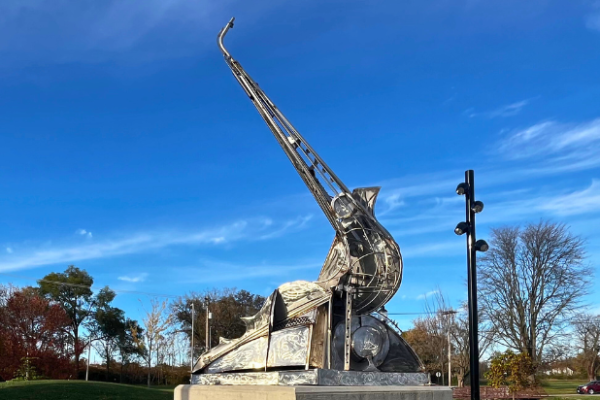
Celebrate Black History Month in the Champaign-Urbana Area
January 29, 2025
February marks the beginning of Black History Month, a time to honor the contributions and rich cultural heritage of African Americans. From running the oldest business district in the City of Champaign to the first all-Black fighter squadron, known as the 99th Pursuit Squadron, who would later be known as the Tuskegee Airmen, African-Americans directly shaped the place we call home. This month is embraced with a variety of events and celebrations that highlight our community’s vibrant history and ongoing impact.
Read MoreCelebrate Black History Month in the Champaign-Urbana Area
January 29, 2025
February marks the beginning of Black History Month, a time to honor the contributions and rich cultural heritage of African Americans. From running the oldest business district in the City of Champaign to the first all-Black fighter squadron, known as the 99th Pursuit Squadron, who would later be known as the Tuskegee Airmen, African-Americans directly shaped the place we call home. This month is embraced with a variety of events and celebrations that highlight our community’s vibrant history and ongoing impact.
Read More
Christmas Restaurant Openings in the Champaign-Urbana Area
December 17, 2024
Whether you’re visiting, passing by, or a resident who is need of an open restaurant on Christmas Day—we got you covered! Happy Holidays from your friends over at Experience Champaign-Urbana!
Read MoreChristmas Restaurant Openings in the Champaign-Urbana Area
December 17, 2024
Whether you’re visiting, passing by, or a resident who is need of an open restaurant on Christmas Day—we got you covered! Happy Holidays from your friends over at Experience Champaign-Urbana!
Read More
Holiday Happenings in the Champaign-Urbana Area
November 22, 2024
The holiday season is a magical time in the Champaign-Urbana area, with a mix of small-town charm and vibrant community events. Whether you’re a long-time resident or just visiting, there’s plenty to see, do, and experience. Here’s your guide to the most festive happenings this year!
Read MoreHoliday Happenings in the Champaign-Urbana Area
November 22, 2024
The holiday season is a magical time in the Champaign-Urbana area, with a mix of small-town charm and vibrant community events. Whether you’re a long-time resident or just visiting, there’s plenty to see, do, and experience. Here’s your guide to the most festive happenings this year!
Read More
2024 Thanksgiving Day Restaurant Openings and Catering Options in the Champaign-Urbana Area
November 19, 2024
Thanksgiving is a busy day for families, and not just for those who are cooking! Whether you're looking to dine out, order catering for the family, or satisfy that holiday sweet-tooth, here's a guide of places & caterers that you could grab a meal on Thanksgiving!
Read More2024 Thanksgiving Day Restaurant Openings and Catering Options in the Champaign-Urbana Area
November 19, 2024
Thanksgiving is a busy day for families, and not just for those who are cooking! Whether you're looking to dine out, order catering for the family, or satisfy that holiday sweet-tooth, here's a guide of places & caterers that you could grab a meal on Thanksgiving!
Read More
The 2024 Champaign-Urbana Area Holiday Shop Local Guide
November 18, 2024
Here it is: Your ultimate guide to shopping local and making this holiday season a memorable one! Whether you’re splurging or saving, the Champaign-Urbana area’s local shops and festive markets offer an astounding number of gift options to bring joy to your loved ones (you might even want to keep some for yourself!).
Read MoreThe 2024 Champaign-Urbana Area Holiday Shop Local Guide
November 18, 2024
Here it is: Your ultimate guide to shopping local and making this holiday season a memorable one! Whether you’re splurging or saving, the Champaign-Urbana area’s local shops and festive markets offer an astounding number of gift options to bring joy to your loved ones (you might even want to keep some for yourself!).
Read More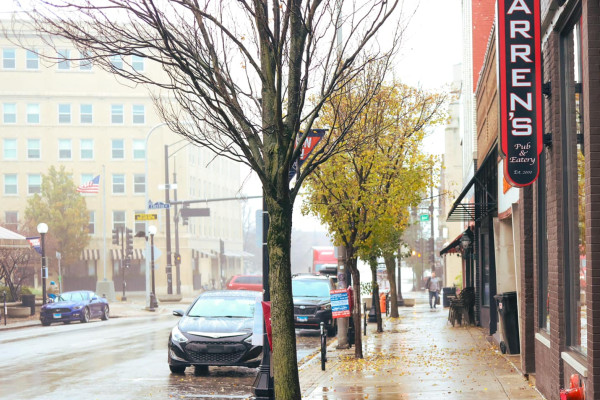
Six Ways to Recharge During Fall in Champaign-Urbana
October 17, 2024
Fall is usually met with fanfare: The blushy hues of the leaves, the chilly air, soup season, sweater weather, (and we can’t forget Pumpkin Spice season)—but to some, it feels overwhelming, and that means taking extra care for your mental health. Luckily, we belong in a community that offers many ways to nurture your mind, body and soul. From comfort food to taking a stroll at one of our vibrant parks, here are six ways you can recharge your mental health in Champaign-Urbana.
Read MoreSix Ways to Recharge During Fall in Champaign-Urbana
October 17, 2024
Fall is usually met with fanfare: The blushy hues of the leaves, the chilly air, soup season, sweater weather, (and we can’t forget Pumpkin Spice season)—but to some, it feels overwhelming, and that means taking extra care for your mental health. Luckily, we belong in a community that offers many ways to nurture your mind, body and soul. From comfort food to taking a stroll at one of our vibrant parks, here are six ways you can recharge your mental health in Champaign-Urbana.
Read More
Places to Enjoy Happy Hour
October 17, 2024
If you’re looking for a great spot to unwind after a long day, you’re in luck! Whether you’re in the mood for a casual pint, craft cocktails, or wine by the glass, the Champaign-Urbana area offers plenty of fantastic happy hour deals that cater to every taste.
Read MorePlaces to Enjoy Happy Hour
October 17, 2024
If you’re looking for a great spot to unwind after a long day, you’re in luck! Whether you’re in the mood for a casual pint, craft cocktails, or wine by the glass, the Champaign-Urbana area offers plenty of fantastic happy hour deals that cater to every taste.
Read More
Restaurants to try for Hispanic Heritage Month 2024
September 1, 2024
In honor of Hispanic Heritage Month, we’ve compiled a short list of the top restaurants you should try throughout September and October.
Read MoreRestaurants to try for Hispanic Heritage Month 2024
September 1, 2024
In honor of Hispanic Heritage Month, we’ve compiled a short list of the top restaurants you should try throughout September and October.
Read More
Ways to Play in the Champaign-Urbana Area
August 29, 2024
From enriching educational experiences like the Engineering Open House to thrilling outdoor adventures, here's a comprehensive guide on ways to play (for all ages!) in the Champaign-Urbana area.
Read MoreWays to Play in the Champaign-Urbana Area
August 29, 2024
From enriching educational experiences like the Engineering Open House to thrilling outdoor adventures, here's a comprehensive guide on ways to play (for all ages!) in the Champaign-Urbana area.
Read More
7 Things you Should Try as a New Student at the University of Illinois Urbana-Champaign
August 15, 2024
We understand how daunting it can be to get adjusted to the new “home away from home” as a new student at the University of Illinois Urbana-Champaign. Here is a short list of experiences you should try as you settle-in for your first year!
Read More7 Things you Should Try as a New Student at the University of Illinois Urbana-Champaign
August 15, 2024
We understand how daunting it can be to get adjusted to the new “home away from home” as a new student at the University of Illinois Urbana-Champaign. Here is a short list of experiences you should try as you settle-in for your first year!
Read More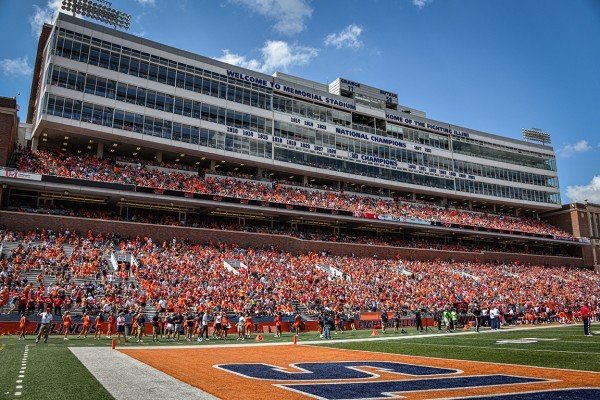
Turning Your Tailgate into an Orange & Blue Weekend
August 9, 2024
Tailgating is a way of life in Champaign-Urbana, with Fighting Illini Football weekends taking center stage from September–November. The party doesn’t have to stop with game day. Take your orange & blue pride and make a weekend visit on the University of Illinois campus and beyond.
Read MoreTurning Your Tailgate into an Orange & Blue Weekend
August 9, 2024
Tailgating is a way of life in Champaign-Urbana, with Fighting Illini Football weekends taking center stage from September–November. The party doesn’t have to stop with game day. Take your orange & blue pride and make a weekend visit on the University of Illinois campus and beyond.
Read More
Five Ways to Enjoy Fall in Champaign-Urbana
August 6, 2024
There’s something electric in the air when fall hits in Champaign-Urbana. With the return of University of Illinois students, the atmosphere around the community has an energy that can’t be matched. Fall activities from outdoor hikes to incredible festivals make this Big Ten college town a must-visit. Here’s our top five ways to get in on the fall fun.
Read MoreFive Ways to Enjoy Fall in Champaign-Urbana
August 6, 2024
There’s something electric in the air when fall hits in Champaign-Urbana. With the return of University of Illinois students, the atmosphere around the community has an energy that can’t be matched. Fall activities from outdoor hikes to incredible festivals make this Big Ten college town a must-visit. Here’s our top five ways to get in on the fall fun.
Read More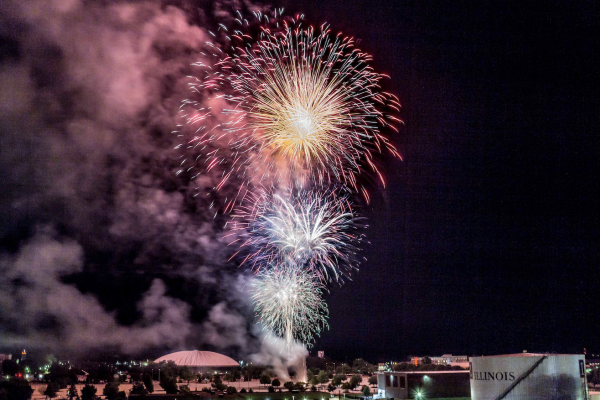
4th of July Celebrations in the Champaign-Urbana Area
June 20, 2024
Fourth of July events in the Champaign-Urbana area start as early as June 30th this year! Here's your guide to the major celebrations, parades, and fireworks displays taking place this year.
Read More4th of July Celebrations in the Champaign-Urbana Area
June 20, 2024
Fourth of July events in the Champaign-Urbana area start as early as June 30th this year! Here's your guide to the major celebrations, parades, and fireworks displays taking place this year.
Read More
Spotlight: Uniting Pride with Nicole Frydman
May 27, 2024
With over 15 years championing the needs of our local LGBTQ+ community, I sat down with Nicole Frydman, Director of Operations of the UP Center, to learn more about United Pride’s history, programming, and her role in helping sustain such an important organization in our community at large.
Read MoreSpotlight: Uniting Pride with Nicole Frydman
May 27, 2024
With over 15 years championing the needs of our local LGBTQ+ community, I sat down with Nicole Frydman, Director of Operations of the UP Center, to learn more about United Pride’s history, programming, and her role in helping sustain such an important organization in our community at large.
Read More
Cicadas in CU: What to Know and Where to Find Them
May 6, 2024
We stopped by at the Natural Resources Building at the University of Illinois to get more insight on the cicadas, where to find them, how to contribute to their research, where to celebrate this momentous occasion, and much more!
Read MoreCicadas in CU: What to Know and Where to Find Them
May 6, 2024
We stopped by at the Natural Resources Building at the University of Illinois to get more insight on the cicadas, where to find them, how to contribute to their research, where to celebrate this momentous occasion, and much more!
Read More
Popular Trails and Outdoor Spaces to Visit Outside of the Champaign-Urbana Area
April 29, 2024
Whether you’re a hiker, bike-rider, dog walker, or simply an outdoor enthusiast, we’ve compiled some trails well-worth the drive for you to visit outside the greater Champaign-Urbana area.
Read MorePopular Trails and Outdoor Spaces to Visit Outside of the Champaign-Urbana Area
April 29, 2024
Whether you’re a hiker, bike-rider, dog walker, or simply an outdoor enthusiast, we’ve compiled some trails well-worth the drive for you to visit outside the greater Champaign-Urbana area.
Read More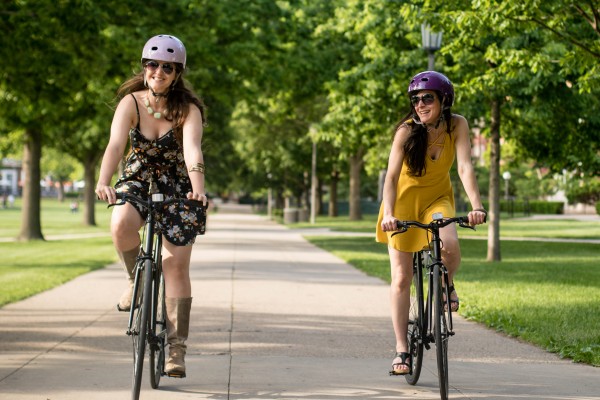
Bike Paths to Explore This Spring and Summer in the Champaign-Urbana Area
April 26, 2024
From the historic Kickapoo Rail Trail to adventures waiting for you along farmlands, neighborhoods, and forests, the Champaign-Urbana area is a hot spot for Midwest bike enthusiasts. Here are a few paths and trails to check out.
Read MoreBike Paths to Explore This Spring and Summer in the Champaign-Urbana Area
April 26, 2024
From the historic Kickapoo Rail Trail to adventures waiting for you along farmlands, neighborhoods, and forests, the Champaign-Urbana area is a hot spot for Midwest bike enthusiasts. Here are a few paths and trails to check out.
Read More
Roger Ebert's Favorite Films (And Where to Stream Them)
April 1, 2024
Roger Ebert looms large in the greater Champaign County area to this day. Read his favorite films and find them on streaming services at home!
Read MoreRoger Ebert's Favorite Films (And Where to Stream Them)
April 1, 2024
Roger Ebert looms large in the greater Champaign County area to this day. Read his favorite films and find them on streaming services at home!
Read More
Ways to Explore the Outdoors in Champaign-Urbana
March 12, 2024
Rediscover the bountiful outdoor spaces to explore, whether you want to hike along area rivers, kayak on our lakes, or camp under the stars.
Read MoreWays to Explore the Outdoors in Champaign-Urbana
March 12, 2024
Rediscover the bountiful outdoor spaces to explore, whether you want to hike along area rivers, kayak on our lakes, or camp under the stars.
Read More
Hot Spots to Get Your Art & Music Fix
March 12, 2024
Arts & culture are the foundation of the greater Champaign-Urbana area. At every turn, you’ll find public art sculptures, murals, live music, and local art. Spring and summer are the ideal times to get out and enjoy this vibrant scene, with options to explore both indoor and outdoor spaces. We’re giving you our top recommendations for outdoor live music, opportunities to shop local art, and what museums to visit.
Read MoreHot Spots to Get Your Art & Music Fix
March 12, 2024
Arts & culture are the foundation of the greater Champaign-Urbana area. At every turn, you’ll find public art sculptures, murals, live music, and local art. Spring and summer are the ideal times to get out and enjoy this vibrant scene, with options to explore both indoor and outdoor spaces. We’re giving you our top recommendations for outdoor live music, opportunities to shop local art, and what museums to visit.
Read More
Top Spots to Enjoy Champaign-Urbana's Local Flavors
March 12, 2024
Farms, large and small, surround our micro-urban community, providing fresh ingredients for local chefs to incorporate into their menus and for us to prepare at home. Here’s where you can enjoy or pick up the freshest ingredients of the season to support our local food system.
Read MoreTop Spots to Enjoy Champaign-Urbana's Local Flavors
March 12, 2024
Farms, large and small, surround our micro-urban community, providing fresh ingredients for local chefs to incorporate into their menus and for us to prepare at home. Here’s where you can enjoy or pick up the freshest ingredients of the season to support our local food system.
Read More
Women-Owned Businesses to Support and Shop in the Champaign-Urbana Area
February 19, 2024
Shopping women-owned businesses helps to support the creative, innovative women in the Champaign-Urbana Area community who run our favorite shops and stores.
Read MoreWomen-Owned Businesses to Support and Shop in the Champaign-Urbana Area
February 19, 2024
Shopping women-owned businesses helps to support the creative, innovative women in the Champaign-Urbana Area community who run our favorite shops and stores.
Read More
Stay Comfortably in Champaign-Urbana
February 8, 2024
Regardless of what brings you to our brilliant community, we have ample choices to lay your head at the end of what we hope is a good day in the Champaign-Urbana area. With over 45 hotels, bed & breakfasts, camping, and a few unique overnight destinations, we have a cozy place to curl up for the night.
Read MoreStay Comfortably in Champaign-Urbana
February 8, 2024
Regardless of what brings you to our brilliant community, we have ample choices to lay your head at the end of what we hope is a good day in the Champaign-Urbana area. With over 45 hotels, bed & breakfasts, camping, and a few unique overnight destinations, we have a cozy place to curl up for the night.
Read More
Top Events for Spring & Summer in Champaign-Urbana
February 7, 2024
Don’t just cross off days on your calendar. Enjoy every day by getting out in the Champaign-Urbana area. Spring and summer bring daily events and major festivals for every interest and every age. What are you waiting for? Make your plans today!
Read MoreTop Events for Spring & Summer in Champaign-Urbana
February 7, 2024
Don’t just cross off days on your calendar. Enjoy every day by getting out in the Champaign-Urbana area. Spring and summer bring daily events and major festivals for every interest and every age. What are you waiting for? Make your plans today!
Read More
Black History Month in the Champaign-Urbana Area
January 18, 2024
We compiled a growing list of BHM events, as well as Black-owned businesses and restaurants to support all-year-round!
Read MoreBlack History Month in the Champaign-Urbana Area
January 18, 2024
We compiled a growing list of BHM events, as well as Black-owned businesses and restaurants to support all-year-round!
Read More
Communal Comforts to Tackle Post-Holiday Blues
January 9, 2024
From sipping on locally roasted coffee to buying your next favorite read, here are some communal comforts to tackle the post-holiday blues.
Read MoreCommunal Comforts to Tackle Post-Holiday Blues
January 9, 2024
From sipping on locally roasted coffee to buying your next favorite read, here are some communal comforts to tackle the post-holiday blues.
Read More
Savoring Spring: A Culinary Tour of Champaign-Urbana's Local Flavors
January 3, 2024
As we await the vibrant hues of spring to emerge in Champaign-Urbana, we can plan to enjoy the do the flavors of the season. From farmers' markets bursting with fresh produce to local eateries crafting seasonal delights, our community offers a culinary adventure for foodies. Here’s the top spots showcasing local foods that make springtime in Champaign-Urbana an irresistible feast.
Read MoreSavoring Spring: A Culinary Tour of Champaign-Urbana's Local Flavors
January 3, 2024
As we await the vibrant hues of spring to emerge in Champaign-Urbana, we can plan to enjoy the do the flavors of the season. From farmers' markets bursting with fresh produce to local eateries crafting seasonal delights, our community offers a culinary adventure for foodies. Here’s the top spots showcasing local foods that make springtime in Champaign-Urbana an irresistible feast.
Read More
Restaurant Openings During Christmas in the Champaign-Urbana Area (2023)
December 18, 2023
If you’re not planning on cooking this Christmas, the Champaign-Urbana area is full of options for dining out!
Read MoreRestaurant Openings During Christmas in the Champaign-Urbana Area (2023)
December 18, 2023
If you’re not planning on cooking this Christmas, the Champaign-Urbana area is full of options for dining out!
Read More
New Year Celebrations in the Champaign-Urbana Area 2023
December 11, 2023
From local cuisine, live entertainment, to arts and crafts and celebrations during the day, here's a glimpse into the vibrant New Years celebrations in the Champaign-Urbana area.
Read MoreNew Year Celebrations in the Champaign-Urbana Area 2023
December 11, 2023
From local cuisine, live entertainment, to arts and crafts and celebrations during the day, here's a glimpse into the vibrant New Years celebrations in the Champaign-Urbana area.
Read More
Where to Witness Holiday Lights in the Champaign-Urbana Area
November 16, 2023
Here’s your guide to experiencing the most enchanting holiday lights in the Champaign-Urbana area!
Read MoreWhere to Witness Holiday Lights in the Champaign-Urbana Area
November 16, 2023
Here’s your guide to experiencing the most enchanting holiday lights in the Champaign-Urbana area!
Read More
The 2023 Champaign-Urbana Area Holiday Shop Local Guide
November 15, 2023
Embrace the spirit of the season and make this holiday truly special by supporting local businesses in the Champaign-Urbana area. Here’s your ultimate guide to shopping local and making this holiday season a memorable one!
Read MoreThe 2023 Champaign-Urbana Area Holiday Shop Local Guide
November 15, 2023
Embrace the spirit of the season and make this holiday truly special by supporting local businesses in the Champaign-Urbana area. Here’s your ultimate guide to shopping local and making this holiday season a memorable one!
Read More
Top 15 Halloween Events to Spook up the Champaign-Urbana Area
October 17, 2023
Dive into the spooky spirit with our list of Halloween events in the Champaign-Urbana area!
Read MoreTop 15 Halloween Events to Spook up the Champaign-Urbana Area
October 17, 2023
Dive into the spooky spirit with our list of Halloween events in the Champaign-Urbana area!
Read More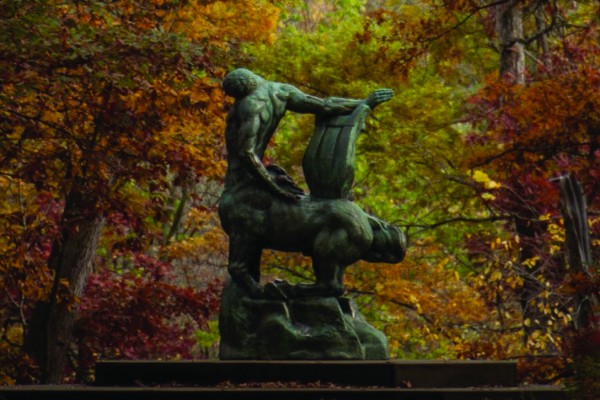
Top Outdoor Spots for Fall
October 9, 2023
With a little chill in the air, and the leaves starting to change, fall is the ideal time to explore the outdoors. From spotting the best fall foliage to seeing the changing night sky, we’ve got the best spots for your fall outdoor adventures.
Read MoreTop Outdoor Spots for Fall
October 9, 2023
With a little chill in the air, and the leaves starting to change, fall is the ideal time to explore the outdoors. From spotting the best fall foliage to seeing the changing night sky, we’ve got the best spots for your fall outdoor adventures.
Read More
Great Spots for Fall Photoshoots
September 21, 2023
Whether you’re looking for professional portraits or just looking to up your Instagram game, we’ve got your guide to the five best spots for fall photoshoots in the Champaign-Urbana area! With so many incredibly scenic spots around our area, plus iconic locations that make for a great backdrop, every inch of the agricultural adventures, parks, and outdoor areas in our area hit their peak in Fall.
Read MoreGreat Spots for Fall Photoshoots
September 21, 2023
Whether you’re looking for professional portraits or just looking to up your Instagram game, we’ve got your guide to the five best spots for fall photoshoots in the Champaign-Urbana area! With so many incredibly scenic spots around our area, plus iconic locations that make for a great backdrop, every inch of the agricultural adventures, parks, and outdoor areas in our area hit their peak in Fall.
Read More
A Guide to Half Century of Progress 2023
August 14, 2023
Half Century of Progress is one of the largest farm shows in the country. This year, it returns to Rantoul and is certain to be something curious onlookers will want to check out!
Read MoreA Guide to Half Century of Progress 2023
August 14, 2023
Half Century of Progress is one of the largest farm shows in the country. This year, it returns to Rantoul and is certain to be something curious onlookers will want to check out!
Read More
Top places to Exercise Outside in the Champaign-Urbana Area
July 10, 2023
With an area so rich in nature, it's no surprise we're a popular destination for fitness enthusiasts! From biking, jogging, to yoga and pilates, you'll find a few places where you can go and get your sweat on.
Read MoreTop places to Exercise Outside in the Champaign-Urbana Area
July 10, 2023
With an area so rich in nature, it's no surprise we're a popular destination for fitness enthusiasts! From biking, jogging, to yoga and pilates, you'll find a few places where you can go and get your sweat on.
Read More
A Guide to Historic Farm Days (2023)
July 3, 2023
At the I&I Antique Tractor & Gas Engine Club Showgrounds, attendees will see a ton of amazing things, so be sure not to miss these 8 highlights over the four-day Historic Farm Days in Penfield.
Read MoreA Guide to Historic Farm Days (2023)
July 3, 2023
At the I&I Antique Tractor & Gas Engine Club Showgrounds, attendees will see a ton of amazing things, so be sure not to miss these 8 highlights over the four-day Historic Farm Days in Penfield.
Read More
Juneteenth: Where to Celebrate in the Greater Champaign-Urbana Area
June 13, 2023
Here are a few Juneteenth events to look forward to as you commemorate the significance and importance of this holiday.
Read MoreJuneteenth: Where to Celebrate in the Greater Champaign-Urbana Area
June 13, 2023
Here are a few Juneteenth events to look forward to as you commemorate the significance and importance of this holiday.
Read More
Five Ways to Celebrate Dad this Father's Day Weekend
June 13, 2023
If you’re looking for some inspiration for Father's Day plans, there’s plenty to do in the greater Champaign County this weekend, some of which is specifically themed around that special guy in your life.
Read MoreFive Ways to Celebrate Dad this Father's Day Weekend
June 13, 2023
If you’re looking for some inspiration for Father's Day plans, there’s plenty to do in the greater Champaign County this weekend, some of which is specifically themed around that special guy in your life.
Read More
BUSINESS SPOTLIGHT: THE HIVE
May 18, 2023
I sat down with Jessica Trefzger, proud owner and founder of The Hive by Maple Street Garden, to learn more about The Hive’s story and how she fostered a bee-loving, nature-loving community here in Mahomet.
Read MoreBUSINESS SPOTLIGHT: THE HIVE
May 18, 2023
I sat down with Jessica Trefzger, proud owner and founder of The Hive by Maple Street Garden, to learn more about The Hive’s story and how she fostered a bee-loving, nature-loving community here in Mahomet.
Read More
Top Places to Spend Time with Animals in the Greater Champaign County Area
April 11, 2023
From exotic animals like Alaskan Reindeer & zebra to cuddly baby goats, here are some places where you can spend time with animals in the Greater Champaign County area!
Read MoreTop Places to Spend Time with Animals in the Greater Champaign County Area
April 11, 2023
From exotic animals like Alaskan Reindeer & zebra to cuddly baby goats, here are some places where you can spend time with animals in the Greater Champaign County area!
Read More
It's Time to Boneyard
April 10, 2023
Each spring, we get a big reminder of how vibrant and talented our arts community is in the greater Champaign-Urbana area thanks to the Boneyard Arts Festival. An event like no other, this festival, happening April 14–16, takes place across over 70 venues countywide, showcasing hundreds of local artists. The goal is to create collaboration between artists and showcase the community, allowing us to visit spaces we’ve never been to and witness the creativity from the many artists that call this area home. Terri previews her top ten to help with your Boneyard plan!
Read MoreIt's Time to Boneyard
April 10, 2023
Each spring, we get a big reminder of how vibrant and talented our arts community is in the greater Champaign-Urbana area thanks to the Boneyard Arts Festival. An event like no other, this festival, happening April 14–16, takes place across over 70 venues countywide, showcasing hundreds of local artists. The goal is to create collaboration between artists and showcase the community, allowing us to visit spaces we’ve never been to and witness the creativity from the many artists that call this area home. Terri previews her top ten to help with your Boneyard plan!
Read More
St. Patrick's Day Events in the Greater Champaign County Area
March 7, 2023
Live performances, tasty Reuben sandwiches, a green light glow, and so much more—the greater Champaign County area is capturing the essence of St. Patrick’s Day with a variety of events this year! If you’re looking to celebrate St. Patrick’s Day, check out this list below.
Read MoreSt. Patrick's Day Events in the Greater Champaign County Area
March 7, 2023
Live performances, tasty Reuben sandwiches, a green light glow, and so much more—the greater Champaign County area is capturing the essence of St. Patrick’s Day with a variety of events this year! If you’re looking to celebrate St. Patrick’s Day, check out this list below.
Read More
Business Spotlight: Art Mart
March 3, 2023
It wasn’t always easy to start a women-owned business. Just ask Linda Ballard about her experience when seeking a loan for their small business, Art Mart, which is now the oldest women-owned business in Champaign County and the second oldest in the state of Illinois.
Read MoreBusiness Spotlight: Art Mart
March 3, 2023
It wasn’t always easy to start a women-owned business. Just ask Linda Ballard about her experience when seeking a loan for their small business, Art Mart, which is now the oldest women-owned business in Champaign County and the second oldest in the state of Illinois.
Read More
Cold-Weather Goods to Keep You Warm and Comfy
February 21, 2023
From stocking up for sweater weather to comfort items to keep you cozy, here are some cold-weather goods that you rely on to get you through the final stretch of winter.
Read MoreCold-Weather Goods to Keep You Warm and Comfy
February 21, 2023
From stocking up for sweater weather to comfort items to keep you cozy, here are some cold-weather goods that you rely on to get you through the final stretch of winter.
Read More
Spotlight: Kreative Vision Photography
February 15, 2023
Evette Campbell, owner and founder of Kreative Vision Photography, is a seven-time published photographer and a natural born creative. Get to know Evette through her journey into photography in this greater Champaign County Area business spotlight!
Read MoreSpotlight: Kreative Vision Photography
February 15, 2023
Evette Campbell, owner and founder of Kreative Vision Photography, is a seven-time published photographer and a natural born creative. Get to know Evette through her journey into photography in this greater Champaign County Area business spotlight!
Read More
Love is in the Air Throughout the Greater Champaign County Area!
February 8, 2023
From spending an intimate date night with your sweetie at the Literary to cozying up at the Rose Bowl accompanied by live music—regardless of your spirit for Valentine’s Day, we have a fun list of events for you to check out during one of the loveliest times of the year.
Read MoreLove is in the Air Throughout the Greater Champaign County Area!
February 8, 2023
From spending an intimate date night with your sweetie at the Literary to cozying up at the Rose Bowl accompanied by live music—regardless of your spirit for Valentine’s Day, we have a fun list of events for you to check out during one of the loveliest times of the year.
Read More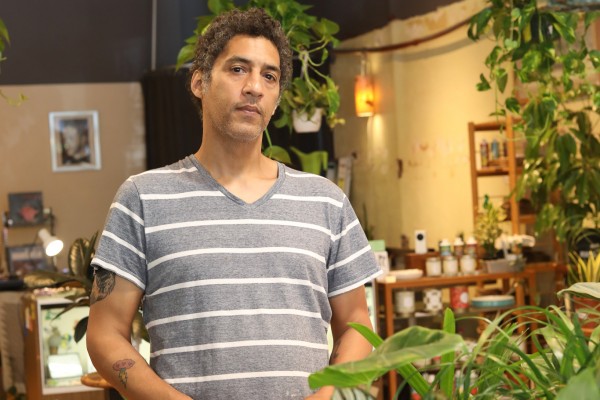
Spotlight: Plant Mode
February 1, 2023
If you asked Matthis if he would ever have envisioned having his retail shop, Plant Mode, on Walnut St., one of the main roads heading through downtown, he wouldn't have believed it. To understand how he got there, you have to go on a little journey with him.
Read MoreSpotlight: Plant Mode
February 1, 2023
If you asked Matthis if he would ever have envisioned having his retail shop, Plant Mode, on Walnut St., one of the main roads heading through downtown, he wouldn't have believed it. To understand how he got there, you have to go on a little journey with him.
Read More
What is Plan for Vacation Day?
January 30, 2023
There's a lot that goes into why vacation matters, so let's walk through some of the big things to know about National Plan for Vacation Day.
Read MoreWhat is Plan for Vacation Day?
January 30, 2023
There's a lot that goes into why vacation matters, so let's walk through some of the big things to know about National Plan for Vacation Day.
Read More
Terri's 42 Reasons for Being Excited about Restaurant Week
January 24, 2023
As the 7th Annual Champaign County Area Restaurant Week approaches, Terri shares tips to get the most out of the nine-day celebration, and highlights what is making her excited about this year's event.
Read MoreTerri's 42 Reasons for Being Excited about Restaurant Week
January 24, 2023
As the 7th Annual Champaign County Area Restaurant Week approaches, Terri shares tips to get the most out of the nine-day celebration, and highlights what is making her excited about this year's event.
Read More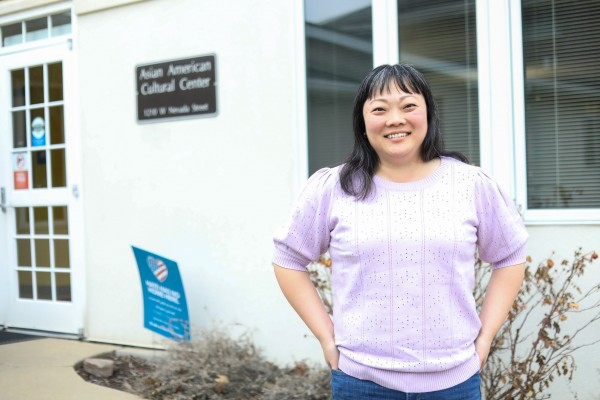
Lunar New Year Celebrations at UIUC and Beyond
January 18, 2023
We sat down with Dr. Sang Lee, Assistant Director of the Asian American Cultural Center (AACC) at the University of Illinois, to get more insight on this important holiday, what it looks like throughout UIUC campus, and what events to look out for during the Lunar New Year festivities.
Read MoreLunar New Year Celebrations at UIUC and Beyond
January 18, 2023
We sat down with Dr. Sang Lee, Assistant Director of the Asian American Cultural Center (AACC) at the University of Illinois, to get more insight on this important holiday, what it looks like throughout UIUC campus, and what events to look out for during the Lunar New Year festivities.
Read More
14 Family-Friendly Events for the Month of January
January 4, 2023
We have plenty of family-friendly events for the month of January in Champaign County!
Read More14 Family-Friendly Events for the Month of January
January 4, 2023
We have plenty of family-friendly events for the month of January in Champaign County!
Read More
10 Local NYE Events to Ring in the New Year 2022
December 27, 2022
From live music to dancing, fanfare or something lowkey—C-U has a variety of options to ring in the New Year!
Read More10 Local NYE Events to Ring in the New Year 2022
December 27, 2022
From live music to dancing, fanfare or something lowkey—C-U has a variety of options to ring in the New Year!
Read More
2022 Champaign County Christmas Restaurant Openings and Catering Options
December 16, 2022
If you’re not planning on cooking this Christmas, the greater Champaign County area is full of options for dining out!
Read More2022 Champaign County Christmas Restaurant Openings and Catering Options
December 16, 2022
If you’re not planning on cooking this Christmas, the greater Champaign County area is full of options for dining out!
Read More
Events to keep Yourself Entertained During Winter Break
December 14, 2022
It may feel like there's not much to do in the greater Champaign County Area during Winter Break, but that's far from the truth! Here are a few recommendations to ensure you're entertained during this period.
Read MoreEvents to keep Yourself Entertained During Winter Break
December 14, 2022
It may feel like there's not much to do in the greater Champaign County Area during Winter Break, but that's far from the truth! Here are a few recommendations to ensure you're entertained during this period.
Read More
5 Ways to Enjoy December in the Greater Champaign County Area
November 30, 2022
We compiled a short list of activities you can enjoy in the greater Champaign County Area this month, just to make your search a little bit easier.
Read More5 Ways to Enjoy December in the Greater Champaign County Area
November 30, 2022
We compiled a short list of activities you can enjoy in the greater Champaign County Area this month, just to make your search a little bit easier.
Read More
2022 Champaign County Shop Local Guide
November 23, 2022
Tis’ the season to be out shopping! It’s time to throw on your favorite sweater, some comfy shoes, and get ready to spend your way across the greater Champaign County area!
Read More2022 Champaign County Shop Local Guide
November 23, 2022
Tis’ the season to be out shopping! It’s time to throw on your favorite sweater, some comfy shoes, and get ready to spend your way across the greater Champaign County area!
Read More
Fall Comfort Items to Find Around Champaign County
November 11, 2022
The leaves may be disappearing, but our love for Fall-themed items is still going strong! Here are a few of our favorite seasonal comfort items as we head into the end of Fall!
Read MoreFall Comfort Items to Find Around Champaign County
November 11, 2022
The leaves may be disappearing, but our love for Fall-themed items is still going strong! Here are a few of our favorite seasonal comfort items as we head into the end of Fall!
Read More
2022 Thanksgiving Day Restaurant Openings and Catering Options in Champaign County
November 11, 2022
Skip the kitchen stress and opt for a meal at a local restaurant this year! Here' who will be open on Thanksgiving Day!
Read More2022 Thanksgiving Day Restaurant Openings and Catering Options in Champaign County
November 11, 2022
Skip the kitchen stress and opt for a meal at a local restaurant this year! Here' who will be open on Thanksgiving Day!
Read More
Top Spots to Take Your Dad for Dad’s Weekend
November 1, 2022
We compiled a short list of top spots to take your Dad for Dad’s Weekend so they can have the best of both worlds: The Pride of being an Illini guardian, and the joy knowing Chambana is full of experiences for every visit!
Read MoreTop Spots to Take Your Dad for Dad’s Weekend
November 1, 2022
We compiled a short list of top spots to take your Dad for Dad’s Weekend so they can have the best of both worlds: The Pride of being an Illini guardian, and the joy knowing Chambana is full of experiences for every visit!
Read More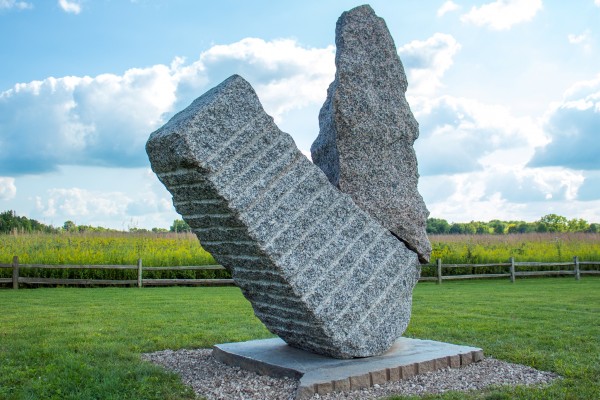
25 Years of the Wandell Sculpture Garden
October 24, 2022
In commemoration of the 25th Year Anniversary of the Wandell Sculpture Garden, I sat down with Tim Bartlett, the Superintendent of Planning and Operations at Urbana Park District, and Janet Soesbe, the Community Program Manager at Urbana Park District, to discuss everything from the Garden’s history, its vision, how it has evolved over all these years, and what’s next for the Sculpture Garden.
Read More25 Years of the Wandell Sculpture Garden
October 24, 2022
In commemoration of the 25th Year Anniversary of the Wandell Sculpture Garden, I sat down with Tim Bartlett, the Superintendent of Planning and Operations at Urbana Park District, and Janet Soesbe, the Community Program Manager at Urbana Park District, to discuss everything from the Garden’s history, its vision, how it has evolved over all these years, and what’s next for the Sculpture Garden.
Read More
5 Ways to Recharge During Fall in Champaign-Urbana
October 10, 2022
From comfort food to taking a stroll at one of our vibrant parks, here are 5 ways you can recharge your mental health in Champaign-Urbana
Read More5 Ways to Recharge During Fall in Champaign-Urbana
October 10, 2022
From comfort food to taking a stroll at one of our vibrant parks, here are 5 ways you can recharge your mental health in Champaign-Urbana
Read More
Celebrating 35 Years of the Staerkel Planetarium
September 29, 2022
As the second-largest planetarium in the state with a robust history that spans over 35 years, I sat down with former Director of the Staerkel Planetarium, David Leake, and the current Planetarium Director, Erik Johnson, to get more insight behind the iconic dome, the Zeiss Star projector, and programming we all know and love today.
Read MoreCelebrating 35 Years of the Staerkel Planetarium
September 29, 2022
As the second-largest planetarium in the state with a robust history that spans over 35 years, I sat down with former Director of the Staerkel Planetarium, David Leake, and the current Planetarium Director, Erik Johnson, to get more insight behind the iconic dome, the Zeiss Star projector, and programming we all know and love today.
Read More
Guide to pride Fest 2024
September 21, 2022
Uniting Pride of Champaign County is showing out for this year’s C-U Pride Fest, gifting us with an array of events spanning from education, art, movie screenings, dancing, and of course–the coveted C-U Pride Parade!
Read MoreGuide to pride Fest 2024
September 21, 2022
Uniting Pride of Champaign County is showing out for this year’s C-U Pride Fest, gifting us with an array of events spanning from education, art, movie screenings, dancing, and of course–the coveted C-U Pride Parade!
Read More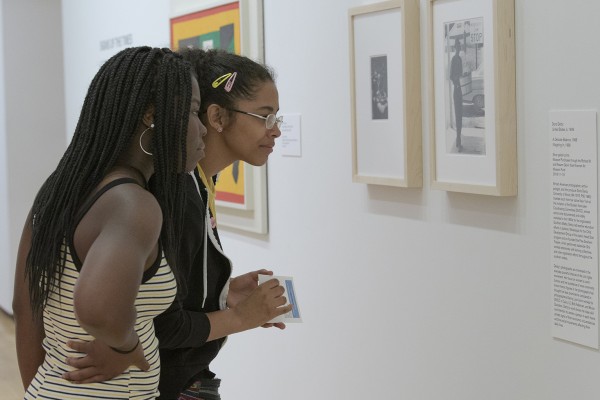
5 Things I enjoy About the Krannert Art Museum
September 20, 2022
As the second largest general fine art museum in the state of Illinois, I had to make another stop in light of National Museum Day on the 17th of September.
Read More5 Things I enjoy About the Krannert Art Museum
September 20, 2022
As the second largest general fine art museum in the state of Illinois, I had to make another stop in light of National Museum Day on the 17th of September.
Read More
Top Restaurants to try for Hispanic Heritage Month 2022
September 16, 2022
In honor of Hispanic Heritage Month, we’ve compiled a short list of the top restaurants you should try throughout September and October.
Read MoreTop Restaurants to try for Hispanic Heritage Month 2022
September 16, 2022
In honor of Hispanic Heritage Month, we’ve compiled a short list of the top restaurants you should try throughout September and October.
Read More
Top Outdoor Spots for Fall
September 1, 2022
With a little chill in the air, and the leaves starting to change, fall is the ideal time to explore the outdoors. From spotting the best fall foliage to seeing the changing night sky, we’ve got the best spots for your fall outdoor adventures.
Read MoreTop Outdoor Spots for Fall
September 1, 2022
With a little chill in the air, and the leaves starting to change, fall is the ideal time to explore the outdoors. From spotting the best fall foliage to seeing the changing night sky, we’ve got the best spots for your fall outdoor adventures.
Read More
My 1st Illini Football Game
August 29, 2022
If you’re a long-term resident of CU and you’ve never been to an Illini game, or if you’re new to town or a new student looking experience Orange & Blue pride, this blog may be right for you.
Read MoreMy 1st Illini Football Game
August 29, 2022
If you’re a long-term resident of CU and you’ve never been to an Illini game, or if you’re new to town or a new student looking experience Orange & Blue pride, this blog may be right for you.
Read More
Bring on the Beer
August 19, 2022
Across the greater Champaign County area, local breweries make art out of brewing. From all corners of Champaign County, you can find a beer that suits your tastes. Head to the tap room or pick up a growler to enjoy these crafted beverages.
Read MoreBring on the Beer
August 19, 2022
Across the greater Champaign County area, local breweries make art out of brewing. From all corners of Champaign County, you can find a beer that suits your tastes. Head to the tap room or pick up a growler to enjoy these crafted beverages.
Read More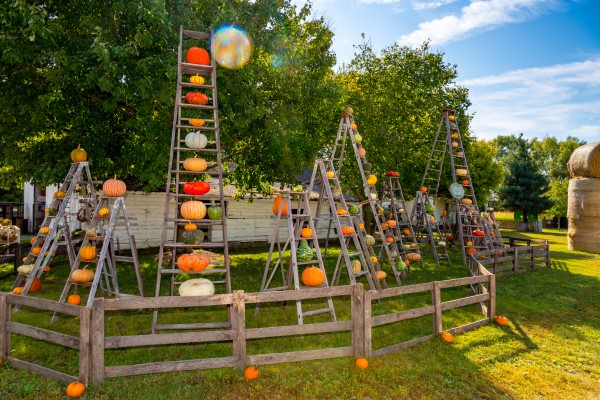
Five Must-Do Activities for Fall
August 19, 2022
From sneaking a peak at the fall foliage to picking pumpkins, you’ll find countless activities to fill your autumn days. We’ve got five experiences that you can’t miss in the greater Champaign County area this fall.
Read MoreFive Must-Do Activities for Fall
August 19, 2022
From sneaking a peak at the fall foliage to picking pumpkins, you’ll find countless activities to fill your autumn days. We’ve got five experiences that you can’t miss in the greater Champaign County area this fall.
Read More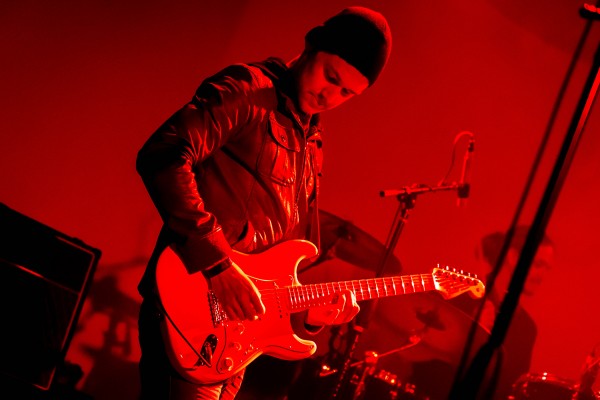
Festivals for All this Autumn
August 19, 2022
Weekends in the Champaign-Urbana are filled with festivals and events to attend, filling our days with music, food, art, and pride. Check out what’s coming up and make your plans for your weekend visit around these must-attend events!
Read MoreFestivals for All this Autumn
August 19, 2022
Weekends in the Champaign-Urbana are filled with festivals and events to attend, filling our days with music, food, art, and pride. Check out what’s coming up and make your plans for your weekend visit around these must-attend events!
Read More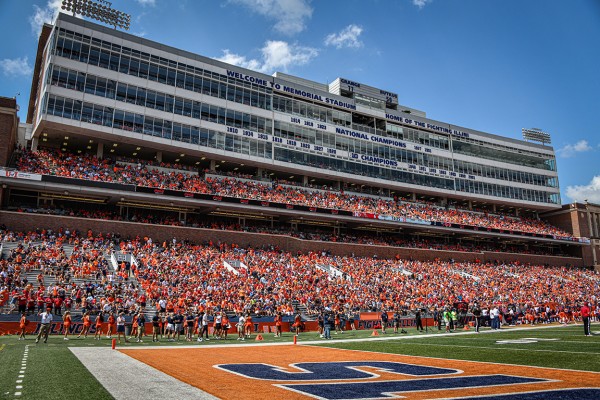
Turning Your Tailgate into an Orange & Blue Weekend
August 19, 2022
Tailgating is a way of life in Champaign-Urbana, with Fighting Illini Football weekends taking center stage from August–November. The party doesn’t have to stop with game day. Take your orange & blue pride and make a weekend visit on the University of Illinois campus and beyond.
Read MoreTurning Your Tailgate into an Orange & Blue Weekend
August 19, 2022
Tailgating is a way of life in Champaign-Urbana, with Fighting Illini Football weekends taking center stage from August–November. The party doesn’t have to stop with game day. Take your orange & blue pride and make a weekend visit on the University of Illinois campus and beyond.
Read More
Six End of Summer Stops to Make in Champaign County
August 7, 2022
Summer isn't over yet! Add these six stops to your seasonal plans before transitioning to Fall.
Read MoreSix End of Summer Stops to Make in Champaign County
August 7, 2022
Summer isn't over yet! Add these six stops to your seasonal plans before transitioning to Fall.
Read More
Spotlight: Delight Flower Farm
August 1, 2022
From tulips to Dahlias, Snap Dragons to fresh cut Eucalyptus in the fall, Delight Flower Farm is known in the community for their bountiful array of fresh cut flowers and bouquets of the highest quality. We sat down with Maggie Taylor, owner and founder, to discuss her journey of becoming a farmer and opening up Delight Flower Farm.
Read MoreSpotlight: Delight Flower Farm
August 1, 2022
From tulips to Dahlias, Snap Dragons to fresh cut Eucalyptus in the fall, Delight Flower Farm is known in the community for their bountiful array of fresh cut flowers and bouquets of the highest quality. We sat down with Maggie Taylor, owner and founder, to discuss her journey of becoming a farmer and opening up Delight Flower Farm.
Read More
Keep Summer Alive: A Before School Starts Bucket List for Kids
July 27, 2022
There’s plenty of time to keep summer alive before the kids go back to school, so we’ve compiled a before-school-starts bucket list for kids, including outdoor activities, amazing attractions, and some last-minute fun and games before the bell rings on the 2022-2023 school year.
Read MoreKeep Summer Alive: A Before School Starts Bucket List for Kids
July 27, 2022
There’s plenty of time to keep summer alive before the kids go back to school, so we’ve compiled a before-school-starts bucket list for kids, including outdoor activities, amazing attractions, and some last-minute fun and games before the bell rings on the 2022-2023 school year.
Read More
Top places to exercise outside in Champaign County
July 22, 2022
With an area so rich in nature, it's no surprise we're a popular destination for fitness enthusiasts! From biking, jogging, to yoga and pilates, you'll find a few places where you can go and get your sweat on.
Read MoreTop places to exercise outside in Champaign County
July 22, 2022
With an area so rich in nature, it's no surprise we're a popular destination for fitness enthusiasts! From biking, jogging, to yoga and pilates, you'll find a few places where you can go and get your sweat on.
Read More
There's a new Chinese Restaurant in Town: Lao Sze Chuan
July 15, 2022
When I found out that Lao Sze Chuan, an award-winning Chinese restaurant opened up a brick and mortar in Champaign a couple weeks ago, I had to see what the fuss was all about!
Read MoreThere's a new Chinese Restaurant in Town: Lao Sze Chuan
July 15, 2022
When I found out that Lao Sze Chuan, an award-winning Chinese restaurant opened up a brick and mortar in Champaign a couple weeks ago, I had to see what the fuss was all about!
Read More
Top Places to Experience Nightlife in Champaign
July 13, 2022
From live music, DJ sets and plunging garden lights: Here are the top spots to experience nightlife in Champaign-Urbana!
Read MoreTop Places to Experience Nightlife in Champaign
July 13, 2022
From live music, DJ sets and plunging garden lights: Here are the top spots to experience nightlife in Champaign-Urbana!
Read More
2022 Fourth of July Events in the Champaign County Area
June 30, 2022
If you're eager to make plans for the holiday weekend, then there's good news. Fourth of July events in the Champaign County Area start as early as this weekend! Here's your guide to the major celebrations, parades, and fireworks displays taking place this year.
Read More2022 Fourth of July Events in the Champaign County Area
June 30, 2022
If you're eager to make plans for the holiday weekend, then there's good news. Fourth of July events in the Champaign County Area start as early as this weekend! Here's your guide to the major celebrations, parades, and fireworks displays taking place this year.
Read More
Five Ways to Celebrate Dad this Father's Day Weekend
June 14, 2022
If you’re looking for some inspiration for Father's Day plans, there’s plenty to do in the greater Champaign County this weekend, some of which is specifically themed around that special guy in your life.
Read MoreFive Ways to Celebrate Dad this Father's Day Weekend
June 14, 2022
If you’re looking for some inspiration for Father's Day plans, there’s plenty to do in the greater Champaign County this weekend, some of which is specifically themed around that special guy in your life.
Read More
Six LGBTQIA+ Events to Participate in for Pride Month 2022
June 7, 2022
Drag shows, live music, dancing, face-painting, and so much more—we invite you to check out all of the queer-friendly events the greater Champaign county area has to offer this month.
Read MoreSix LGBTQIA+ Events to Participate in for Pride Month 2022
June 7, 2022
Drag shows, live music, dancing, face-painting, and so much more—we invite you to check out all of the queer-friendly events the greater Champaign county area has to offer this month.
Read More
Eight Fishing Spots to Try in Champaign County
May 30, 2022
There are many great spots to fish around the greater Champaign County area for newcomers and long-time aficionados.
Read MoreEight Fishing Spots to Try in Champaign County
May 30, 2022
There are many great spots to fish around the greater Champaign County area for newcomers and long-time aficionados.
Read More
5 Top BBQ Destinations for Memorial Day Weekend
May 24, 2022
We’ve included our top 5 BBQ destinations you must try for Memorial Day Weekend. It’s time to whip out your napkins and get those wet-naps ready!
Read More5 Top BBQ Destinations for Memorial Day Weekend
May 24, 2022
We’ve included our top 5 BBQ destinations you must try for Memorial Day Weekend. It’s time to whip out your napkins and get those wet-naps ready!
Read More
5 AAPI Restaurants to Support in May
May 20, 2022
Explore the various flavors and findings at these five AAPI-owned restaurants in May and all year long.
Read More5 AAPI Restaurants to Support in May
May 20, 2022
Explore the various flavors and findings at these five AAPI-owned restaurants in May and all year long.
Read More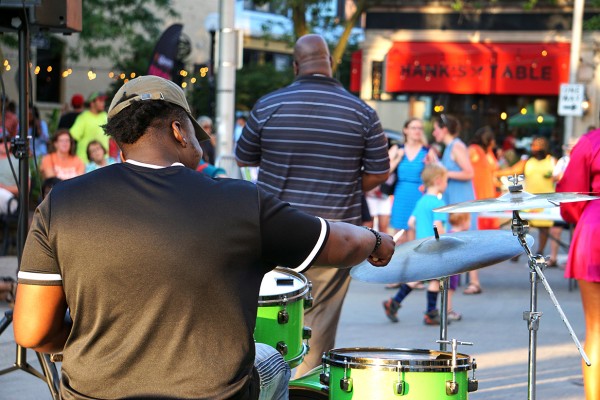
10 Experiences for your Summer Road Trip that Won’t Break the Bank
May 17, 2022
Keeping your summer road trips close to home this year? While we continue to fill our tank to get us around, missing out on summer experiences is still a must. Champaign County is bursting with budget-friendly activities so you don’t have to miss out on summer fun. Here are our top ten ideas for low or no-cost activities to enjoy this summer.
Read More10 Experiences for your Summer Road Trip that Won’t Break the Bank
May 17, 2022
Keeping your summer road trips close to home this year? While we continue to fill our tank to get us around, missing out on summer experiences is still a must. Champaign County is bursting with budget-friendly activities so you don’t have to miss out on summer fun. Here are our top ten ideas for low or no-cost activities to enjoy this summer.
Read More
Greener Goods: An Earth Day Experience
May 3, 2022
In lieu of Earth Day, I decided to visit Greener Goods—an eco-friendly pop-up shop in Mahomet, Illinois. I admit, I didn’t know much about “sustainability” other than opting out of the plastic bags when I shop at Aldi’s, or drinking out of straw-less cups provided by Starbucks. I assumed these little changes made a difference, but after chatting with Tara Allen, owner and founder of Greener Goods—boy was I wrong.
Read MoreGreener Goods: An Earth Day Experience
May 3, 2022
In lieu of Earth Day, I decided to visit Greener Goods—an eco-friendly pop-up shop in Mahomet, Illinois. I admit, I didn’t know much about “sustainability” other than opting out of the plastic bags when I shop at Aldi’s, or drinking out of straw-less cups provided by Starbucks. I assumed these little changes made a difference, but after chatting with Tara Allen, owner and founder of Greener Goods—boy was I wrong.
Read More
5 Unique Sports to Try in Champaign County
April 14, 2022
Five unique sports you can play in Champaign County are beginner-friendly. Additionally, they provide a great change of pace for your usual spring and summer activities.
Read More5 Unique Sports to Try in Champaign County
April 14, 2022
Five unique sports you can play in Champaign County are beginner-friendly. Additionally, they provide a great change of pace for your usual spring and summer activities.
Read More
Where To Hunt Easter Eggs in Champaign County
April 13, 2022
We're hopping into Easter weekend and getting our baskets ready for community Easter Egg Hunts. Young or old, there's a hunt on the horizon for you to enjoy this weekend. Check out our list and make your plans!
Read MoreWhere To Hunt Easter Eggs in Champaign County
April 13, 2022
We're hopping into Easter weekend and getting our baskets ready for community Easter Egg Hunts. Young or old, there's a hunt on the horizon for you to enjoy this weekend. Check out our list and make your plans!
Read More
2022 Boneyard Arts Festival Preview
March 30, 2022
Celebrating 20 years, the Boneyard Arts Festival returns this weekend to Champaign County. Happening April 1–3 in over 70 venues representing over 100 artists, this annual event is like no other arts festival around, and that’s a really good thing.
Read More2022 Boneyard Arts Festival Preview
March 30, 2022
Celebrating 20 years, the Boneyard Arts Festival returns this weekend to Champaign County. Happening April 1–3 in over 70 venues representing over 100 artists, this annual event is like no other arts festival around, and that’s a really good thing.
Read More
5 Ways that Shopping Local Helps Your Community
March 28, 2022
Everyone knows that supporting local businesses is important, but it's worth a reminder just how much of a difference it can make.
Read More5 Ways that Shopping Local Helps Your Community
March 28, 2022
Everyone knows that supporting local businesses is important, but it's worth a reminder just how much of a difference it can make.
Read More
Extraordinary Things You'll Only Find in Champaign County
March 21, 2022
When you're considering where to go in the near future, make sure to add these five views you can only see in Champaign County to your list!
Read MoreExtraordinary Things You'll Only Find in Champaign County
March 21, 2022
When you're considering where to go in the near future, make sure to add these five views you can only see in Champaign County to your list!
Read More
Top Events & Activities for Warmer Weather in the Greater Champaign County Area
March 9, 2022
Don’t just cross off days on your calendar. Enjoy every day by getting out in the greater Champaign County area. Spring and summer bring daily events and major festivals for every interest and every age. What are you waiting for? Make your plans today!
Read MoreTop Events & Activities for Warmer Weather in the Greater Champaign County Area
March 9, 2022
Don’t just cross off days on your calendar. Enjoy every day by getting out in the greater Champaign County area. Spring and summer bring daily events and major festivals for every interest and every age. What are you waiting for? Make your plans today!
Read More
Celebrate Local Foods
February 14, 2022
Farms large and small surround our micro-urban community, providing fresh ingredients for local chefs to incorporate into their menus, and for us to prepare at home. Here’s where you can pick up the freshest ingredients of the season to support our local food system.
Read MoreCelebrate Local Foods
February 14, 2022
Farms large and small surround our micro-urban community, providing fresh ingredients for local chefs to incorporate into their menus, and for us to prepare at home. Here’s where you can pick up the freshest ingredients of the season to support our local food system.
Read More
Valentine's Day Date Ideas Around Champaign County
February 10, 2022
Looking to put something together for a memorable Valentine's Day date? Here are some ideas!
Read MoreValentine's Day Date Ideas Around Champaign County
February 10, 2022
Looking to put something together for a memorable Valentine's Day date? Here are some ideas!
Read More
Take Advantage of These Fun Activities in the Snow
February 8, 2022
With tons of snow on the ground and plenty to do, here's how you can have some fun before winter is on its way for the season.
Read MoreTake Advantage of These Fun Activities in the Snow
February 8, 2022
With tons of snow on the ground and plenty to do, here's how you can have some fun before winter is on its way for the season.
Read More
What is Plan for Vacation Day?
January 25, 2022
Need a recharge, refresh, or just a little getaway? As we #PlanForVacation this week, explore why a trip away can be incredibly beneficial to your mental health!
Read MoreWhat is Plan for Vacation Day?
January 25, 2022
Need a recharge, refresh, or just a little getaway? As we #PlanForVacation this week, explore why a trip away can be incredibly beneficial to your mental health!
Read More
5 Unique Reasons Champaign County is a Top Tourist Destination
January 24, 2022
Here are just five reasons that Champaign County is a great place to #PlanForVacation.
Read More5 Unique Reasons Champaign County is a Top Tourist Destination
January 24, 2022
Here are just five reasons that Champaign County is a great place to #PlanForVacation.
Read More
Terri’s Restaurant Week Preview
January 21, 2022
Terri Reifsteck, Vice President of Marketing & Community Engagement, shares a few of her favorite options for Restaurant Week 2022!
Read MoreTerri’s Restaurant Week Preview
January 21, 2022
Terri Reifsteck, Vice President of Marketing & Community Engagement, shares a few of her favorite options for Restaurant Week 2022!
Read More
Hiking Trails to Explore in the Champaign County Area
January 6, 2022
The greater Champaign County area is full of incredible options for walking and running amongst incredible nature scapes.
Read MoreHiking Trails to Explore in the Champaign County Area
January 6, 2022
The greater Champaign County area is full of incredible options for walking and running amongst incredible nature scapes.
Read More
2021 Champaign County Christmas Restaurant Openings and Catering Options
December 17, 2021
If you're looking for where to eat on Christmas in Champaign County, then you're in the right place! Plus, check out catering options for your at-home holiday celebrations.
Read More2021 Champaign County Christmas Restaurant Openings and Catering Options
December 17, 2021
If you're looking for where to eat on Christmas in Champaign County, then you're in the right place! Plus, check out catering options for your at-home holiday celebrations.
Read More
Shop Local 2021: Books and Games to Keep You Entertained All Winter Long
December 16, 2021
Whether it's winter break from school or a little extra time off from work, the holidays are a great time to kick back with a good read or a fun game.
Read MoreShop Local 2021: Books and Games to Keep You Entertained All Winter Long
December 16, 2021
Whether it's winter break from school or a little extra time off from work, the holidays are a great time to kick back with a good read or a fun game.
Read More
Shop Local 2021: Favorite Stops for Clothes and Accessories
December 2, 2021
There are so many great options for shopping clothes and accessories in the greater Champaign County area. We have boutiques and name-brand stores, local outlets and so much more!
Read MoreShop Local 2021: Favorite Stops for Clothes and Accessories
December 2, 2021
There are so many great options for shopping clothes and accessories in the greater Champaign County area. We have boutiques and name-brand stores, local outlets and so much more!
Read More
2021 Champaign County Shop Local Guide
November 17, 2021
Throw on your favorite sweater, some comfy shoes, and get ready to shop your way across Champaign County!
Read More2021 Champaign County Shop Local Guide
November 17, 2021
Throw on your favorite sweater, some comfy shoes, and get ready to shop your way across Champaign County!
Read More
2021 Thanksgiving Day Restaurant Openings and Catering Options in Champaign County
November 15, 2021
Skip the kitchen stress and opt for a meal at a local restaurant this year! Here' who will be open on Thanksgiving Day!
Read More2021 Thanksgiving Day Restaurant Openings and Catering Options in Champaign County
November 15, 2021
Skip the kitchen stress and opt for a meal at a local restaurant this year! Here' who will be open on Thanksgiving Day!
Read More
5 UIUC Sustainability Efforts You Should Know About
November 2, 2021
UIUC looks to become a model for other campuses when it comes to sustainability implementation.
Read More5 UIUC Sustainability Efforts You Should Know About
November 2, 2021
UIUC looks to become a model for other campuses when it comes to sustainability implementation.
Read More
Our Community Highlights: The Champaign Public Library
October 27, 2021
Terri shares her love of the Champaign Public Library for our "Your Places. Your Spaces. Your Community" campaign.
Read MoreOur Community Highlights: The Champaign Public Library
October 27, 2021
Terri shares her love of the Champaign Public Library for our "Your Places. Your Spaces. Your Community" campaign.
Read More
Mama Meta's Canteen to Serve Up African Cuisine to C-U
October 15, 2021
Mama Meta's Canteen plans to provide African food with some American twists for pick up, catering options for events, and pop up locations.
Read MoreMama Meta's Canteen to Serve Up African Cuisine to C-U
October 15, 2021
Mama Meta's Canteen plans to provide African food with some American twists for pick up, catering options for events, and pop up locations.
Read More
Soup Season in Champaign County
October 8, 2021
We can talk about sweater weather, sure. But we'd rather talk about soup season. As the chill in the air returns to the greater Champaign County area, soup hits the spot unlike any other dish.
Read MoreSoup Season in Champaign County
October 8, 2021
We can talk about sweater weather, sure. But we'd rather talk about soup season. As the chill in the air returns to the greater Champaign County area, soup hits the spot unlike any other dish.
Read More
U of I Library Home to Nation's 2nd Largest Children's Book Collection
October 5, 2021
This recent headline caught our eye: the U of I's Social Sciences, Health, and Education Library is home to the 2nd largest Children's Book Collection in the country!
Read MoreU of I Library Home to Nation's 2nd Largest Children's Book Collection
October 5, 2021
This recent headline caught our eye: the U of I's Social Sciences, Health, and Education Library is home to the 2nd largest Children's Book Collection in the country!
Read More
Five Must-See Events at Pygmalion 2021
September 21, 2021
To help highlight a few you won't want to miss at Pygmalion 2021, here are five events you'll certainly want to make time for this weekend.
Read MoreFive Must-See Events at Pygmalion 2021
September 21, 2021
To help highlight a few you won't want to miss at Pygmalion 2021, here are five events you'll certainly want to make time for this weekend.
Read More
Inside Allerton's Gardens: 5 Facts You Might Not Know
September 17, 2021
When you're looking for adventure in your backyard, consider visiting these historic gardens at Allerton Park and Retreat Center.
Read MoreInside Allerton's Gardens: 5 Facts You Might Not Know
September 17, 2021
When you're looking for adventure in your backyard, consider visiting these historic gardens at Allerton Park and Retreat Center.
Read More
Inside the 3rd Annual C-U Black and African Arts Festival
September 15, 2021
Co-Founders Susan Ogwal and Cindy Owusu to talk about returning favorites and new features of the 3rd annual C-U Black and African Arts Festival.
Read MoreInside the 3rd Annual C-U Black and African Arts Festival
September 15, 2021
Co-Founders Susan Ogwal and Cindy Owusu to talk about returning favorites and new features of the 3rd annual C-U Black and African Arts Festival.
Read More
U of I School Year Guide: Food Bucket List in Champaign-Urbana
August 31, 2021
In our last blog for new U of I students, we're laying out a Food Bucket List to help get newcomers to our community introduced
Read MoreU of I School Year Guide: Food Bucket List in Champaign-Urbana
August 31, 2021
In our last blog for new U of I students, we're laying out a Food Bucket List to help get newcomers to our community introduced
Read More
A Guide to Half Century of Progress 2021
August 26, 2021
Half Century of Progress is one of the largest farm shows in the country. This year, it returns to Rantoul and is certain to be something curious onlookers will want to check out!G
Read MoreA Guide to Half Century of Progress 2021
August 26, 2021
Half Century of Progress is one of the largest farm shows in the country. This year, it returns to Rantoul and is certain to be something curious onlookers will want to check out!G
Read More
Illini School Year Guide: 7 Tips for New U of I Students
August 24, 2021
No matter where you go after college, our #OutsideofOrdinary community will always be yours. Here are our tips for new U of I students in the first entry of our Illini School Year Guide!
Read MoreIllini School Year Guide: 7 Tips for New U of I Students
August 24, 2021
No matter where you go after college, our #OutsideofOrdinary community will always be yours. Here are our tips for new U of I students in the first entry of our Illini School Year Guide!
Read More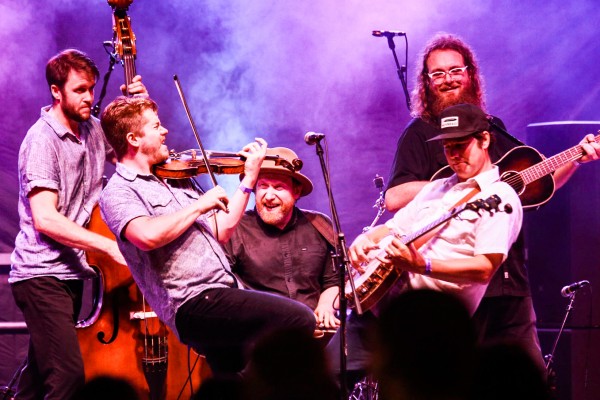
Fall Festivals Make a Return
August 17, 2021
After a year off, our fall festivals are making a safe return to our community, providing everything from film-going experiences to live music to cultural celebrations. Check out what’s returning and make your plans for your weekend visit around these must-attend events!
Read MoreFall Festivals Make a Return
August 17, 2021
After a year off, our fall festivals are making a safe return to our community, providing everything from film-going experiences to live music to cultural celebrations. Check out what’s returning and make your plans for your weekend visit around these must-attend events!
Read More
Main Street Cookies & Cream in Fisher Thrives on Sweet and Local Treats
August 12, 2021
Something sweet opened a couple of weeks ago in the heart of downtown Fisher.
Read MoreMain Street Cookies & Cream in Fisher Thrives on Sweet and Local Treats
August 12, 2021
Something sweet opened a couple of weeks ago in the heart of downtown Fisher.
Read More
Interview: Rad Lad Games Opening Soon in Mahomet
July 27, 2021
Rad Lad Games is planning to open on Mahomet's Main Street in August and you can learn more about the store in this Q+A with the owner!
Read MoreInterview: Rad Lad Games Opening Soon in Mahomet
July 27, 2021
Rad Lad Games is planning to open on Mahomet's Main Street in August and you can learn more about the store in this Q+A with the owner!
Read More
2021 Champaign County Fair Guide
July 15, 2021
Curious about how to tackle the Champaign County Fair’s robust schedule of events and activities? We’ve got you covered with our 2021 Champaign County Fair Guide.
Read More2021 Champaign County Fair Guide
July 15, 2021
Curious about how to tackle the Champaign County Fair’s robust schedule of events and activities? We’ve got you covered with our 2021 Champaign County Fair Guide.
Read More
Disability Pride Month: How Champaign-Urbana Helped Shape Accessibility
July 8, 2021
As the birthplace of the disability rights movement, we're proud to say that thanks to leaders in our community, Disability Pride is a year-round feature of Champaign-Urbana.
Read MoreDisability Pride Month: How Champaign-Urbana Helped Shape Accessibility
July 8, 2021
As the birthplace of the disability rights movement, we're proud to say that thanks to leaders in our community, Disability Pride is a year-round feature of Champaign-Urbana.
Read More
A Guide to Historic Farm Days
July 6, 2021
At the I&I Antique Tractor & Gas Engine Club Showgrounds, attendees will see a ton of amazing things, so be sure not to miss these 8 highlights over the four-day Historic Farm Days in Penfield.
Read MoreA Guide to Historic Farm Days
July 6, 2021
At the I&I Antique Tractor & Gas Engine Club Showgrounds, attendees will see a ton of amazing things, so be sure not to miss these 8 highlights over the four-day Historic Farm Days in Penfield.
Read More
Summer Food and Drink Stops to Explore Outside Champaign-Urbana
June 29, 2021
Champaign-Urbana might be the Best Midwest Food Town according to Midwest Living, but good eats and drinks don't stop when you leave C-U.
Read MoreSummer Food and Drink Stops to Explore Outside Champaign-Urbana
June 29, 2021
Champaign-Urbana might be the Best Midwest Food Town according to Midwest Living, but good eats and drinks don't stop when you leave C-U.
Read More
Making the Most of a Student-Free Campustown
June 25, 2021
Here are just a few ideas to make some time in Campustown a fun little adventure in your own backyard before students return!
Read MoreMaking the Most of a Student-Free Campustown
June 25, 2021
Here are just a few ideas to make some time in Campustown a fun little adventure in your own backyard before students return!
Read More
Art is Alive Again
June 17, 2021
After a long, challenging year, we’re excited to once again celebrate our local arts scene during the Boneyard Arts Festival, hosted by 40 North, the Champaign County Arts Council. This annual event, typically held over the University of Illinois Mom’s Weekend in April, was rescheduled for June to allow time for safety efforts and vaccinations to be widespread. We couldn’t be happier that this popular arts & culture festival is kicking off a return of events and festivals to the greater Champaign County area at a time when our local artists and venues need it most.
Read MoreArt is Alive Again
June 17, 2021
After a long, challenging year, we’re excited to once again celebrate our local arts scene during the Boneyard Arts Festival, hosted by 40 North, the Champaign County Arts Council. This annual event, typically held over the University of Illinois Mom’s Weekend in April, was rescheduled for June to allow time for safety efforts and vaccinations to be widespread. We couldn’t be happier that this popular arts & culture festival is kicking off a return of events and festivals to the greater Champaign County area at a time when our local artists and venues need it most.
Read More
Exploring Arthur: Favorite Things to Do and See
June 15, 2021
Christy Miller, director of Simply Arthur, spoke with us to hopefully change that for those who haven't been to Arthur, or to entice you back if you've visited before.
Read MoreExploring Arthur: Favorite Things to Do and See
June 15, 2021
Christy Miller, director of Simply Arthur, spoke with us to hopefully change that for those who haven't been to Arthur, or to entice you back if you've visited before.
Read More
Unique Finds at Jane Addams Book Shop: Summer Edition
June 11, 2021
Jane Addams shares some great options for summer reads signed by the author!
Read MoreUnique Finds at Jane Addams Book Shop: Summer Edition
June 11, 2021
Jane Addams shares some great options for summer reads signed by the author!
Read More
Aikman Wildlife Adventure's New Summer Hours are Here!
June 2, 2021
Aikman Wildlife Adventure is operating with new summer hours. If you haven't been in awhile (or ever) it's time to make the trip to Arcola!
Read MoreAikman Wildlife Adventure's New Summer Hours are Here!
June 2, 2021
Aikman Wildlife Adventure is operating with new summer hours. If you haven't been in awhile (or ever) it's time to make the trip to Arcola!
Read More
AAPI Anti-Bias Resources in Champaign County
May 27, 2021
We want to highlight a few resources available to visitors and residents alike as we wrap up AAPI Heritage Month and continue improving our community for all.
Read MoreAAPI Anti-Bias Resources in Champaign County
May 27, 2021
We want to highlight a few resources available to visitors and residents alike as we wrap up AAPI Heritage Month and continue improving our community for all.
Read More
AAPI Heritage Month Artist Talk: EKAH
May 25, 2021
In our continued celebration of AAPI Heritage Month, we sit down with EKAH, a local artist whose work inspires and connects with audiences far and wide.
Read MoreAAPI Heritage Month Artist Talk: EKAH
May 25, 2021
In our continued celebration of AAPI Heritage Month, we sit down with EKAH, a local artist whose work inspires and connects with audiences far and wide.
Read More
Engaging with AAPI Culture in Champaign County
May 19, 2021
Getting started with these ways to engage with AAPI culture can help to expand our knowledge of the traditions and values our neighbors and friends share here in Champaign County and beyond.
Read MoreEngaging with AAPI Culture in Champaign County
May 19, 2021
Getting started with these ways to engage with AAPI culture can help to expand our knowledge of the traditions and values our neighbors and friends share here in Champaign County and beyond.
Read More
Unique Innovations from Champaign-Urbana
May 18, 2021
In Champaign County, innovation is around every corner. Here are a few of the area's most notable contributions!
Read MoreUnique Innovations from Champaign-Urbana
May 18, 2021
In Champaign County, innovation is around every corner. Here are a few of the area's most notable contributions!
Read More
Five AAPI-Owned Restaurants to Visit in May
May 14, 2021
These locally-owned restaurants are the perfect place to visit during Asian American Pacific Islander Heritage Month!
Read MoreFive AAPI-Owned Restaurants to Visit in May
May 14, 2021
These locally-owned restaurants are the perfect place to visit during Asian American Pacific Islander Heritage Month!
Read More
Three Ways Tourism Will Help Communities Recover from the Pandemic
May 7, 2021
Tourism will help the greater Champaign County area and other communities like it to restore jobs and a sustained economic impact on local businesses.
Read MoreThree Ways Tourism Will Help Communities Recover from the Pandemic
May 7, 2021
Tourism will help the greater Champaign County area and other communities like it to restore jobs and a sustained economic impact on local businesses.
Read More
The Power of Travel: The Road to Recovery
May 6, 2021
As we celebrate National Travel & Tourism Week, we reflect on the losses over the past year and look towards the role travel will play in our economic recovery.
Read MoreThe Power of Travel: The Road to Recovery
May 6, 2021
As we celebrate National Travel & Tourism Week, we reflect on the losses over the past year and look towards the role travel will play in our economic recovery.
Read More
Recent Wins for Our Community: National Travel and Tourism Week
May 4, 2021
While 2020 may be remembered as a year we'd rather forget, a few wins in our community will continue to shape those who visit, work, and live in Champaign County for years to come.
Read MoreRecent Wins for Our Community: National Travel and Tourism Week
May 4, 2021
While 2020 may be remembered as a year we'd rather forget, a few wins in our community will continue to shape those who visit, work, and live in Champaign County for years to come.
Read More
It's Back! Urbana's Market at the Square Returns May 1st
April 21, 2021
Urbana's Market at the Square returns May 1st and we couldn't be more excited.
Read MoreIt's Back! Urbana's Market at the Square Returns May 1st
April 21, 2021
Urbana's Market at the Square returns May 1st and we couldn't be more excited.
Read More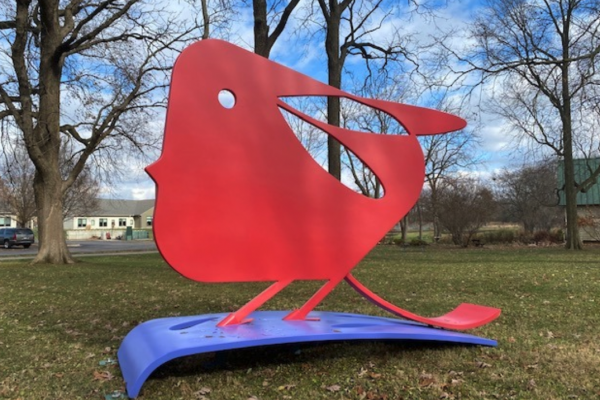
Five Unique Inspirations for Public Art in our Area
April 20, 2021
We have an incredible array of public art to explore from murals to sculptures and so much more. Here are five that have a particularly interesting story behind their creation!
Read MoreFive Unique Inspirations for Public Art in our Area
April 20, 2021
We have an incredible array of public art to explore from murals to sculptures and so much more. Here are five that have a particularly interesting story behind their creation!
Read More
Four Spring Cocktails to Try Around Champaign-Urbana
April 14, 2021
With the beautiful weather we've been having, we have patio season and spring cocktails on the brain
Read MoreFour Spring Cocktails to Try Around Champaign-Urbana
April 14, 2021
With the beautiful weather we've been having, we have patio season and spring cocktails on the brain
Read More
Spring Shopping Checklist - Fresh Additions to the Home, Wardrobe, and More!
April 12, 2021
Read through our guide to freshening up your home and wardrobe for the new season!
Read MoreSpring Shopping Checklist - Fresh Additions to the Home, Wardrobe, and More!
April 12, 2021
Read through our guide to freshening up your home and wardrobe for the new season!
Read More
5 Unique Sports You Can Try in Champaign County
April 9, 2021
Itching to try a new sport? We have five you should try this spring and summer!
Read More5 Unique Sports You Can Try in Champaign County
April 9, 2021
Itching to try a new sport? We have five you should try this spring and summer!
Read More
Eight Fishing Spots You Need to Try in Champaign County
March 30, 2021
If you're thinking of casting a reel this spring, then be sure to try one of these community favorites for fishing in Champaign County!
Read MoreEight Fishing Spots You Need to Try in Champaign County
March 30, 2021
If you're thinking of casting a reel this spring, then be sure to try one of these community favorites for fishing in Champaign County!
Read More
Rantoul Sports Complex: A Game-Changer for Sports Tourism
March 23, 2021
The new Rantoul Sports Complex, poised to open for tournament play in April, is already proving to be quite impactful for all involved.
Read MoreRantoul Sports Complex: A Game-Changer for Sports Tourism
March 23, 2021
The new Rantoul Sports Complex, poised to open for tournament play in April, is already proving to be quite impactful for all involved.
Read More
Six Easter Egg Hunts and Bunny Visit Events in Champaign County
March 23, 2021
Here's a breakdown of six Easter events worth checking out in the greater Champaign County area!
Read MoreSix Easter Egg Hunts and Bunny Visit Events in Champaign County
March 23, 2021
Here's a breakdown of six Easter events worth checking out in the greater Champaign County area!
Read More
Get to Know the Japan House Gardens
March 17, 2021
It doesn't take an expert to acknowledge the serenity the Japan House Gardens offer, but learning a bit about their history makes a visit to these spaces all the more special.
Read MoreGet to Know the Japan House Gardens
March 17, 2021
It doesn't take an expert to acknowledge the serenity the Japan House Gardens offer, but learning a bit about their history makes a visit to these spaces all the more special.
Read More
A History of the IHSA State Basketball Tournament in Champaign-Urbana
March 12, 2021
Legends Play Here in Champaign County, and we can't wait to welcome you next year for the IHSA Boys State Basketball Tournament in 2022.
Read MoreA History of the IHSA State Basketball Tournament in Champaign-Urbana
March 12, 2021
Legends Play Here in Champaign County, and we can't wait to welcome you next year for the IHSA Boys State Basketball Tournament in 2022.
Read More
Get to Know the Kickapoo Rail Trail
March 10, 2021
Before heading out to explore the Kickapoo Rail Trail this spring, get to know a few of the unique aspects that make this feature Outside of Ordinary.
Read MoreGet to Know the Kickapoo Rail Trail
March 10, 2021
Before heading out to explore the Kickapoo Rail Trail this spring, get to know a few of the unique aspects that make this feature Outside of Ordinary.
Read More
Unique Finds at Jane Addams Book Shop: Spring Edition
March 8, 2021
As you hunt for a spring read, these books are just a few of the eye-catching titles you'll find during a visit to Jane Addams Book Shop in Downtown Champaign.
Read MoreUnique Finds at Jane Addams Book Shop: Spring Edition
March 8, 2021
As you hunt for a spring read, these books are just a few of the eye-catching titles you'll find during a visit to Jane Addams Book Shop in Downtown Champaign.
Read More
Celebrating Agriculture Innovation
March 5, 2021
It’s no secret that Champaign County is home to and is surrounded by acres and acres of farmland with some of the richest soil in the world. This coming week, we're celebrating agriculture innovation through the AgTech Innovation Summit and through our local agricultural leaders.
Read MoreCelebrating Agriculture Innovation
March 5, 2021
It’s no secret that Champaign County is home to and is surrounded by acres and acres of farmland with some of the richest soil in the world. This coming week, we're celebrating agriculture innovation through the AgTech Innovation Summit and through our local agricultural leaders.
Read More
Local Plant Shops to Help Wave Goodbye to Winter
March 3, 2021
Whether you're someone who likes to garden outside or you're just eager to bid winter adieu, we have a few local plant shops in town that can help you.
Read MoreLocal Plant Shops to Help Wave Goodbye to Winter
March 3, 2021
Whether you're someone who likes to garden outside or you're just eager to bid winter adieu, we have a few local plant shops in town that can help you.
Read More
The Sounds of C-U
February 28, 2021
The saying “the music never stopped” reigns true when it comes to the sounds of the greater Champaign County area. Consider this our entertainment bucket list, compiled with the music lover in mind.
Read MoreThe Sounds of C-U
February 28, 2021
The saying “the music never stopped” reigns true when it comes to the sounds of the greater Champaign County area. Consider this our entertainment bucket list, compiled with the music lover in mind.
Read More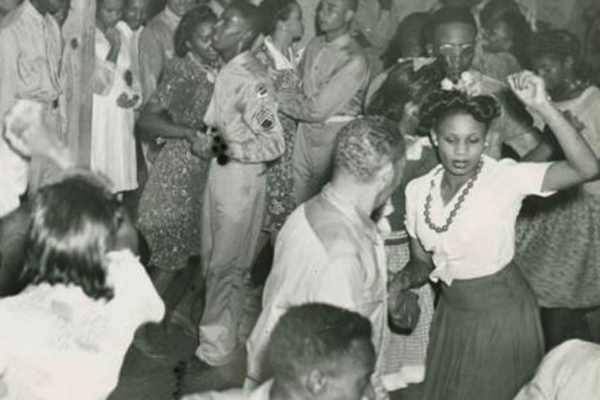
Museum Exhibits to Explore During Black History Month
February 22, 2021
Check out these exhibits on Black culture, racial and social justice, and history that are poignant for Black History Month.
Read MoreMuseum Exhibits to Explore During Black History Month
February 22, 2021
Check out these exhibits on Black culture, racial and social justice, and history that are poignant for Black History Month.
Read More
Must-Visit Gardens for Capturing Spring's Beauty
February 18, 2021
We social distanced during fall and winter of 2020 so we can catch the blooms rise this spring. These spaces showcase annuals and perennials that are sure to inspire. Snap a pic for your Instagram and share with #outsideofordinary!
Read MoreMust-Visit Gardens for Capturing Spring's Beauty
February 18, 2021
We social distanced during fall and winter of 2020 so we can catch the blooms rise this spring. These spaces showcase annuals and perennials that are sure to inspire. Snap a pic for your Instagram and share with #outsideofordinary!
Read More
On the Patio
February 17, 2021
There’s something special about dining al fresco with the fresh air and the sunset providing the ambience. Our downtown districts offer hundreds of outdoor seats to enjoy with social distancing, but these iconic patios provide the perfect backdrop for dinner or a drink.
Read MoreOn the Patio
February 17, 2021
There’s something special about dining al fresco with the fresh air and the sunset providing the ambience. Our downtown districts offer hundreds of outdoor seats to enjoy with social distancing, but these iconic patios provide the perfect backdrop for dinner or a drink.
Read More
Show Local Businesses Some Love This Valentine's Day
February 10, 2021
On top of the headaches that COVID-19 brought our way almost a year ago, thinking local could go a long way this Valentine's Day!
Read MoreShow Local Businesses Some Love This Valentine's Day
February 10, 2021
On top of the headaches that COVID-19 brought our way almost a year ago, thinking local could go a long way this Valentine's Day!
Read More
Champaign County Valentine's Day Ideas
February 4, 2021
From lowkey lovebirds to fun-loving family plans, we have your Valentine's Day ideas covered!
Read MoreChampaign County Valentine's Day Ideas
February 4, 2021
From lowkey lovebirds to fun-loving family plans, we have your Valentine's Day ideas covered!
Read More
A New Hobby Webinar Series Celebrates Down-Time
January 27, 2021
The Urbana Park District kicks off a new webinar series in February celebrating hobbies. With increased down-time during COVID-19, the series will focus on what keeps us busy and interested during the quiet hours.
Read MoreA New Hobby Webinar Series Celebrates Down-Time
January 27, 2021
The Urbana Park District kicks off a new webinar series in February celebrating hobbies. With increased down-time during COVID-19, the series will focus on what keeps us busy and interested during the quiet hours.
Read More
Best Finds at the Champaign-Urbana Winter Farmers Market
January 20, 2021
Curious about the Indoor Winter Farmers Market? Here's why it's worth the trip to Lincoln Square Mall.
Read MoreBest Finds at the Champaign-Urbana Winter Farmers Market
January 20, 2021
Curious about the Indoor Winter Farmers Market? Here's why it's worth the trip to Lincoln Square Mall.
Read More
How Does Tier One Impact Champaign County Restaurants?
January 19, 2021
Indoor dining can resume, but what other changes come with Tier One mitigations?
Read MoreHow Does Tier One Impact Champaign County Restaurants?
January 19, 2021
Indoor dining can resume, but what other changes come with Tier One mitigations?
Read More
Illini Gameday Must-Haves for Watching From Home
January 7, 2021
We can't bring 15,000+ people to your house for the game, but we can utilize some local businesses to recreate some of our favorite elements of watching sports and cheering on our favorite team.
Read MoreIllini Gameday Must-Haves for Watching From Home
January 7, 2021
We can't bring 15,000+ people to your house for the game, but we can utilize some local businesses to recreate some of our favorite elements of watching sports and cheering on our favorite team.
Read More
Embracing Winter: Shop Local and Stock Up on Cold-Weather Gear
January 5, 2021
Find the best local places to grab winter gear. Staying inside all season long is so last year.
Read MoreEmbracing Winter: Shop Local and Stock Up on Cold-Weather Gear
January 5, 2021
Find the best local places to grab winter gear. Staying inside all season long is so last year.
Read More
Local Gift Ideas for Music Lovers
December 17, 2020
Shopping for a music lover? Whether they play music or listen to it, there's a local option waiting to help you find the perfect gift!
Read MoreLocal Gift Ideas for Music Lovers
December 17, 2020
Shopping for a music lover? Whether they play music or listen to it, there's a local option waiting to help you find the perfect gift!
Read More
Give the Gift of a Cozy Home (And Shop Local While Doing It!)
December 15, 2020
Shopping local is easy if you have names on your holiday list that enjoy cozy home decor. From candles to accent furniture and more, the greater Champaign County area has you covered!
Read MoreGive the Gift of a Cozy Home (And Shop Local While Doing It!)
December 15, 2020
Shopping local is easy if you have names on your holiday list that enjoy cozy home decor. From candles to accent furniture and more, the greater Champaign County area has you covered!
Read More
Gifting Local Art in Champaign County
December 10, 2020
These are just some of the many amazing local art options we have for gifting in Champaign County!
Read MoreGifting Local Art in Champaign County
December 10, 2020
These are just some of the many amazing local art options we have for gifting in Champaign County!
Read More
Christmas and Christmas Eve Catering Options in Champaign County
December 10, 2020
Check out options for Christmas Eve and Christmas catering options in Champaign County!
Read MoreChristmas and Christmas Eve Catering Options in Champaign County
December 10, 2020
Check out options for Christmas Eve and Christmas catering options in Champaign County!
Read More
Gifting Award-Winning Flavor in Champaign County
December 8, 2020
If you're trying to figure out what to give someone this holiday season, then consider gifting award-winning flavors, foods, and more from the greater Champaign County area.
Read MoreGifting Award-Winning Flavor in Champaign County
December 8, 2020
If you're trying to figure out what to give someone this holiday season, then consider gifting award-winning flavors, foods, and more from the greater Champaign County area.
Read More
Gifting Community Pride This Holiday Season with Chambana Proud
December 7, 2020
As you're finishing up holiday shopping, one option to consider is gifting community pride and a piece of what makes your home in Champaign County special.
Read MoreGifting Community Pride This Holiday Season with Chambana Proud
December 7, 2020
As you're finishing up holiday shopping, one option to consider is gifting community pride and a piece of what makes your home in Champaign County special.
Read More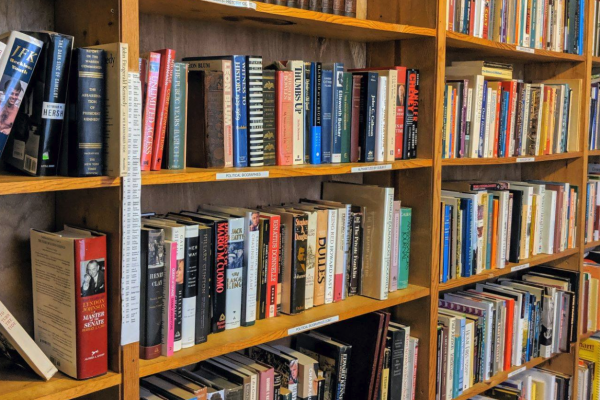
Shop Local in Champaign County: Buying for a Bookworm
December 1, 2020
With a great collection of local bookstores in the greater Champaign County area, you're in luck if you're buying books this holiday season.
Read MoreShop Local in Champaign County: Buying for a Bookworm
December 1, 2020
With a great collection of local bookstores in the greater Champaign County area, you're in luck if you're buying books this holiday season.
Read More
Creative Ways to Show Someone You're Thankful For Them
November 25, 2020
Read about tips to show someone you're thankful for them by shopping local!
Read MoreCreative Ways to Show Someone You're Thankful For Them
November 25, 2020
Read about tips to show someone you're thankful for them by shopping local!
Read More
2020 Shop Local Guide
November 20, 2020
This year, it's more important than ever to support local retailers and businesses. Our 2020 Shop Local Guide makes it easy and exciting
Read More2020 Shop Local Guide
November 20, 2020
This year, it's more important than ever to support local retailers and businesses. Our 2020 Shop Local Guide makes it easy and exciting
Read More
What Changes in Champaign County Under Tier 3 Mitigations?
November 18, 2020
Curious about what's changing under the state of Illinois' Tier 3 Mitigations? We're here to help!
Read MoreWhat Changes in Champaign County Under Tier 3 Mitigations?
November 18, 2020
Curious about what's changing under the state of Illinois' Tier 3 Mitigations? We're here to help!
Read More
Using Whip Cream in a Can This Thanksgiving? Thank Champaign-Urbana
November 17, 2020
Everyone does Thanksgiving a little differently. If you're using whipped cream in a can this year, you can thank a Champaign-Urbana inventor for that delicious topping to your pie.
Read MoreUsing Whip Cream in a Can This Thanksgiving? Thank Champaign-Urbana
November 17, 2020
Everyone does Thanksgiving a little differently. If you're using whipped cream in a can this year, you can thank a Champaign-Urbana inventor for that delicious topping to your pie.
Read More
Celebrating National Take a Hike Day in Champaign County
November 17, 2020
It's National Take a Hike Day! Here's how to celebrate in Champaign County
Read MoreCelebrating National Take a Hike Day in Champaign County
November 17, 2020
It's National Take a Hike Day! Here's how to celebrate in Champaign County
Read More
Order Thanksgiving Dinner in Champaign County
November 3, 2020
2020 has thrown just about everything at us. Take Thanksgiving cooking off your to-do list this year and support local restaurants.
Read MoreOrder Thanksgiving Dinner in Champaign County
November 3, 2020
2020 has thrown just about everything at us. Take Thanksgiving cooking off your to-do list this year and support local restaurants.
Read More
No Tricks, All Treats: Flesor's Candy Kitchen Favorites
October 26, 2020
With Halloween coming up later this week, a lot of us have candy on the mind. At Flesor's Candy Kitchen in Tuscola, candy is an everyday obsession.
Read MoreNo Tricks, All Treats: Flesor's Candy Kitchen Favorites
October 26, 2020
With Halloween coming up later this week, a lot of us have candy on the mind. At Flesor's Candy Kitchen in Tuscola, candy is an everyday obsession.
Read More
Five Cocktails That Have Us Ready for the Weekend
September 25, 2020
With amazing bars and restaurants come incredible cocktails, mixed drinks, and other adult concoctions perfect for the weekend ahead. Here are a few we can't stop thinking about.
Read MoreFive Cocktails That Have Us Ready for the Weekend
September 25, 2020
With amazing bars and restaurants come incredible cocktails, mixed drinks, and other adult concoctions perfect for the weekend ahead. Here are a few we can't stop thinking about.
Read More
Farmers Market Tips for Fall
September 23, 2020
As a new season breaks through the summer months, one thing is far from over: farmers market season.
Read MoreFarmers Market Tips for Fall
September 23, 2020
As a new season breaks through the summer months, one thing is far from over: farmers market season.
Read More
Get Excited for Virtual C-U PrideFest 2020
September 22, 2020
As the largest PrideFest in Illinois outside of Chicago, inclusivity and acceptance for all is a huge part of what makes us Outside of Ordinary.
Read MoreGet Excited for Virtual C-U PrideFest 2020
September 22, 2020
As the largest PrideFest in Illinois outside of Chicago, inclusivity and acceptance for all is a huge part of what makes us Outside of Ordinary.
Read More
Fall Activities to Check Out in 2020
September 17, 2020
With cooler weather coming, you need to check out these fall attractions this weekend!
Read MoreFall Activities to Check Out in 2020
September 17, 2020
With cooler weather coming, you need to check out these fall attractions this weekend!
Read More
Feel Cozy With These Five Seasonal Comfort Items
September 11, 2020
Check out these five seasonal comfort items worth picking up as we head into Fall!
Read MoreFeel Cozy With These Five Seasonal Comfort Items
September 11, 2020
Check out these five seasonal comfort items worth picking up as we head into Fall!
Read More
Get to Know Okaw Valley Orchard
September 9, 2020
Located in Sullivan, this incredible orchard features favorite apple picking in its over 1500 fruit trees that grow 27 varieties of apples, peaches, plums, and pears.
Read MoreGet to Know Okaw Valley Orchard
September 9, 2020
Located in Sullivan, this incredible orchard features favorite apple picking in its over 1500 fruit trees that grow 27 varieties of apples, peaches, plums, and pears.
Read More
Illinois Road Trip Round-Up: Best Pizza
September 8, 2020
Who doesn't love pizza? There are some incredible options all over the state of Illinois!
Read MoreIllinois Road Trip Round-Up: Best Pizza
September 8, 2020
Who doesn't love pizza? There are some incredible options all over the state of Illinois!
Read More
Welcoming Week in Champaign County
September 4, 2020
With Welcoming Week coming up soon and many elements going virtual, we wanted to overview this year's event and give the University YMCA a chance to talk about how everyone can get involved.
Read MoreWelcoming Week in Champaign County
September 4, 2020
With Welcoming Week coming up soon and many elements going virtual, we wanted to overview this year's event and give the University YMCA a chance to talk about how everyone can get involved.
Read More
Six September Day Trips in Champaign County
September 1, 2020
September marks the end of summer, so a full vacation might be out of the picture. Luckily, there are a ton of day trip possibilities in the greater Champaign County area!
Read MoreSix September Day Trips in Champaign County
September 1, 2020
September marks the end of summer, so a full vacation might be out of the picture. Luckily, there are a ton of day trip possibilities in the greater Champaign County area!
Read More
Ways to Support and Celebrate National Black Business Month
August 27, 2020
Support and celebrate National Black Business Month with these different ways to show support!
Read MoreWays to Support and Celebrate National Black Business Month
August 27, 2020
Support and celebrate National Black Business Month with these different ways to show support!
Read More
Illinois Road Trip Round-Up: Family Activities
August 25, 2020
Explore the best family activities in the state of Illinois as summer wraps up!
Read MoreIllinois Road Trip Round-Up: Family Activities
August 25, 2020
Explore the best family activities in the state of Illinois as summer wraps up!
Read More
Starting a New Business in the New Normal: Behemoth Durable Goods
August 20, 2020
Read about how Behemoth Durable Goods navigated COVID-19 to open their business and what safety measures they have in place for customers.
Read MoreStarting a New Business in the New Normal: Behemoth Durable Goods
August 20, 2020
Read about how Behemoth Durable Goods navigated COVID-19 to open their business and what safety measures they have in place for customers.
Read More
Starting a New Business in the New Normal: Plantify
August 18, 2020
Read about how Plantify navigated COVID-19 to open their business and what safety measures they have in place for customers.
Read MoreStarting a New Business in the New Normal: Plantify
August 18, 2020
Read about how Plantify navigated COVID-19 to open their business and what safety measures they have in place for customers.
Read More
Break the Routine with Unique Activities in Champaign County
August 17, 2020
As August plugs along and we start feeling fall around the corner, now is a great time to try something a little Outside of Ordinary.
Read MoreBreak the Routine with Unique Activities in Champaign County
August 17, 2020
As August plugs along and we start feeling fall around the corner, now is a great time to try something a little Outside of Ordinary.
Read More
Starting a New Business in the New Normal: Tely Organics
August 14, 2020
TELY ORGANICS opened right in the middle of the COVID-19 pandemic earlier this year. Find out what that process is like and what they've done to keep patrons safe and smiling as they enjoy organic drinks and more.
Read MoreStarting a New Business in the New Normal: Tely Organics
August 14, 2020
TELY ORGANICS opened right in the middle of the COVID-19 pandemic earlier this year. Find out what that process is like and what they've done to keep patrons safe and smiling as they enjoy organic drinks and more.
Read More
Starting a New Business in the New Normal: Tasty Tart
August 10, 2020
Tasty Tart opened right at the beginning of the COVID-19 pandemic earlier this year. Find out what that process is like and what they've done to keep patrons safe and smiling as they try a new treat!
Read MoreStarting a New Business in the New Normal: Tasty Tart
August 10, 2020
Tasty Tart opened right at the beginning of the COVID-19 pandemic earlier this year. Find out what that process is like and what they've done to keep patrons safe and smiling as they try a new treat!
Read More
U of I Students Make Masks to Help During the Pandemic
July 31, 2020
Learn how two U of I students began making masks to help with shortages.
Read MoreU of I Students Make Masks to Help During the Pandemic
July 31, 2020
Learn how two U of I students began making masks to help with shortages.
Read More
Favorite Proposal Spots in Champaign County
July 29, 2020
From sentimental first-date spots to scenic areas with gorgeous backdrops, memorable proposal spots are all over the greater Champaign County area.
Read MoreFavorite Proposal Spots in Champaign County
July 29, 2020
From sentimental first-date spots to scenic areas with gorgeous backdrops, memorable proposal spots are all over the greater Champaign County area.
Read More
Staycation, All I Ever Wanted
July 23, 2020
Luckily for us, there are a lot of “staycation” opportunities right here in the greater Champaign County area! Here are just a few ideas for a trip right in your own backyard!
Read MoreStaycation, All I Ever Wanted
July 23, 2020
Luckily for us, there are a lot of “staycation” opportunities right here in the greater Champaign County area! Here are just a few ideas for a trip right in your own backyard!
Read More
The Dog Days of Summer: A Dog Friendly Guide to Champaign County
July 22, 2020
Rather than offer training tips or a guide to great toys, we want to give you an overview to some dog friendly activities and features of the greater Champaign County area so that you know all there is to enjoy with your four-legged friend.
Read MoreThe Dog Days of Summer: A Dog Friendly Guide to Champaign County
July 22, 2020
Rather than offer training tips or a guide to great toys, we want to give you an overview to some dog friendly activities and features of the greater Champaign County area so that you know all there is to enjoy with your four-legged friend.
Read More
Curtis Orchard Opening Plans: A Safe Return to a Local Favorite
July 16, 2020
Read about how Curtis Orchard is opening their season with public safety and health in mind.
Read MoreCurtis Orchard Opening Plans: A Safe Return to a Local Favorite
July 16, 2020
Read about how Curtis Orchard is opening their season with public safety and health in mind.
Read More
Illinois Road Trip Round-Up: Outdoor Art
July 14, 2020
Check out some of the state's must-see outdoor art as you plan your day and weekend road trips!
Read MoreIllinois Road Trip Round-Up: Outdoor Art
July 14, 2020
Check out some of the state's must-see outdoor art as you plan your day and weekend road trips!
Read More
These Champaign County Summer Brews are Calling Your Name
July 8, 2020
As great local breweries start to roll out their summer options, there's no shortage of amazing brews to try.
Read MoreThese Champaign County Summer Brews are Calling Your Name
July 8, 2020
As great local breweries start to roll out their summer options, there's no shortage of amazing brews to try.
Read More
Six Summer Treats You Need In Your Life
July 1, 2020
Summer treats in Champaign County? Who wouldn't be down for a day trip to try all these incredible desserts and snacks?
Read MoreSix Summer Treats You Need In Your Life
July 1, 2020
Summer treats in Champaign County? Who wouldn't be down for a day trip to try all these incredible desserts and snacks?
Read More
Phase Four Updates to Local Businesses and Attractions
June 26, 2020
With Phase Four reopening guidelines released by the state, indoor activities and businesses are going to look a bit different.
Read MorePhase Four Updates to Local Businesses and Attractions
June 26, 2020
With Phase Four reopening guidelines released by the state, indoor activities and businesses are going to look a bit different.
Read More
Why Shopping Local in Champaign County Matters
June 12, 2020
Shopping local makes a big difference in our Outside of Ordinary community. Read these insights into why supporting local matters today, tomorrow, and always.
Read MoreWhy Shopping Local in Champaign County Matters
June 12, 2020
Shopping local makes a big difference in our Outside of Ordinary community. Read these insights into why supporting local matters today, tomorrow, and always.
Read More
Local Summer Shopping Spree
June 8, 2020
The greater Champaign County area is reopening and ready for shoppers, and we have your guide to some of the best gifts, products, and goods in the area.
Read MoreLocal Summer Shopping Spree
June 8, 2020
The greater Champaign County area is reopening and ready for shoppers, and we have your guide to some of the best gifts, products, and goods in the area.
Read More
5 Views You Can Only See in Champaign County
May 21, 2020
As you start dreaming up trips to take in the future, keep in mind these five can't-miss views!
Read More5 Views You Can Only See in Champaign County
May 21, 2020
As you start dreaming up trips to take in the future, keep in mind these five can't-miss views!
Read More
Support Local During COVID-19: Sidney Dairy Barn
May 19, 2020
Read how Sidney Dairy Barn is keeping the ice cream coming with safety guidelines in place for customers and employees.
Read MoreSupport Local During COVID-19: Sidney Dairy Barn
May 19, 2020
Read how Sidney Dairy Barn is keeping the ice cream coming with safety guidelines in place for customers and employees.
Read More
Support Local During COVID-19: Just BEE Açaí
May 12, 2020
Check out how Just BEE Açaí is switching things up to bring delicious treats to your front door!
Read MoreSupport Local During COVID-19: Just BEE Açaí
May 12, 2020
Check out how Just BEE Açaí is switching things up to bring delicious treats to your front door!
Read More
First Stops Once Stay-At-Home is Over
May 8, 2020
All week, you told us where your first stop would be after Stay-At-Home guidelines are lifted. Here's what you said!
Read MoreFirst Stops Once Stay-At-Home is Over
May 8, 2020
All week, you told us where your first stop would be after Stay-At-Home guidelines are lifted. Here's what you said!
Read More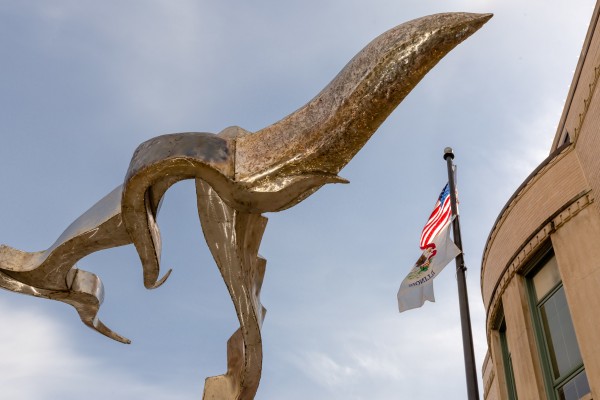
Stronger Than Before
May 7, 2020
While our community looks very different during the COVID-19 pandemic, we see hope and unity all around the greater Champaign County area. We know that because of our residents, our business owners, and our students that our community will come back stronger than before.
Read MoreStronger Than Before
May 7, 2020
While our community looks very different during the COVID-19 pandemic, we see hope and unity all around the greater Champaign County area. We know that because of our residents, our business owners, and our students that our community will come back stronger than before.
Read More
Support Local During COVID-19: Urbana's Market at the Square
May 1, 2020
Read about the new COVID-19 guidelines for shopping at Urbana's Market at the Square.
Read MoreSupport Local During COVID-19: Urbana's Market at the Square
May 1, 2020
Read about the new COVID-19 guidelines for shopping at Urbana's Market at the Square.
Read More
Support Local During COVID-19: Golf Courses
April 28, 2020
Read how local golf courses are adjusting their operations for the May 1 reopening under COVID-19 guidelines
Read MoreSupport Local During COVID-19: Golf Courses
April 28, 2020
Read how local golf courses are adjusting their operations for the May 1 reopening under COVID-19 guidelines
Read More
Support Local During COVID-19: Urbana Park District
April 22, 2020
Read how Urbana Park District is adjusting to COVID-19 regulations and adapting their services.
Read MoreSupport Local During COVID-19: Urbana Park District
April 22, 2020
Read how Urbana Park District is adjusting to COVID-19 regulations and adapting their services.
Read More
Support Local During the Coronavirus: Jenkins Catering
April 16, 2020
Read how Jenkins Catering is adjusting to COVID-19 regulations and adapting their services.
Read MoreSupport Local During the Coronavirus: Jenkins Catering
April 16, 2020
Read how Jenkins Catering is adjusting to COVID-19 regulations and adapting their services.
Read More
Support Local During the Coronavirus: Aikman Wildlife Adventure
April 14, 2020
Read about how Aikman Wildlife Adventure is adjusting its services during COVID-19 closures.
Read MoreSupport Local During the Coronavirus: Aikman Wildlife Adventure
April 14, 2020
Read about how Aikman Wildlife Adventure is adjusting its services during COVID-19 closures.
Read More
Support Local During the Coronavirus: Spurlock Museum
April 10, 2020
Read about how the Spurlock Museum is adjusting its services during COVID-19 closures.
Read MoreSupport Local During the Coronavirus: Spurlock Museum
April 10, 2020
Read about how the Spurlock Museum is adjusting its services during COVID-19 closures.
Read More
COVID-19 Activities: Public Art League Sculpture Scavenger Hunt
April 9, 2020
Take on this scavenger hunt featuring Public Art League Sculptures!
Read MoreCOVID-19 Activities: Public Art League Sculpture Scavenger Hunt
April 9, 2020
Take on this scavenger hunt featuring Public Art League Sculptures!
Read More
Supporting Local During Coronavirus: Dr. G's Brainworks
April 7, 2020
Find out how Dr. G's Brainworks can provide you with plenty to do and play during stay-at-home orders!
Read MoreSupporting Local During Coronavirus: Dr. G's Brainworks
April 7, 2020
Find out how Dr. G's Brainworks can provide you with plenty to do and play during stay-at-home orders!
Read More
Support Local During the Coronavirus: Champaign Park District
March 31, 2020
Read about how the Champaign Park District's new "We Challenge You" initiative and how its outdoor facilities can help you adjust during COVID-19 changes.
Read MoreSupport Local During the Coronavirus: Champaign Park District
March 31, 2020
Read about how the Champaign Park District's new "We Challenge You" initiative and how its outdoor facilities can help you adjust during COVID-19 changes.
Read More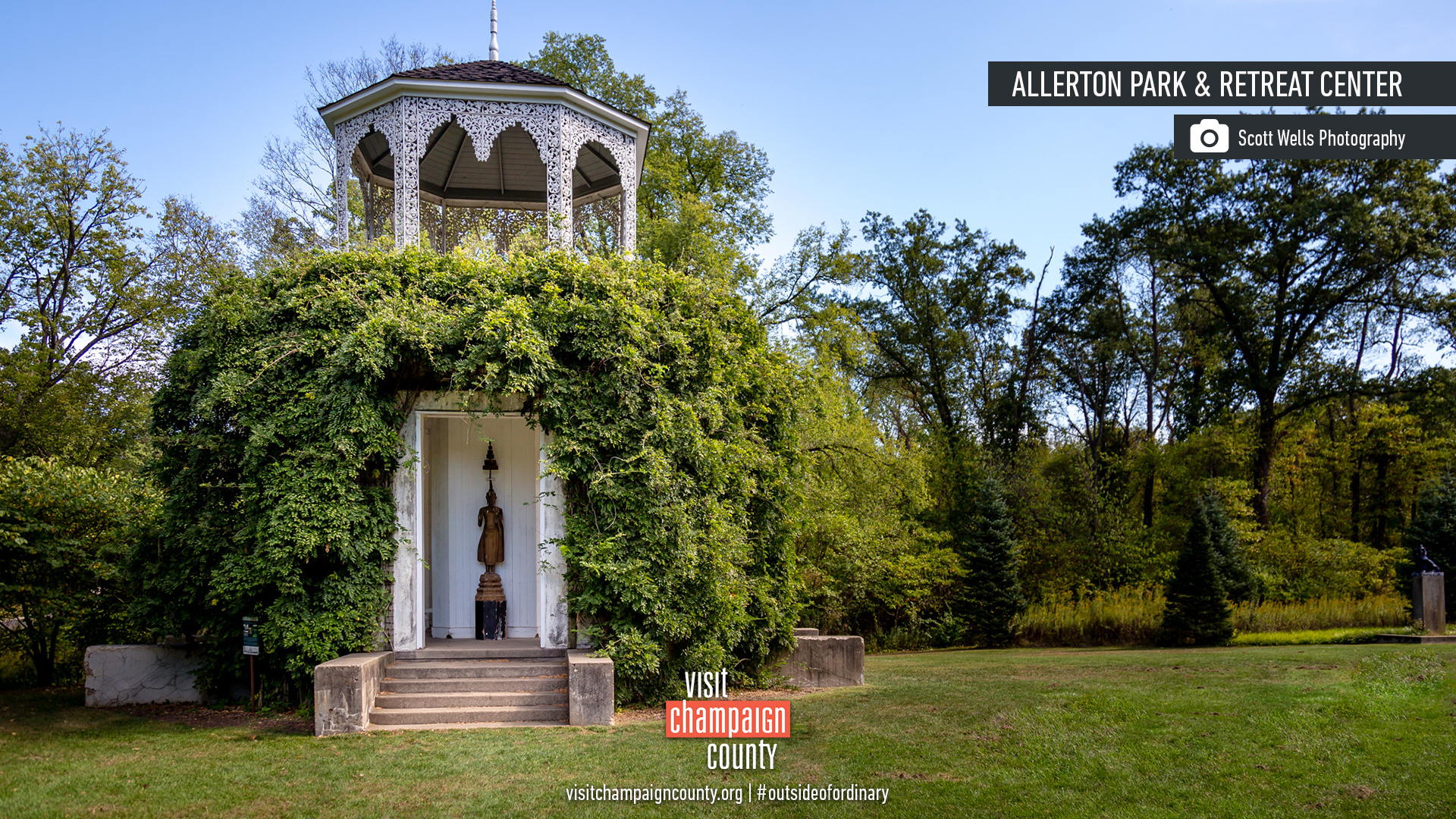
Miss the Champaign County Area Scenery? We've got Zoom Backgrounds for you!
March 31, 2020
Spending a lot of time on Zoom meetings? Bring a little bit of Champaign Conuty flair to the calls with these community backgrounds!
Read MoreMiss the Champaign County Area Scenery? We've got Zoom Backgrounds for you!
March 31, 2020
Spending a lot of time on Zoom meetings? Bring a little bit of Champaign Conuty flair to the calls with these community backgrounds!
Read More
Support Local During Coronavirus: Pandamonium Doughnuts
March 30, 2020
Find out how Pandamonium Doughnuts is changing the way they use their food truck and altering ordering in the wake of COVID-19.
Read MoreSupport Local During Coronavirus: Pandamonium Doughnuts
March 30, 2020
Find out how Pandamonium Doughnuts is changing the way they use their food truck and altering ordering in the wake of COVID-19.
Read More
Support Local During Coronavirus: Krannert Center for the Performing Arts
March 27, 2020
Read about how the Krannert Center for the Performing Arts is adjusting to COVID-19 closures.
Read MoreSupport Local During Coronavirus: Krannert Center for the Performing Arts
March 27, 2020
Read about how the Krannert Center for the Performing Arts is adjusting to COVID-19 closures.
Read More
Support Local During Coronavirus: Public Libraries
March 26, 2020
Read about how public libraries are adjusting their services during COVID-19 closures.
Read MoreSupport Local During Coronavirus: Public Libraries
March 26, 2020
Read about how public libraries are adjusting their services during COVID-19 closures.
Read More
Support Local During Coronavirus: Fiesta Café
March 25, 2020
Read about how Fiesta Café is adjusting to COVID-19 regulations, and how you can continue to support this local business.
Read MoreSupport Local During Coronavirus: Fiesta Café
March 25, 2020
Read about how Fiesta Café is adjusting to COVID-19 regulations, and how you can continue to support this local business.
Read More
Support Local During Coronavirus: Orpheum Children's Science Museum
March 23, 2020
Read about how the Orpheum Children's Science Museum is adjusting to COVID-19 regulations, and how you can continue to support this local business.
Read MoreSupport Local During Coronavirus: Orpheum Children's Science Museum
March 23, 2020
Read about how the Orpheum Children's Science Museum is adjusting to COVID-19 regulations, and how you can continue to support this local business.
Read More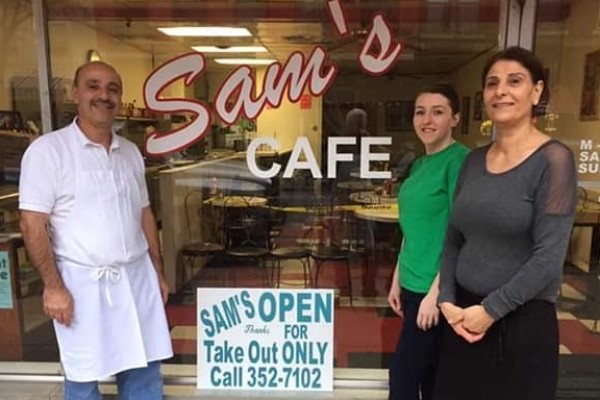
Support Local During the Coronavirus: Sam's Café
March 20, 2020
Read about how Sam's Cafe is adjusting to COVID-19 regulations, and how you can continue to support this local business.
Read MoreSupport Local During the Coronavirus: Sam's Café
March 20, 2020
Read about how Sam's Cafe is adjusting to COVID-19 regulations, and how you can continue to support this local business.
Read More
Support Local During the Coronavirus: Champaign County Forest Preserve District
March 18, 2020
Read about how the Champaign County Forest Preserve District and its outdoor facilities can help you adjust during COVID-19 changes.
Read MoreSupport Local During the Coronavirus: Champaign County Forest Preserve District
March 18, 2020
Read about how the Champaign County Forest Preserve District and its outdoor facilities can help you adjust during COVID-19 changes.
Read More
Supporting Local During the Coronavirus: Museum of the Grand Prairie
March 17, 2020
Read about how Mahomet's Museum of the Grand Prairie is adjusting to COVID-19 regulations, and how you can continue to support this local business.
Read MoreSupporting Local During the Coronavirus: Museum of the Grand Prairie
March 17, 2020
Read about how Mahomet's Museum of the Grand Prairie is adjusting to COVID-19 regulations, and how you can continue to support this local business.
Read More
Support Local During the Coronavirus: Hopscotch Bakery + Market
March 16, 2020
Read about how Champaign's Hopscotch Bakery + Market is adjusting to COVID-19 regulations, and how you can continue to support this local business.
Read MoreSupport Local During the Coronavirus: Hopscotch Bakery + Market
March 16, 2020
Read about how Champaign's Hopscotch Bakery + Market is adjusting to COVID-19 regulations, and how you can continue to support this local business.
Read More
Pie on the Mind for Pi Day (3/14)
March 10, 2020
Pi Day brings to mind one thing here at VCC: delicious, decedent pies! We’ll leave the math to students at Parkland and U of I, because today we’ve got local pie on the brain!
Read MorePie on the Mind for Pi Day (3/14)
March 10, 2020
Pi Day brings to mind one thing here at VCC: delicious, decedent pies! We’ll leave the math to students at Parkland and U of I, because today we’ve got local pie on the brain!
Read More
Living Outside of Ordinary: Week of 3/9
March 9, 2020
When we "Spring Forward", it's easy to really miss that extra hour! Make the most of the ones you do have by Living #OutsideofOrdinary!
Read MoreLiving Outside of Ordinary: Week of 3/9
March 9, 2020
When we "Spring Forward", it's easy to really miss that extra hour! Make the most of the ones you do have by Living #OutsideofOrdinary!
Read More
4 Top Activities for Summer
March 9, 2020
With warm weather upon us, it's time to explore the many safe summer activities available. Check out our top four recommendations for summer.
Read More4 Top Activities for Summer
March 9, 2020
With warm weather upon us, it's time to explore the many safe summer activities available. Check out our top four recommendations for summer.
Read More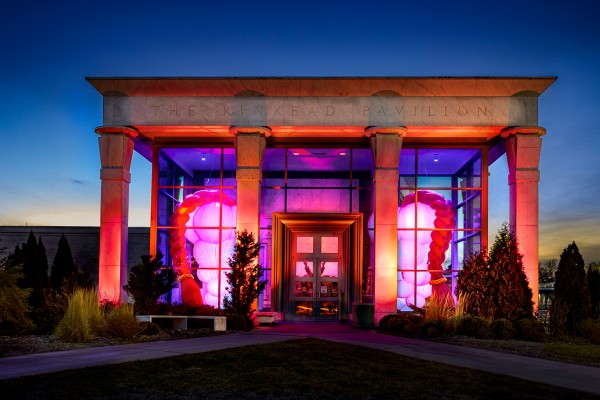
Art Lives Here
March 3, 2020
As you traverse the community, it becomes immediately clear that arts and culture are an integral part of the Champaign County area’s landscape. From public art to museums to events, local and national talent is on display all around you to discover. Here’s our top recommendations for integrating arts and culture into your visit to the greater Champaign County area.
Read MoreArt Lives Here
March 3, 2020
As you traverse the community, it becomes immediately clear that arts and culture are an integral part of the Champaign County area’s landscape. From public art to museums to events, local and national talent is on display all around you to discover. Here’s our top recommendations for integrating arts and culture into your visit to the greater Champaign County area.
Read More
Eat Fresh. Eat Local.
March 3, 2020
As you approach the greater Champaign County area from any direction, you’ll see miles of farmland overflowing with traditional crops such as corn, soy and wheat. Look harder, and you’ll find dozens of additional farms growing and raising food that sustain us year-round. We enjoy the bounty of these crops through on-farm experiences, markets, and authentic farm-to-table dining. Check out our suggestions for eating like a local, with all local ingredients.
Read MoreEat Fresh. Eat Local.
March 3, 2020
As you approach the greater Champaign County area from any direction, you’ll see miles of farmland overflowing with traditional crops such as corn, soy and wheat. Look harder, and you’ll find dozens of additional farms growing and raising food that sustain us year-round. We enjoy the bounty of these crops through on-farm experiences, markets, and authentic farm-to-table dining. Check out our suggestions for eating like a local, with all local ingredients.
Read More
Legends Play Here
March 2, 2020
Red Grange, Dick Butkus, Deon Thomas, Deron Williams, Mike Small, Tatianna McFadden—all legends that have trained and competed at the University of Illinois, Urbana-Champaign. Who will be the next legend to play in the greater Champaign County area?
Read MoreLegends Play Here
March 2, 2020
Red Grange, Dick Butkus, Deon Thomas, Deron Williams, Mike Small, Tatianna McFadden—all legends that have trained and competed at the University of Illinois, Urbana-Champaign. Who will be the next legend to play in the greater Champaign County area?
Read More
Living Outside of Ordinary: Week of 3/2
March 2, 2020
Make the first full week of March memorable with these seven #OutsideofOrdinary ideas!
Read MoreLiving Outside of Ordinary: Week of 3/2
March 2, 2020
Make the first full week of March memorable with these seven #OutsideofOrdinary ideas!
Read More
Making a Memorable Leap Day in Champaign County
February 27, 2020
Leap Day only comes once every four years. Seems like a perfect opportunity to do something Outside of Ordinary! Let's talk ways to make Leap Day memorable!
Read MoreMaking a Memorable Leap Day in Champaign County
February 27, 2020
Leap Day only comes once every four years. Seems like a perfect opportunity to do something Outside of Ordinary! Let's talk ways to make Leap Day memorable!
Read More
Fat Tuesday Festivities in Champaign County
February 24, 2020
Looking to get in on the Fat Tuesday fun? Here's a bit about the holiday, and a few ways to celebrate Fat Tuesday in Champaign County!
Read MoreFat Tuesday Festivities in Champaign County
February 24, 2020
Looking to get in on the Fat Tuesday fun? Here's a bit about the holiday, and a few ways to celebrate Fat Tuesday in Champaign County!
Read More
Living Outside of Ordinary: Week of 2/24
February 24, 2020
Get out of hibernation and check out seven Outside of Ordinary events and attractions this week!
Read MoreLiving Outside of Ordinary: Week of 2/24
February 24, 2020
Get out of hibernation and check out seven Outside of Ordinary events and attractions this week!
Read More
The Ultimate Guide to the IHSA Wrestling State Finals
February 18, 2020
If you're in town for the IHSA State Wrestling finals as a competitor, supporter, or fan of the sport, here are some ways to make Champaign-Urbana home during your visit!
Read MoreThe Ultimate Guide to the IHSA Wrestling State Finals
February 18, 2020
If you're in town for the IHSA State Wrestling finals as a competitor, supporter, or fan of the sport, here are some ways to make Champaign-Urbana home during your visit!
Read More
Top Picks for Outdoor Activities
February 14, 2020
Ready to get outdoors after a long winter? We have plenty of opportunities to have fun in our parks, forest preserves and natural areas. Check out our top picks for outdoor recreation.
Read MoreTop Picks for Outdoor Activities
February 14, 2020
Ready to get outdoors after a long winter? We have plenty of opportunities to have fun in our parks, forest preserves and natural areas. Check out our top picks for outdoor recreation.
Read More
Seasonal Gardens for Spring & Summer
February 14, 2020
As spring approaches and the signs of winter start to fade, wildflowers poke through the ground, shades of purple and pink appear in the earliest blooms, and cherry blossoms and lilacs abound, ripe for the picking. Gardens in all corners of the greater Champaign County area lie in wait for your senses to discover.
Read MoreSeasonal Gardens for Spring & Summer
February 14, 2020
As spring approaches and the signs of winter start to fade, wildflowers poke through the ground, shades of purple and pink appear in the earliest blooms, and cherry blossoms and lilacs abound, ripe for the picking. Gardens in all corners of the greater Champaign County area lie in wait for your senses to discover.
Read More
Speedskating Action in C-U: 3 Things to Know About Short Track Competition
February 13, 2020
If you're not sure what speedskating is, or the history of ice sports in our area, let's go over 5 things you might want to know about short track competition!
Read MoreSpeedskating Action in C-U: 3 Things to Know About Short Track Competition
February 13, 2020
If you're not sure what speedskating is, or the history of ice sports in our area, let's go over 5 things you might want to know about short track competition!
Read More
Valentine’s Day Ideas in Champaign County
February 11, 2020
Love is in the air, but there’s a catch: Valentine’s Day plans usually mean major stress. It’s tough finding things to do, and sometimes the usual dinner and gifts doesn’t quite cut it.
Read MoreValentine’s Day Ideas in Champaign County
February 11, 2020
Love is in the air, but there’s a catch: Valentine’s Day plans usually mean major stress. It’s tough finding things to do, and sometimes the usual dinner and gifts doesn’t quite cut it.
Read More
Living Outside of Ordinary: Week of 2/10
February 10, 2020
Love is in the air this week, and we’re all set to make this week #OutsideofOrdinary with seven fun activities and opportunities!
Read MoreLiving Outside of Ordinary: Week of 2/10
February 10, 2020
Love is in the air this week, and we’re all set to make this week #OutsideofOrdinary with seven fun activities and opportunities!
Read More
Ways to Celebrate Black History Month in Champaign County
January 30, 2020
If you’re looking for ways to celebrate Black History Month in Champaign County, we have a few ideas for you!
Read MoreWays to Celebrate Black History Month in Champaign County
January 30, 2020
If you’re looking for ways to celebrate Black History Month in Champaign County, we have a few ideas for you!
Read More
Living Outside of Ordinary: Week of 1/27
January 27, 2020
In a Restaurant Week edition of Living #OutsideofOrdinary, check out just 7 of the over 30 restaurants offering specials this week for breakfast, lunch, and dinner!
Read MoreLiving Outside of Ordinary: Week of 1/27
January 27, 2020
In a Restaurant Week edition of Living #OutsideofOrdinary, check out just 7 of the over 30 restaurants offering specials this week for breakfast, lunch, and dinner!
Read More
Living Outside of Ordinary: Week of 2/3
January 27, 2020
The first full week of February is already here! Take time to slow down 2020 before it gets away from you with these seven #OutsideofOrdinary activities!
Read MoreLiving Outside of Ordinary: Week of 2/3
January 27, 2020
The first full week of February is already here! Take time to slow down 2020 before it gets away from you with these seven #OutsideofOrdinary activities!
Read More
Five Amazing Attractions Outside of Champaign-Urbana
January 17, 2020
As you plan your 2020 adventures in our area, consider a visit to one of these five amazing attractions outside of Champaign-Urbana!
Read MoreFive Amazing Attractions Outside of Champaign-Urbana
January 17, 2020
As you plan your 2020 adventures in our area, consider a visit to one of these five amazing attractions outside of Champaign-Urbana!
Read More
Tuesday Trails with Terri: Frozen 5K Preview
January 14, 2020
With the Frozen 5K coming up on January 18, Terri went to Hessel Park to learn more about the race and check out the course!
Read MoreTuesday Trails with Terri: Frozen 5K Preview
January 14, 2020
With the Frozen 5K coming up on January 18, Terri went to Hessel Park to learn more about the race and check out the course!
Read More
Four Resolutions Worth Trying (And Keeping) in 2020
January 7, 2020
Let's be honest: some of our resolutions are already falling behind, and it's the second week of January! Here are four resolutions worth trying and keeping in 2020 in Champaign County.
Read MoreFour Resolutions Worth Trying (And Keeping) in 2020
January 7, 2020
Let's be honest: some of our resolutions are already falling behind, and it's the second week of January! Here are four resolutions worth trying and keeping in 2020 in Champaign County.
Read More
Tuesday Trails with Terri: University of Illinois Quads
January 7, 2020
For the first run of the decade, Terri visited the University of Illinois campus to run across the various Quads.
Read MoreTuesday Trails with Terri: University of Illinois Quads
January 7, 2020
For the first run of the decade, Terri visited the University of Illinois campus to run across the various Quads.
Read More
Living Outside of Ordinary: Week of 1/6
January 6, 2020
In our first Living Outside of Ordinary blog of the new year, we’re encouraging everyone to resolve not just to doing a few new things this year, but something exciting every single day.
Read MoreLiving Outside of Ordinary: Week of 1/6
January 6, 2020
In our first Living Outside of Ordinary blog of the new year, we’re encouraging everyone to resolve not just to doing a few new things this year, but something exciting every single day.
Read More
A Guide to Recreational Marijuana in Champaign County
January 3, 2020
Whether you live in Illinois or take a visit to our state, here’s an overview of the new marijuana laws and where to buy cannabis in Champaign County.
Read MoreA Guide to Recreational Marijuana in Champaign County
January 3, 2020
Whether you live in Illinois or take a visit to our state, here’s an overview of the new marijuana laws and where to buy cannabis in Champaign County.
Read More
5 Ways to Enjoy January in Champaign County
January 2, 2020
Winter blues? Not in Champaign County! Here are 5 ways to enjoy January, from seasonal fun runs to the return of Champaign County Area Restaurant Week!
Read More5 Ways to Enjoy January in Champaign County
January 2, 2020
Winter blues? Not in Champaign County! Here are 5 ways to enjoy January, from seasonal fun runs to the return of Champaign County Area Restaurant Week!
Read More
5 Fun Ways to Ring in the New Year
December 19, 2019
The final hours of 2019 are sure to be a blast with these 5 fun ways to celebrate the New Year!
Read More5 Fun Ways to Ring in the New Year
December 19, 2019
The final hours of 2019 are sure to be a blast with these 5 fun ways to celebrate the New Year!
Read More
Tuesday Trails with Terri: Santa 5K Preview
December 17, 2019
For the last Tuesday Trails of the decade, Terri went to St. Joseph to learn about the upcoming Santa 5K!
Read MoreTuesday Trails with Terri: Santa 5K Preview
December 17, 2019
For the last Tuesday Trails of the decade, Terri went to St. Joseph to learn about the upcoming Santa 5K!
Read More
Living Outside of Ordinary: Week of 12/16
December 16, 2019
Get into the holiday spirit this week with these seven ways to practice Living #OutsideofOrdinary!
Read MoreLiving Outside of Ordinary: Week of 12/16
December 16, 2019
Get into the holiday spirit this week with these seven ways to practice Living #OutsideofOrdinary!
Read More
Five Festive Photo Spots in Champaign County
December 12, 2019
If you’re planning to take some holiday photos for cards or to up your seasonal social media game, let’s talk about the five of the best places to visit this time of year in our area!
Read MoreFive Festive Photo Spots in Champaign County
December 12, 2019
If you’re planning to take some holiday photos for cards or to up your seasonal social media game, let’s talk about the five of the best places to visit this time of year in our area!
Read More
Santa Spotting in Champaign County: Week of December 9th
December 11, 2019
Another week, another set of opportunities to encounter Santa in Champaign County!
Read MoreSanta Spotting in Champaign County: Week of December 9th
December 11, 2019
Another week, another set of opportunities to encounter Santa in Champaign County!
Read More
Christmas Restaurant Openings in Champaign County
December 10, 2019
Whether you’re visiting the area, passing by, or a resident who is need of an open restaurant on Christmas Day we have you covered!
Read MoreChristmas Restaurant Openings in Champaign County
December 10, 2019
Whether you’re visiting the area, passing by, or a resident who is need of an open restaurant on Christmas Day we have you covered!
Read More
Tuesday Trails with Terri: Boneyard Basin & Greenway
December 10, 2019
Terri heads to Midtown and the Boneyard Basin on this sunny, but chilly day, to check out the views and see how it easy it is to get to Campustown.
Read MoreTuesday Trails with Terri: Boneyard Basin & Greenway
December 10, 2019
Terri heads to Midtown and the Boneyard Basin on this sunny, but chilly day, to check out the views and see how it easy it is to get to Campustown.
Read More
Living Outside of Ordinary: Week of 12/9
December 9, 2019
Bundle up, stay cozy as often as possible, and of course, find Outside of Ordinary ways to enjoy December in Champaign County!
Read MoreLiving Outside of Ordinary: Week of 12/9
December 9, 2019
Bundle up, stay cozy as often as possible, and of course, find Outside of Ordinary ways to enjoy December in Champaign County!
Read More
Santa Spotting in Champaign County: Week of December 2nd
December 4, 2019
Here’s where you can spot Santa in Champaign County this week, December 2nd-8th!
Read MoreSanta Spotting in Champaign County: Week of December 2nd
December 4, 2019
Here’s where you can spot Santa in Champaign County this week, December 2nd-8th!
Read More
Tuesday Trails with Terri: Japan House & Arboretum
December 3, 2019
Terri has her first after-Thanksgiving run at the Japan House and the Arboretum on the University of Illinois campus and finds tranquility.
Read MoreTuesday Trails with Terri: Japan House & Arboretum
December 3, 2019
Terri has her first after-Thanksgiving run at the Japan House and the Arboretum on the University of Illinois campus and finds tranquility.
Read More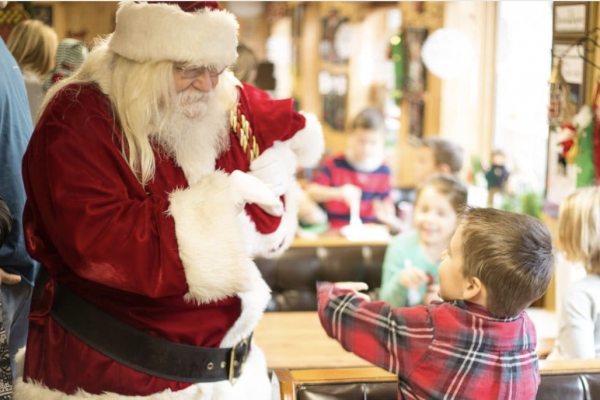
Living Outside of Ordinary: Week of 12/2
December 2, 2019
Thanksgiving is in the rear view mirror, with a lot of December fun to look forward to this week!
Read MoreLiving Outside of Ordinary: Week of 12/2
December 2, 2019
Thanksgiving is in the rear view mirror, with a lot of December fun to look forward to this week!
Read More
Tuesday Trails with Terri: Crystal Lake Park
November 26, 2019
Terri previews the 52nd annual Turkey Trot at Crystal Lake Park, a fun way to start your Thanksgiving so you can indulge in that turkey and pumpkin pie!
Read MoreTuesday Trails with Terri: Crystal Lake Park
November 26, 2019
Terri previews the 52nd annual Turkey Trot at Crystal Lake Park, a fun way to start your Thanksgiving so you can indulge in that turkey and pumpkin pie!
Read More
Living Outside of Ordinary: Week of 11/25
November 25, 2019
Happy Thanksgiving Week! On top of Turkey Day, there’s quite a bit happening in our area worth checking out!
Read MoreLiving Outside of Ordinary: Week of 11/25
November 25, 2019
Happy Thanksgiving Week! On top of Turkey Day, there’s quite a bit happening in our area worth checking out!
Read More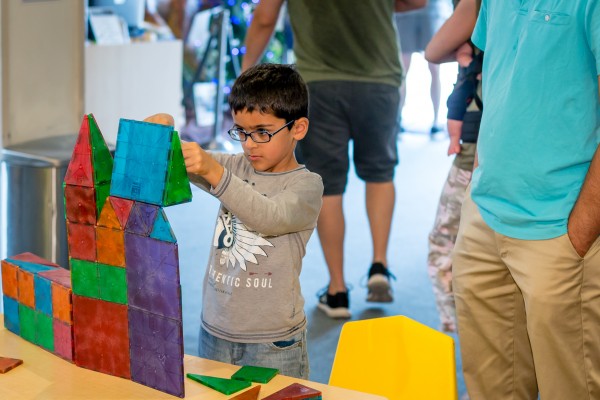
Five Ideas for Planning Family Activities
November 21, 2019
With so many options for things to do and places to see, we’ve got your next family activity plans covered!
Read MoreFive Ideas for Planning Family Activities
November 21, 2019
With so many options for things to do and places to see, we’ve got your next family activity plans covered!
Read More
Tuesday Trails with Terri: Mattis Park
November 19, 2019
After a week off due to the snow and ice, Terri is back on the trail. Today she took on Mattis Park and Boulware Trail in Champaign, where a few fall colors remained.
Read MoreTuesday Trails with Terri: Mattis Park
November 19, 2019
After a week off due to the snow and ice, Terri is back on the trail. Today she took on Mattis Park and Boulware Trail in Champaign, where a few fall colors remained.
Read More
Living Outside of Ordinary: Week of 11/18
November 18, 2019
If you’re getting anxious for the holiday season, you’ll be happy to see a few festive events trickling into our area this week!
Read MoreLiving Outside of Ordinary: Week of 11/18
November 18, 2019
If you’re getting anxious for the holiday season, you’ll be happy to see a few festive events trickling into our area this week!
Read More
Living Outside of Ordinary: Week of 11/11
November 11, 2019
This week, celebrate our international population in Champaign County, as well as a few #OutsideofOrdinary events to bridge the gap between fall and winter!
Read MoreLiving Outside of Ordinary: Week of 11/11
November 11, 2019
This week, celebrate our international population in Champaign County, as well as a few #OutsideofOrdinary events to bridge the gap between fall and winter!
Read More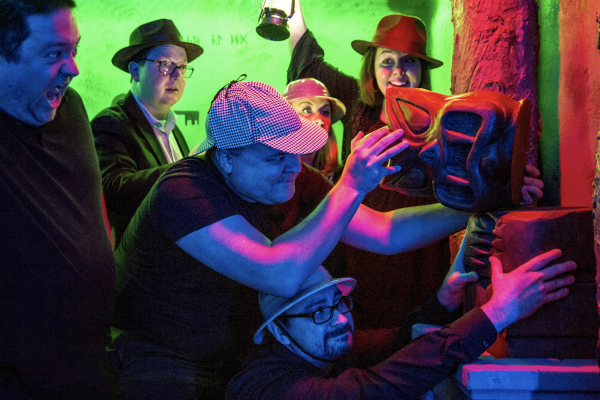
Cross These “I’ve Never’s” Off Your List
November 6, 2019
Every day is an opportunity to try something Outside of Ordinary and broaden your horizons. Cross a few things off your "I've Never" list this month!
Read MoreCross These “I’ve Never’s” Off Your List
November 6, 2019
Every day is an opportunity to try something Outside of Ordinary and broaden your horizons. Cross a few things off your "I've Never" list this month!
Read More
Tuesday Trails with Terri: Carle Park
November 5, 2019
This morning's run showcased the historic State streets in Urbana and Carle Park, just East of the University of Illinois campus, where fall continued to showcase its beauty.
Read MoreTuesday Trails with Terri: Carle Park
November 5, 2019
This morning's run showcased the historic State streets in Urbana and Carle Park, just East of the University of Illinois campus, where fall continued to showcase its beauty.
Read More
Living Outside of Ordinary: Week of 11/4
November 4, 2019
It's the first full week of November, so make sure to keep up with your Outside of Ordinary memory-making!
Read MoreLiving Outside of Ordinary: Week of 11/4
November 4, 2019
It's the first full week of November, so make sure to keep up with your Outside of Ordinary memory-making!
Read More
Looking Ahead: 8 Outside of Ordinary Events in November
November 1, 2019
Sometimes, by this point in the year, it’s hard to believe November is already here. With the snow we saw earlier this week, it’s a little more believable!
Read MoreLooking Ahead: 8 Outside of Ordinary Events in November
November 1, 2019
Sometimes, by this point in the year, it’s hard to believe November is already here. With the snow we saw earlier this week, it’s a little more believable!
Read More
Terri's Tuesday Trails: Heritage Park & Kaufman Lake
October 29, 2019
With cold temperatures creeping in, Terri bundled up for a morning run to check out the improvements to the Heritage Park trail before heading to Kaufman Lake.
Read MoreTerri's Tuesday Trails: Heritage Park & Kaufman Lake
October 29, 2019
With cold temperatures creeping in, Terri bundled up for a morning run to check out the improvements to the Heritage Park trail before heading to Kaufman Lake.
Read More
Living Outside of Ordinary: Week of 10/28
October 28, 2019
This week we say goodbye to October, and hello to 7 more ways to practice Living Outside of Ordinary!
Read MoreLiving Outside of Ordinary: Week of 10/28
October 28, 2019
This week we say goodbye to October, and hello to 7 more ways to practice Living Outside of Ordinary!
Read More
Terri's Tuesday Trails: Homer Lake Forest Preserve
October 22, 2019
Terri explored Homer Lake Forest Preserve on the East side of the county and caught some of the best fall foliage yet. Check out what she saw on today's run.
Read MoreTerri's Tuesday Trails: Homer Lake Forest Preserve
October 22, 2019
Terri explored Homer Lake Forest Preserve on the East side of the county and caught some of the best fall foliage yet. Check out what she saw on today's run.
Read More
Living Outside of Ordinary: Week of 10/21
October 21, 2019
Feeling the stress of fitting all the fun fall things into the end of October? We've got you covered.
Read MoreLiving Outside of Ordinary: Week of 10/21
October 21, 2019
Feeling the stress of fitting all the fun fall things into the end of October? We've got you covered.
Read More
CU Folk & Roots Festival: Can't Miss Shows and Full Schedule
October 18, 2019
Here are a few can’t miss shows, as well as a full lineup of all events associated with the CU Folk & Roots Festival
Read MoreCU Folk & Roots Festival: Can't Miss Shows and Full Schedule
October 18, 2019
Here are a few can’t miss shows, as well as a full lineup of all events associated with the CU Folk & Roots Festival
Read More
Halloween Events to Keep on the Calendar
October 17, 2019
We were working in the lab late one night, when our eyes beheld an eerie sight: a whole lot of spook-tacular Halloween events in our area!
Read MoreHalloween Events to Keep on the Calendar
October 17, 2019
We were working in the lab late one night, when our eyes beheld an eerie sight: a whole lot of spook-tacular Halloween events in our area!
Read More
Terri's Tuesday Trails: Meadowbrook Park
October 15, 2019
Terri's heads to Meadowbrook Park for an early morning run before the sun even rises. Check out her favorite spots along the way!
Read MoreTerri's Tuesday Trails: Meadowbrook Park
October 15, 2019
Terri's heads to Meadowbrook Park for an early morning run before the sun even rises. Check out her favorite spots along the way!
Read More
Living Outside of Ordinary: Week of 10/14
October 14, 2019
It's Homecoming Week for the University of Illinois, as well as another wonderful week for some Outside of Ordinary fall fun!
Read MoreLiving Outside of Ordinary: Week of 10/14
October 14, 2019
It's Homecoming Week for the University of Illinois, as well as another wonderful week for some Outside of Ordinary fall fun!
Read More
Terri's Tuesday Trails: Lake of the Woods
October 8, 2019
A perfect fall Tuesday morning to follow Terri along on her run at Lake of the Woods in Mahomet, where she watched the sunrise over the scenic botanical gardens.
Read MoreTerri's Tuesday Trails: Lake of the Woods
October 8, 2019
A perfect fall Tuesday morning to follow Terri along on her run at Lake of the Woods in Mahomet, where she watched the sunrise over the scenic botanical gardens.
Read More
Living Outside of Ordinary: Week of 10/7
October 7, 2019
We finally have fall weather in Champaign County! Celebrate by getting into the spirit of the season with Flannel Fest, U of I’s Homecoming kickoff, and more Outside of Ordinary events and activities!
Read MoreLiving Outside of Ordinary: Week of 10/7
October 7, 2019
We finally have fall weather in Champaign County! Celebrate by getting into the spirit of the season with Flannel Fest, U of I’s Homecoming kickoff, and more Outside of Ordinary events and activities!
Read More
Looking Ahead: 10 Outside of Ordinary Events in October
October 4, 2019
Get your calendars ready; here are 10 Outside of Ordinary events for October!
Read MoreLooking Ahead: 10 Outside of Ordinary Events in October
October 4, 2019
Get your calendars ready; here are 10 Outside of Ordinary events for October!
Read More
Tuesday Trails with Terri: Robeson Park
October 1, 2019
Terri heads to Robeson Park in Champaign to hit the trails this Tuesday. She is delighted by some scenic spots as she runs while the sun rises.
Read MoreTuesday Trails with Terri: Robeson Park
October 1, 2019
Terri heads to Robeson Park in Champaign to hit the trails this Tuesday. She is delighted by some scenic spots as she runs while the sun rises.
Read More
Living Outside of Ordinary: Week of 9/30
September 30, 2019
This week, we see the first day of October, plus more incredible annual events that always pop back up during the fall season. We want to hear from you: what’s your favorite fall activity in the greater Champaign County area?
Read MoreLiving Outside of Ordinary: Week of 9/30
September 30, 2019
This week, we see the first day of October, plus more incredible annual events that always pop back up during the fall season. We want to hear from you: what’s your favorite fall activity in the greater Champaign County area?
Read More
Pygmalion 2019 - Five Can’t Miss Events
September 25, 2019
It’s not very often a world class festival of arts, culture, and community takes place in your backyard. For the greater Champaign County area, it just so happens to take place every year.
Read MorePygmalion 2019 - Five Can’t Miss Events
September 25, 2019
It’s not very often a world class festival of arts, culture, and community takes place in your backyard. For the greater Champaign County area, it just so happens to take place every year.
Read More
Tuesday Trails with Terri
September 24, 2019
Terri promises to run 1 mile every Tuesday and share the landscape of her run. Follow along and tell her where she should run next!
Read MoreTuesday Trails with Terri
September 24, 2019
Terri promises to run 1 mile every Tuesday and share the landscape of her run. Follow along and tell her where she should run next!
Read More
Living Outside of Ordinary: Week of 9/23
September 23, 2019
It’s hard to get in the falling leaves and autumn adventure spirit when it’s still hot out, but try your best this week!
Read MoreLiving Outside of Ordinary: Week of 9/23
September 23, 2019
It’s hard to get in the falling leaves and autumn adventure spirit when it’s still hot out, but try your best this week!
Read More
Living Outside of Ordinary: Week of 9/16
September 16, 2019
Between one of the biggest days of the year in Monticello, a home game for the red hot Parkland Volleyball team, and a unique drone light show from U of I's Aerospace Engineering department, this week is shaping up to be as #OutsideofOrdinary as ever!
Read MoreLiving Outside of Ordinary: Week of 9/16
September 16, 2019
Between one of the biggest days of the year in Monticello, a home game for the red hot Parkland Volleyball team, and a unique drone light show from U of I's Aerospace Engineering department, this week is shaping up to be as #OutsideofOrdinary as ever!
Read More
Living Outside of Ordinary: Week of 9/9
September 9, 2019
September continues to bring fun annual events we look forward to all year long. Needless to say, there’s no shortage of #OutsideofOrdinary moments to be had!
Read MoreLiving Outside of Ordinary: Week of 9/9
September 9, 2019
September continues to bring fun annual events we look forward to all year long. Needless to say, there’s no shortage of #OutsideofOrdinary moments to be had!
Read More
Concert Calendar for September
September 6, 2019
It’s amazing month for music in the greater Champaign County area! Following ELLNORA, here are some concerts you can look forward to in the greater Champaign County area!
Read MoreConcert Calendar for September
September 6, 2019
It’s amazing month for music in the greater Champaign County area! Following ELLNORA, here are some concerts you can look forward to in the greater Champaign County area!
Read More
Matsuri 2019: Making the Most of This Year's Festival
September 4, 2019
With some new updates, returning favorites, and an ever-growing effort to expose the community to Asian culture, let’s take a look at what to expect from this year’s Matsuri Festival at the Japan House.
Read MoreMatsuri 2019: Making the Most of This Year's Festival
September 4, 2019
With some new updates, returning favorites, and an ever-growing effort to expose the community to Asian culture, let’s take a look at what to expect from this year’s Matsuri Festival at the Japan House.
Read More
Living Outside of Ordinary: Week of 9/2
August 30, 2019
A very happy Labor Day to everyone, and with the unusual week, hopefully you feel encouraged to get out of your comfort zone and do something a little Outside of Ordinary!
Read MoreLiving Outside of Ordinary: Week of 9/2
August 30, 2019
A very happy Labor Day to everyone, and with the unusual week, hopefully you feel encouraged to get out of your comfort zone and do something a little Outside of Ordinary!
Read More
ELLNORA | The Guitar Festival Preview
August 30, 2019
ELLNORA | The Guitar Festival consists of some of the world's most talented musicians all playing in one unique space: the Krannert Center for the Performing Arts. Read our guide to this Outside of Ordinary festival!
Read MoreELLNORA | The Guitar Festival Preview
August 30, 2019
ELLNORA | The Guitar Festival consists of some of the world's most talented musicians all playing in one unique space: the Krannert Center for the Performing Arts. Read our guide to this Outside of Ordinary festival!
Read More
Looking Ahead: 10 Outside of Ordinary Events in September
August 29, 2019
This time of year, there is an electricity in the air around the greater Champaign County area. Between fall festivals, community event, and arts and culture celebrations, there is so much to do in September!
Read MoreLooking Ahead: 10 Outside of Ordinary Events in September
August 29, 2019
This time of year, there is an electricity in the air around the greater Champaign County area. Between fall festivals, community event, and arts and culture celebrations, there is so much to do in September!
Read More
A Celebration of Fresh, Local Flavors
August 27, 2019
With some of the richest soil in the world, the greater Champaign County area has a bounty of fresh ingredients. Discover our top recommendations for eating local.
Read MoreA Celebration of Fresh, Local Flavors
August 27, 2019
With some of the richest soil in the world, the greater Champaign County area has a bounty of fresh ingredients. Discover our top recommendations for eating local.
Read More
Living Outside of Ordinary: Week of 8/26
August 26, 2019
The end of August brings a huge community event in Arthur, as well as the return of Illini Football, and many more hints that Fall isn’t far behind!
Read MoreLiving Outside of Ordinary: Week of 8/26
August 26, 2019
The end of August brings a huge community event in Arthur, as well as the return of Illini Football, and many more hints that Fall isn’t far behind!
Read More
Top 10 Must-Attend Festivals in Champaign County
August 22, 2019
The greater Champaign County area is a hotbed for festivals and events that are sure to give your Instagram followers FOMO. We’ve created a list of our top 10 festivals, featuring the best in music, culture and food, so you don’t miss out.
Read MoreTop 10 Must-Attend Festivals in Champaign County
August 22, 2019
The greater Champaign County area is a hotbed for festivals and events that are sure to give your Instagram followers FOMO. We’ve created a list of our top 10 festivals, featuring the best in music, culture and food, so you don’t miss out.
Read More
On a Dime: Family Activities
August 20, 2019
In the final entry of our On a Dime series, we’re taking a look at family activities for all ages!
Read MoreOn a Dime: Family Activities
August 20, 2019
In the final entry of our On a Dime series, we’re taking a look at family activities for all ages!
Read More
Living Outside of Ordinary: Week of 8/19
August 19, 2019
It's finally here: students return to our #OutsideofOrdinary community! Between Urbana Sweetcorn Festival and more end-of-summer events, it’s an exciting time to be in the greater Champaign County area!
Read MoreLiving Outside of Ordinary: Week of 8/19
August 19, 2019
It's finally here: students return to our #OutsideofOrdinary community! Between Urbana Sweetcorn Festival and more end-of-summer events, it’s an exciting time to be in the greater Champaign County area!
Read More
Amazing August Food Fests
August 15, 2019
Summer and food festivals: we challenge you to name a better combination! A ton of great end-of-summer food festivals happen all over the greater Champaign County area, and we want to make sure you have August all planned out!
Read MoreAmazing August Food Fests
August 15, 2019
Summer and food festivals: we challenge you to name a better combination! A ton of great end-of-summer food festivals happen all over the greater Champaign County area, and we want to make sure you have August all planned out!
Read More
On a Dime: Eating Out
August 14, 2019
There are some amazing deals around the greater Visit Champaign county area. If you know where to look, you can find amazing deals for any meal of the day, including food trucks, free kid’s meals, and more!
Read MoreOn a Dime: Eating Out
August 14, 2019
There are some amazing deals around the greater Visit Champaign county area. If you know where to look, you can find amazing deals for any meal of the day, including food trucks, free kid’s meals, and more!
Read More
Living Outside of Ordinary: Week of 8/12
August 12, 2019
A lot of great events take place this week, making it a wonderful week to practice Living Outside of Ordinary!
Read MoreLiving Outside of Ordinary: Week of 8/12
August 12, 2019
A lot of great events take place this week, making it a wonderful week to practice Living Outside of Ordinary!
Read More
August Concert Calendar in Champaign County
August 7, 2019
August is full of great shows in the greater Champaign County area! We wanted to give you a snapshot of concerts happening in our area, so check out our concert calendar for the month of August With each concert, you’ll find a link to tickets if applicable, as well as info on when, where, and what time!
Read MoreAugust Concert Calendar in Champaign County
August 7, 2019
August is full of great shows in the greater Champaign County area! We wanted to give you a snapshot of concerts happening in our area, so check out our concert calendar for the month of August With each concert, you’ll find a link to tickets if applicable, as well as info on when, where, and what time!
Read More
Tristen Brings Songwriting Talents to the Rose Bowl Tavern
August 6, 2019
Whether touring in Jenny Lewis’s Voyager band, collaborating and touring with artists like Vanessa Carlton and Robyn Hitchcock, or releasing three solo albums to critical acclaim, Tristen has been busy. That means a lot of time on the road, including a stop at the Rose Bowl Tavern in Urbana this Thursday.
Read MoreTristen Brings Songwriting Talents to the Rose Bowl Tavern
August 6, 2019
Whether touring in Jenny Lewis’s Voyager band, collaborating and touring with artists like Vanessa Carlton and Robyn Hitchcock, or releasing three solo albums to critical acclaim, Tristen has been busy. That means a lot of time on the road, including a stop at the Rose Bowl Tavern in Urbana this Thursday.
Read More
Living Outside of Ordinary: Week of 8/5
August 5, 2019
August is underway, and with ways to get outside, eat great local food, and more, this week is full of Outside of Ordinary opportunities!
Read MoreLiving Outside of Ordinary: Week of 8/5
August 5, 2019
August is underway, and with ways to get outside, eat great local food, and more, this week is full of Outside of Ordinary opportunities!
Read More
Looking Ahead: 10 Outside of Ordinary Events in August
July 30, 2019
August is upon us, so it’s time to look at some of the most highly anticipated events of the upcoming month!
Read MoreLooking Ahead: 10 Outside of Ordinary Events in August
July 30, 2019
August is upon us, so it’s time to look at some of the most highly anticipated events of the upcoming month!
Read More
Living Outside of Ordinary: Week of 7/29
July 29, 2019
We’re heading into a brand new month, so start things off by making things Outside of Ordinary!
Read MoreLiving Outside of Ordinary: Week of 7/29
July 29, 2019
We’re heading into a brand new month, so start things off by making things Outside of Ordinary!
Read More
Living Outside of Ordinary: Week of 7/22
July 22, 2019
This week, you can head to the Champaign County fair all week long! Plus, grab lunch at a local food hall, check out summer fun favorites, and as always, do whatever makes your week memorable!
Read MoreLiving Outside of Ordinary: Week of 7/22
July 22, 2019
This week, you can head to the Champaign County fair all week long! Plus, grab lunch at a local food hall, check out summer fun favorites, and as always, do whatever makes your week memorable!
Read More
2019 Champaign County Fair Guide
July 18, 2019
Curious about how to tackle the Champaign County Fair’s robust schedule of events and activities? We’ve got you covered with our 2019 Champaign County Fair Guide.
Read More2019 Champaign County Fair Guide
July 18, 2019
Curious about how to tackle the Champaign County Fair’s robust schedule of events and activities? We’ve got you covered with our 2019 Champaign County Fair Guide.
Read More
Living Outside of Ordinary: Week of 7/15
July 15, 2019
This week, aim to do something a bit out of your comfort zone! Whatever you do, make it Outside of Ordinary!
Read MoreLiving Outside of Ordinary: Week of 7/15
July 15, 2019
This week, aim to do something a bit out of your comfort zone! Whatever you do, make it Outside of Ordinary!
Read More
5 Must Try Brews at Midwest Beer Fest
July 10, 2019
Nick Rainey, General Manager at Barrelhouse 34, gave us the inside scoop on which beers to look out for this weekend at Midwest Beer Fest!
Read More5 Must Try Brews at Midwest Beer Fest
July 10, 2019
Nick Rainey, General Manager at Barrelhouse 34, gave us the inside scoop on which beers to look out for this weekend at Midwest Beer Fest!
Read More
Fight the Heat with Frozen Treats
July 9, 2019
It can be hard to keep cool when the humidity, sun, and temperature are all trying to outdo each other. Don’t sweat it! There are plenty of places in the greater Champaign County area to grab a frozen treat to fight the heat.
Read MoreFight the Heat with Frozen Treats
July 9, 2019
It can be hard to keep cool when the humidity, sun, and temperature are all trying to outdo each other. Don’t sweat it! There are plenty of places in the greater Champaign County area to grab a frozen treat to fight the heat.
Read More
Living Outside of Ordinary: Week of 7/8
July 8, 2019
Summer keeps on truckin’ along, and so do all the #OutsideofOrdinary things to do in the greater Champaign County area!
Read MoreLiving Outside of Ordinary: Week of 7/8
July 8, 2019
Summer keeps on truckin’ along, and so do all the #OutsideofOrdinary things to do in the greater Champaign County area!
Read More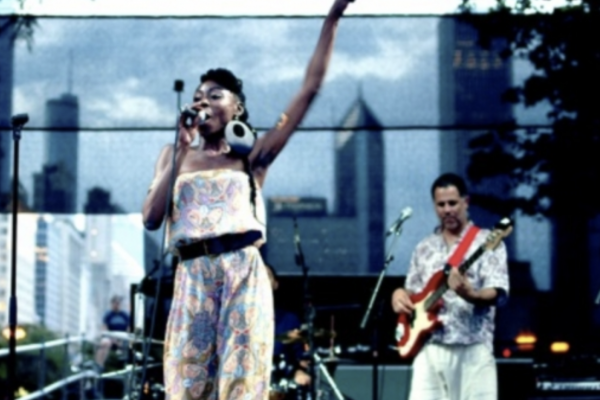
July Concert Calendar in Champaign County
July 3, 2019
We wanted to give you a snapshot of concerts happening in our area, so check out our concert calendar for the month of July.
Read MoreJuly Concert Calendar in Champaign County
July 3, 2019
We wanted to give you a snapshot of concerts happening in our area, so check out our concert calendar for the month of July.
Read More
Independence Week Fireworks in the Greater Champaign County Area
July 2, 2019
Curious about when to head out and catch fireworks? Luckily, there are lit skies to be seen Wednesday, Thursday, and Saturday in the greater Champaign County area.
Read MoreIndependence Week Fireworks in the Greater Champaign County Area
July 2, 2019
Curious about when to head out and catch fireworks? Luckily, there are lit skies to be seen Wednesday, Thursday, and Saturday in the greater Champaign County area.
Read More
Living Outside of Ordinary: Week of 7/1
July 1, 2019
The 4th is on everyone’s minds this week, but in the greater Champaign County area, there are ways to find things to do any day of the year!
Read MoreLiving Outside of Ordinary: Week of 7/1
July 1, 2019
The 4th is on everyone’s minds this week, but in the greater Champaign County area, there are ways to find things to do any day of the year!
Read More
Looking Ahead: 10 Outside of Ordinary Events in July
June 28, 2019
Fourth of July events will get their separate blog, but let's look at the rest of the month to come and see what Outside of Ordinary events there are to enjoy!
Read MoreLooking Ahead: 10 Outside of Ordinary Events in July
June 28, 2019
Fourth of July events will get their separate blog, but let's look at the rest of the month to come and see what Outside of Ordinary events there are to enjoy!
Read More
Champaign County Area Road Trip Guide: Monticello, Mahomet, and Rantoul
June 26, 2019
We've been detailing a few trips to take outside of Champaign-Urbana, and we wrap up this week with Monticello, Mahomet, and Rantoul!
Read MoreChampaign County Area Road Trip Guide: Monticello, Mahomet, and Rantoul
June 26, 2019
We've been detailing a few trips to take outside of Champaign-Urbana, and we wrap up this week with Monticello, Mahomet, and Rantoul!
Read More
Living Outside of Ordinary: Week of 6/24
June 24, 2019
Summer is in full swing, and it’s time to get out into every inch of our #OutsideofOrdinary community!
Read MoreLiving Outside of Ordinary: Week of 6/24
June 24, 2019
Summer is in full swing, and it’s time to get out into every inch of our #OutsideofOrdinary community!
Read More
Champaign County Area Road Trip Guide: Tuscola and Arthur
June 20, 2019
Nothing beats a great road trip, so let's look at some great opportunities awaiting in Tuscola and Arthur!
Read MoreChampaign County Area Road Trip Guide: Tuscola and Arthur
June 20, 2019
Nothing beats a great road trip, so let's look at some great opportunities awaiting in Tuscola and Arthur!
Read More
Music in the Air: Great Concerts in Our Area this Weekend
June 19, 2019
Here’s your guide to catching a live show this weekend! From international touring acts to local favorites, music is in the air this weekend!
Read MoreMusic in the Air: Great Concerts in Our Area this Weekend
June 19, 2019
Here’s your guide to catching a live show this weekend! From international touring acts to local favorites, music is in the air this weekend!
Read More
Living Outside of Ordinary: Week of 6/17
June 17, 2019
Cloudy Mondays don’t make for a dreary week when you’re Living #OutsideofOrdinary! Kick things off today with something outside of your normal routine.
Read MoreLiving Outside of Ordinary: Week of 6/17
June 17, 2019
Cloudy Mondays don’t make for a dreary week when you’re Living #OutsideofOrdinary! Kick things off today with something outside of your normal routine.
Read More
Champaign County Area Road Trip Guide: St. Joesph and Homer
June 12, 2019
Nothing beats a great road trip, and with so many things to see and do in St. Joe and Homer, plan a visit with this handy road trip guide!
Read MoreChampaign County Area Road Trip Guide: St. Joesph and Homer
June 12, 2019
Nothing beats a great road trip, and with so many things to see and do in St. Joe and Homer, plan a visit with this handy road trip guide!
Read More
Living Outside of Ordinary 6/10
June 10, 2019
This week, try Living #OutsideofOrdinary with some amazing opportunities to celebrate PRIDE, take a swim, and taste the best that Asia has to offer!
Read MoreLiving Outside of Ordinary 6/10
June 10, 2019
This week, try Living #OutsideofOrdinary with some amazing opportunities to celebrate PRIDE, take a swim, and taste the best that Asia has to offer!
Read More
5 Can’t Miss Events the First Weekend in June
June 7, 2019
The weekend is a great time to get out in the community and have some fun! Luckily, this weekend is stacked with fun events, summer festivals, and some Outside of Ordinary attractions that are sure to make this weekend a memorable one!
Read More5 Can’t Miss Events the First Weekend in June
June 7, 2019
The weekend is a great time to get out in the community and have some fun! Luckily, this weekend is stacked with fun events, summer festivals, and some Outside of Ordinary attractions that are sure to make this weekend a memorable one!
Read More
Celebrating LGBTQ+ Pride Month in Champaign County
June 5, 2019
If you’re looking to celebrate Pride Month in Champaign County, here are some great ways to do so, thanks to programming by the UP Center!
Read MoreCelebrating LGBTQ+ Pride Month in Champaign County
June 5, 2019
If you’re looking to celebrate Pride Month in Champaign County, here are some great ways to do so, thanks to programming by the UP Center!
Read More
Living Outside of Ordinary: Week of 6/3
June 3, 2019
June is finally here! The year is flying by, so slow things down with something a little #OutsideofOrdinary every day this week. A memory takes a moment to make!
Read MoreLiving Outside of Ordinary: Week of 6/3
June 3, 2019
June is finally here! The year is flying by, so slow things down with something a little #OutsideofOrdinary every day this week. A memory takes a moment to make!
Read More
Looking Ahead: 10 Outside of Ordinary Events in June
May 31, 2019
May is making way for June, and that means it’s time to look at the upcoming month and all of the Outside of Ordinary events to take advantage of in the greater Champaign County area!
Read MoreLooking Ahead: 10 Outside of Ordinary Events in June
May 31, 2019
May is making way for June, and that means it’s time to look at the upcoming month and all of the Outside of Ordinary events to take advantage of in the greater Champaign County area!
Read More
Museum May: Fun for the Whole Family
May 29, 2019
In the final entry of our blog series, Museum May, we turn our final entry to the various ways the CCMN is offering opportunities that prove to be fun for the whole family.
Read MoreMuseum May: Fun for the Whole Family
May 29, 2019
In the final entry of our blog series, Museum May, we turn our final entry to the various ways the CCMN is offering opportunities that prove to be fun for the whole family.
Read More
Living Outside of Ordinary: Week of 5/27
May 27, 2019
Happy Memorial Day! It’s a short week for some, and the start of summer for others. Even if your work week is unchanged, that doesn’t mean you can’t find a few ways to break the routine and Live #OutsideofOrdinary!
Read MoreLiving Outside of Ordinary: Week of 5/27
May 27, 2019
Happy Memorial Day! It’s a short week for some, and the start of summer for others. Even if your work week is unchanged, that doesn’t mean you can’t find a few ways to break the routine and Live #OutsideofOrdinary!
Read More
5 Ways to Make Memorial Day Weekend Memorable in Champaign County
May 24, 2019
There are a lot of fun things to do in the greater Champaign County area, but if you’re short on ideas, here are 5 ways to make Memorial Day weekend memorable in our area!
Read More5 Ways to Make Memorial Day Weekend Memorable in Champaign County
May 24, 2019
There are a lot of fun things to do in the greater Champaign County area, but if you’re short on ideas, here are 5 ways to make Memorial Day weekend memorable in our area!
Read More
Museum May: Nature Never Fails to Entertain
May 22, 2019
In the greater Champaign County area, nature never fails to entertain residents and visitors of all ages, and these CMNN summer programs and events are sure to be a hit!
Read MoreMuseum May: Nature Never Fails to Entertain
May 22, 2019
In the greater Champaign County area, nature never fails to entertain residents and visitors of all ages, and these CMNN summer programs and events are sure to be a hit!
Read More
Living Outside of Ordinary: Week of 5/20
May 20, 2019
Spring is here to stay, and you can tell! Not only is the weather warming up and staying there, but more and more seasonal community events are returning.
Read MoreLiving Outside of Ordinary: Week of 5/20
May 20, 2019
Spring is here to stay, and you can tell! Not only is the weather warming up and staying there, but more and more seasonal community events are returning.
Read More
Museum May: A Walk Through History
May 14, 2019
Two of our favorite area museums, Museum of the Grand Prairie and the Champaign County History Museum, have great programs and opportunities featured in the coming months.
Read MoreMuseum May: A Walk Through History
May 14, 2019
Two of our favorite area museums, Museum of the Grand Prairie and the Champaign County History Museum, have great programs and opportunities featured in the coming months.
Read More
Living Outside of Ordinary: Week of 5/13
May 13, 2019
Is this finally the week we get warm and stay there? Let’s hope so, because spring concerts and outdoor adventure are ramping up in the greater Champaign County area.
Read MoreLiving Outside of Ordinary: Week of 5/13
May 13, 2019
Is this finally the week we get warm and stay there? Let’s hope so, because spring concerts and outdoor adventure are ramping up in the greater Champaign County area.
Read More
5 Must-Sees and Shops in Arthur: Back Forty Market Edition
May 11, 2019
There are a ton of reasons to love Arthur, but if you haven’t been in awhile, the Back Forty Market is a great reason to visit again!
Read More5 Must-Sees and Shops in Arthur: Back Forty Market Edition
May 11, 2019
There are a ton of reasons to love Arthur, but if you haven’t been in awhile, the Back Forty Market is a great reason to visit again!
Read More
Plant Sales and Workshops to Check Out this Mother's Day Weekend
May 9, 2019
Feeling like going floral for Mother's Day this year? Here are some great events and opportunities in our area this weekend!
Read MorePlant Sales and Workshops to Check Out this Mother's Day Weekend
May 9, 2019
Feeling like going floral for Mother's Day this year? Here are some great events and opportunities in our area this weekend!
Read More
Living Outside of Ordinary: National Tourism and Travel Challenge
May 6, 2019
For National Tourism and Travel Week, we've put together a social media challenge to get you thinking about why Travel Matters!
Read MoreLiving Outside of Ordinary: National Tourism and Travel Challenge
May 6, 2019
For National Tourism and Travel Week, we've put together a social media challenge to get you thinking about why Travel Matters!
Read More
5 Instagram-able Areas in Champaign-Urbana
May 1, 2019
Looking for the perfect photo op for social media? These picture perfect spots in Champaign-Urbana are sure to go viral!
Read More5 Instagram-able Areas in Champaign-Urbana
May 1, 2019
Looking for the perfect photo op for social media? These picture perfect spots in Champaign-Urbana are sure to go viral!
Read More
Spend Some Time on the Farm
April 30, 2019
Farm life is unlike anything else. At Prairie Fruits Farm & Creamery, daily stresses and every day anxieties melt away.
Read MoreSpend Some Time on the Farm
April 30, 2019
Farm life is unlike anything else. At Prairie Fruits Farm & Creamery, daily stresses and every day anxieties melt away.
Read More
Top Things to Do in Champaign County for College Parents
April 18, 2019
If your kids attend the University of Illinois, you’re lucky, because the greater Champaign County area is filled with exciting attractions, great local restaurants and cultural experiences unique to this college town—and we’re going to share them with you.
Read MoreTop Things to Do in Champaign County for College Parents
April 18, 2019
If your kids attend the University of Illinois, you’re lucky, because the greater Champaign County area is filled with exciting attractions, great local restaurants and cultural experiences unique to this college town—and we’re going to share them with you.
Read More
36 Hours of Local Food in Champaign-Urbana
April 10, 2019
Fancy yourself a foodie? Then check out the ultimate, mouthwatering guide for 36 tasty hours of fresh, local flavors in the Champaign-Urbana area of eastern Illinois.
Read More36 Hours of Local Food in Champaign-Urbana
April 10, 2019
Fancy yourself a foodie? Then check out the ultimate, mouthwatering guide for 36 tasty hours of fresh, local flavors in the Champaign-Urbana area of eastern Illinois.
Read More
Krannert Center: 50 Years of Arts & Entertainment
April 5, 2019
Krannert's 50th is a great time to look back on the construction of the facility, and the culture surrounding this Outside of Ordinary arts resource in our community.
Read MoreKrannert Center: 50 Years of Arts & Entertainment
April 5, 2019
Krannert's 50th is a great time to look back on the construction of the facility, and the culture surrounding this Outside of Ordinary arts resource in our community.
Read More
Where the Music Never Stops
March 9, 2019
The saying “the music never stopped” reigns true when it comes to the sounds of the greater Champaign County area.
Read MoreWhere the Music Never Stops
March 9, 2019
The saying “the music never stopped” reigns true when it comes to the sounds of the greater Champaign County area.
Read More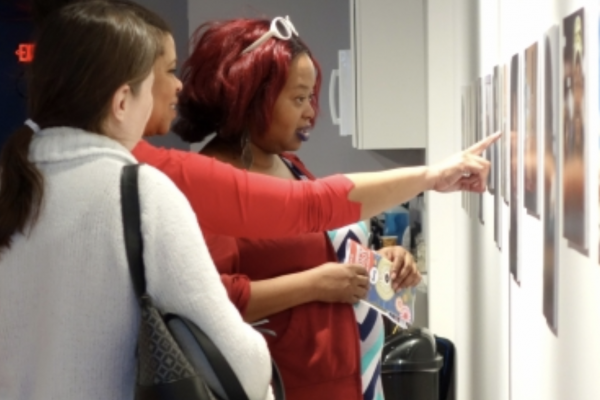
All About Arts & Culture
March 1, 2019
Here’s our top recommendations for integrating arts and culture into your visit to the greater Champaign County area.
Read MoreAll About Arts & Culture
March 1, 2019
Here’s our top recommendations for integrating arts and culture into your visit to the greater Champaign County area.
Read More
Top 8 Ideas for Your Girlfriends’ Getaway
February 6, 2019
Sometimes, the best getaway is one with your girlfriends, where you can escape the everyday stresses, let your hair down and explore with your best friends. We’ve assembled our top stops to help you plan an Outside of Ordinary girlfriends’ getaway!
Read MoreTop 8 Ideas for Your Girlfriends’ Getaway
February 6, 2019
Sometimes, the best getaway is one with your girlfriends, where you can escape the everyday stresses, let your hair down and explore with your best friends. We’ve assembled our top stops to help you plan an Outside of Ordinary girlfriends’ getaway!
Read More
Must-Stop Foodie Spots in Champaign County
January 29, 2019
Foodies, rejoice! We’ve created a mouthwatering guide to all things food in the Champaign-Urbana area.
Read MoreMust-Stop Foodie Spots in Champaign County
January 29, 2019
Foodies, rejoice! We’ve created a mouthwatering guide to all things food in the Champaign-Urbana area.
Read More
Christmas Restaurant Openings in Champaign County
December 12, 2018
Whether you’re hosting guests, staying around town, or just curious about what sort of menu to play as the holidays season continues, we hope this list of Christmas Day openings around the greater Champaign County area helps!
Read MoreChristmas Restaurant Openings in Champaign County
December 12, 2018
Whether you’re hosting guests, staying around town, or just curious about what sort of menu to play as the holidays season continues, we hope this list of Christmas Day openings around the greater Champaign County area helps!
Read More
Winter is Here. You Need a (Local) Beer
December 6, 2018
Summertime? Forget that, we are going to argue that WINTER is actually the perfect season for drinking a local craft beer.
Read MoreWinter is Here. You Need a (Local) Beer
December 6, 2018
Summertime? Forget that, we are going to argue that WINTER is actually the perfect season for drinking a local craft beer.
Read More
Shop Local Guide!
December 1, 2018
Show somebody that you think they’re Outside of Ordinary with a special gift from a local business! The greater Champaign County area is a hotbed for great local shopping, which makes it easy to check off every name of your list right here in our community!
Read MoreShop Local Guide!
December 1, 2018
Show somebody that you think they’re Outside of Ordinary with a special gift from a local business! The greater Champaign County area is a hotbed for great local shopping, which makes it easy to check off every name of your list right here in our community!
Read More
Thanksgiving Day Restaurant Openings
November 21, 2018
Thanksgiving is a busy day, and not just for those who are cooking! Here's a guide of places that you could grab a meal on Thanksgiving!
Read MoreThanksgiving Day Restaurant Openings
November 21, 2018
Thanksgiving is a busy day, and not just for those who are cooking! Here's a guide of places that you could grab a meal on Thanksgiving!
Read More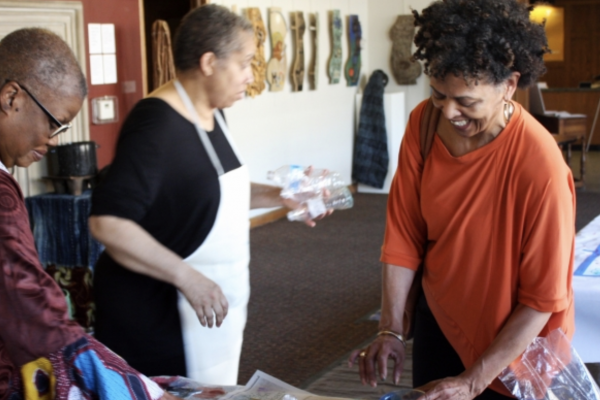
Boneyard Arts Festival: Our Tips to See ALL the Art
April 11, 2018
The Boneyard Arts Festival, presented by 40 North, the Champaign County Arts Council, is something entirely Outside of Ordinary. If this is your first time taking part in this event, we’re here to help you learn how to “Boneyard.”
Read MoreBoneyard Arts Festival: Our Tips to See ALL the Art
April 11, 2018
The Boneyard Arts Festival, presented by 40 North, the Champaign County Arts Council, is something entirely Outside of Ordinary. If this is your first time taking part in this event, we’re here to help you learn how to “Boneyard.”
Read More
